

How to Teach Narrative Writing for Kindergarten and First Grade: Step by Step
Narrative writing is often one of the first forms of writing kindergarten and first grade students do. This is because writing a personal narrative, or writing about our own experiences, is often less challenging than other form of writing. Still, teaching young children how to write narrative pieces can feel overwhelming. Here is how to introduce narrative writing step by step in a first grade or kindergarten classroom from a classroom teacher.
Are Your Students Ready for Narrative Writing?
Are your students ready to dive into narrative writing? Before you begin writing a personal narrative, it’s important to make sure your students are already comfortable with a few other things. Here are the things to teach before you dive into narrative writing.
- Letter sounds – Your students don’t need to know all of their letter sounds, but they need to know enough so they can easily sound out simple words . If your students can’t yet stretch and tap out some words, they are not ready for this type of narrative writing. Instead, it’s more important to focus on strengthening their letter sound, segmenting, and blending skills. This doesn’t mean they can’t draw a picture of a personal experience and have you write a caption for them (which is a valid form of narrative writing), but having them attempt to write their own sentences without a firm letter sound foundation is simply not a great use of time. So, make sure they have a solid letter sound foundation first.
- Illustrations- Although most students are comfortable drawing, we shouldn’t just assume that they are. Instead, it’s very helpful to take some time to discuss the importance of illustrations. (After all, illustrations enhance the story.) You can explore the illustrations in some favorite picture books, and even take some time to practice drawing different objects, people, and animals. The more details students can convey through their pictures, the easier it will be for them to use those illustrations to support their writing.
- Sentences – Lastly, before diving into narrative writing, it’s important to spend time teaching your students the basics of sentence writing . Do yourself (and their future teachers) a favor, and take at least a full week to develop their understanding of sentences. If you’re teaching first grade, you can even go a bit further if they’re ready for it. (Learn how to teach your students about basic sentences and going further with sen tences .)
Step 1: Introduce Beginning, Middle, and End with Mentor Texts

Okay, so now your students are ready to dive into personal narrative writing. The first step is to spend some time reading some mentor texts together. I personally prefer to read realistic fiction texts. Some of my favorites are Jabari Jumps , Jabari Tries , and Anything by Ezra Jack Keats (because who doesn’t love Peter!).
Discuss how every story has a beginning, middle, and end. Make an anchor chart together for students to refer to. Each time you read a story, have students retell the beginning, middle, and end. ( Read why mentor texts matter here. ) Taking the time to show them good narratives makes it so much easier for them to develop their own.
Step 2: Draw It Out

Once we’ve read and retold some narrative stories, it’s time to give it a try. Planning writing is so important, so we start there. First, talk about potential topics. I always tell my students to think about things they do often, such as what they do before and after school, on the weekends, or on special days like birthdays. Then, I model drawing a beginning middle, and end of a personal narrative. I talk through each step and we make sure that the series of events are consecutive and go together. This is where picking something that is routine can be helpful- such as getting ready for school. After I model, I have students draw their beginning middle, and end. If possible, it’s really helpful to allow them to pair up with a partner and tell about their pictures. This helps them find the words for their story.
Step 3: Label It

After they have drawn their beginning, middle, and end, I model labeling each of their pictures. We talk about how, when we label, we only need 1-2 words. This is helpful because typically writing a personal narrative will span over many days, so the picture and the label helps them (and me) remember what they’re writing.
When my students are labeling, I ask them to tap out their words and try their best with spelling. I do not spell words for them. This is because I am able to learn a lot about where they are in their literacy journey and understanding by what they can write on their own and how they can write it. For example, if a student writes “et” for eat versus “ete”, I know that the second child is aware that “et” is a short e so there needs to be something else that makes e say the long e sound.
Step 3. Write a First Draft

Once my students have labeled their pictures, I model how to write a first draft. I model looking at my picture and label and them using it to write a sentence. When we read narrative writing and create our anchor chart, we talk about using transition words like first, next, and last. We use these words when we retell the stories so they are already familiar and comfortable with them. So, we write first and then a sentence about our first picture. For example, “First I put on my shoes.” I model this for the beginning, middle, and end. One important thing is to add some mistakes in your writing. (This is important for step 5.) I tell my students that I am going to make some mistakes, and we don’t have to worry about them yet because this is just the first draft.
To start, I only ask them to write 3 sentences. One for the beginning, middle, and end. Although eventually we’ll work to writing a introduction and closing sentences, at first I keep it simple. I would much rather my students confidently write 3 sentences than push them to do more before they are ready.
Once I’ve modeled, I have my students write their draft. I will write the transition words on the board for them, or encourage them to look at the anchor chart. As they write each part, they check it off so they can make sure they include each one. Drafting typically takes a full day, sometimes too. Again, I do not spell words for my students at this stage. I want to see what they can do on their own. Plus, it is important for the next step.
Step 4: Editing Your Draft

After everyone has written their first draft, I introduce the idea of editing. Together, we create this anchor chart of the different editing marks. Then, we look back together at my first draft. We read each sentence together, and I let my students tell me what mistakes they see . I make sure to have at least one of every common mistake in my writing.
Once we’ve edited my writing, I show them how to rewrite my story to a final draft. We talk about going word by word so we don’t miss any important changes.
Step 4.5: Sit and Edit TOGETHER with Each Student
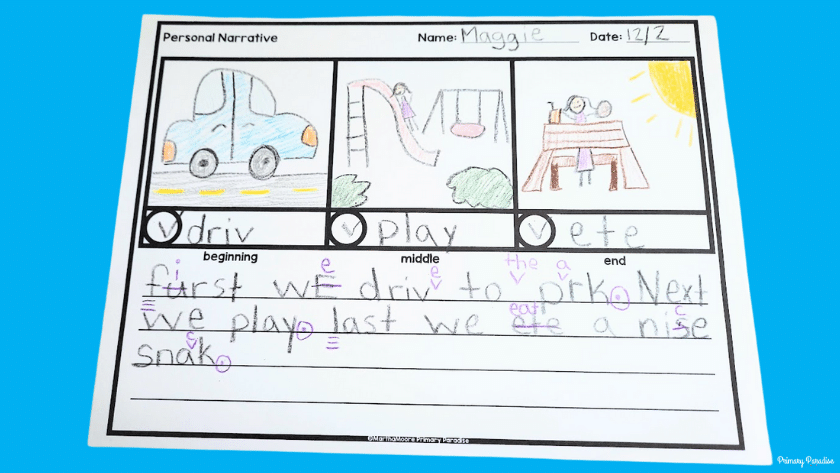
Once they have helped me edit my writing, I sit with each and every student and help them edit their story. I ask them to read me the story. This is important because I want to make sure they can understand and read what they wrote. After they read the whole thing, I make sure to compliment them on a few things they did really well. Then, we go through sentence by sentence and talk about what things we can fix. I make sure they understand why any changes need to be made. Once we’ve finished, I give them a paper to write their final draft on and they get started right away while it’s fresh in their mind.
If you’re wondering, yes, this takes a long time. Sitting one on one with 25 students takes many days. Sometimes a full week, but this is the most valuable time in the writing process because it gives me a window into where they are, gives me a chance to focus specifically on the areas the student needs, and allows me to encourage them in the areas they’re doing well. Often times, this turns into a one on one mini lesson on capitals, certain spelling patterns, punctuation, etc. It is time well spent, even if it means that it takes 3 full weeks to complete a writing piece.
If you’re also wondering what the other children are doing, that is a great question. It really varies, but typically I meet with students while the rest of the class is working on literacy centers . I also might work on editing writing when they’re working independently on their inquiry work or morning work . Really, any time is fair game. Any time I have a few minutes, I’ll grab a student to edit their writing.

A helpful tip: If your students struggle with tracking when they’re rewriting a rough draft to a final draft, this works like a charm. Cut a piece of construction paper in half, cut a little window, and that’s it! This allows them to only focus on 1-2 words at a time. As time goes on, you can make the window longer, if you want.
Step 5: Publishing and Celebrating

The final step is letting students enjoy the fruits of their labor! After they have all finished their final draft, we take time to share our writing. The first time, I typically have them partner up and share two stars and a wish . Long before we begin narrative writing, I like to share this video about Austin’s Butterfly with my students. It helps them understand the purpose and benefit of getting and giving feedback. We practice giving feedback often, so this is not a new thing for our class. After they share their writing with a partner, I ask willing students to share some of the stars and then some of the wishes they received.
As we continue, sometimes I ask students to share their writing in small groups, with the whole class, or sometimes on Seesaw for their parents. This step is so important, though, because it allows them to feel a great sense of completion and accomplishment.

I typically tape or staple the two drafts together so the students can see the progression of their work. They always love to see what they started with and where they ended up! They also enjoy checking off their self assessment when they’re finished.
Step 6: Going Further
You might be wondering, if or when we make more detailed changes. When I first introduce narrative writing, we stick to 3 sentences and just fixing surface errors. With the next writing piece, I encourage my students to add a topic sentence or more details. Each time we work on adding more and more until they have created a story with an introduction, beginning, middle, end and closing sentence. I also encourage them to expand their sentences and add more details. I would rather my students take it slow and really feel confident than to rush and their teacher next year to have to reteach all of this.
If you’d like the template that I use for personal narrative writing, you can find it in my free resource library for email subscribers . Click the picture below to find it. You can also read more about my year long writing curriculum here .

You might also enjoy:
3 Ways to Build Confidence in Your Developing Writers
Free At Home Parent’s Guide for Supporting Student Writing
Why Strong Sentence Skills Help Students Produce Better Writing
The Easy Way to Teach Students to Expand Sentences
Find me on Instagram , Facebook , Twitter , and Pinterest .
Join my FREE Facebook Club for k-2 teachers here .
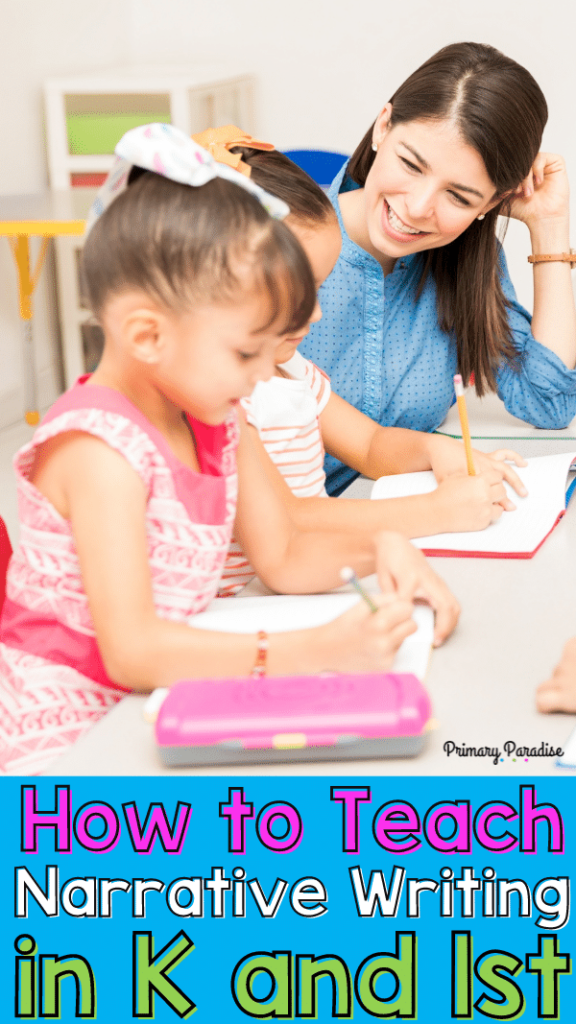
Primary Paradise
You may also like.
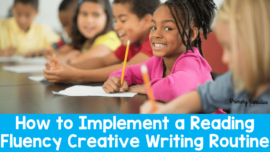
How to Implement a Reading Fluency Creative Writing Routine
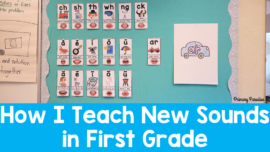
How I Teach a New Phonics Sound in First Grade
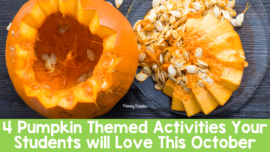
4 Pumpkin Themed Activities Your Students will Love This October
- Skip to content
- Skip to primary sidebar
- Skip to footer
Moffatt Girls
Hands-on learning made fun
July 11, 2020
Kindergarten Writing: Personal Narrative
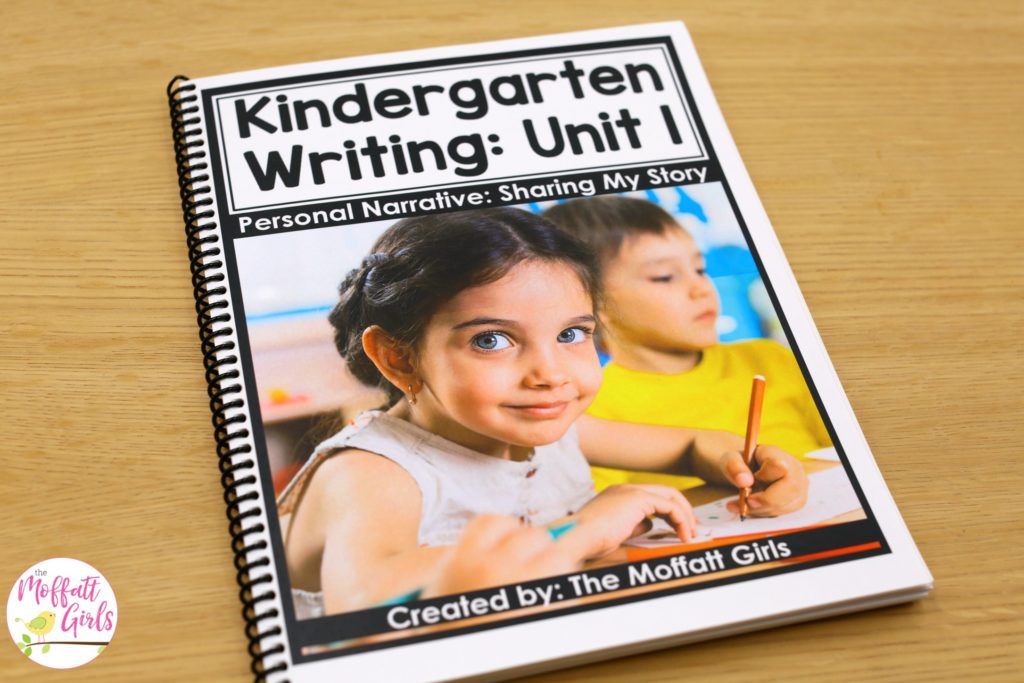
Teaching writing in kindergarten can be one of the most challenging aspects of teaching. In fact, this is the biggest struggle for many teachers in my private Facebook group. While we are talking about this struggle, let’s be honest: not all kids love to write. In like manner, children can struggle too! This is exactly why I have created the Kindergarten Writing Bundle! This easy to use curriculum has EVERYTHING you need to make writing successful in your classroom or homeschool! Simply put, my desire is for kids to learn to LOVE writing because they feel successful at it!
Fortunately, I think this curriculum hits the spot! I am SO excited to share this Kindergarten Writing Curriculum with you!

Kindergarten Writing Curriculum Scope:
There are a total of 7 units included in this comprehensive writing curriculum:
- Unit 1: Personal Narrative: Sharing My Story
- Unit 2: Non-Realistic Fiction: Using our Imagination
- Unit 3: Writing to Teach and Inform: How-to-Books
- Unit 4: Poetry: Exploring Poetry
- Unit 5: Realistic-Fiction: Writing Interesting Stories
- Unit 6: Opinion and Persuasive Writing: Changing the World
- Unit 7: Non-Fiction Chapter Books: Creating a Chapter Book
Let’s take a look at Unit 1 in the Kindergarten Writing Curriculum!
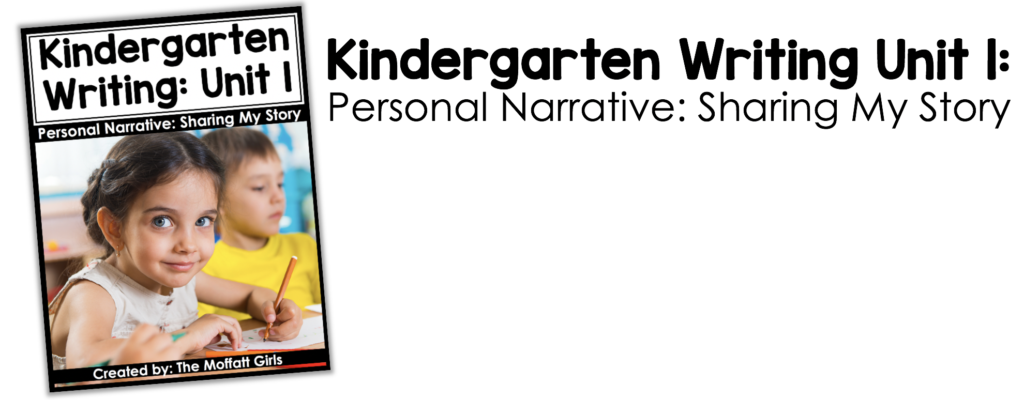
Teaching writing in Kindergarten can be one of the most exciting and rewarding experiences! They change and grow so much, even in the first weeks of school! Before you know it, you will see your students begin to blossom and grow as writers!
This Kindergarten Writing Curriculum uses a Writers Workshop type model. This means that there will be a mini-lesson, status updates (pre-writing, drafting, revising, editing, evaluating, or publishing), writing, and sharing! Don’t worry… I have you covered on how to effectively implement this curriculum in your classroom!
So when do you start teaching writing in Kindergarten? Good question! Right away! You can get this curriculum up and running during the first or second week of school! Luckily, you don’t need to wait until students know a certain number or sight words or letters. During Unit 1, we are not expecting them to write sentences….yet! Instead, in Unit 1 we will help students understand that their drawings/illustrations tell a story. Consider all of the wordless picture books you have “read.” You can certainly understand the storyline in those books. Allowing students to draw pictures and orally tell their story will show them that they too are authors!
*Side note: If you are looking for fun ways to teach the alphabet, click here . For fun phonics activities, click here .
What is Included In Unit 1: Personal Narrative?
- 22 Detailed Lesson Plans
- Suggested Schedule for (60, 45, and 30 minute blocks)
- Tips for Getting Started
- Curriculum Scope and Unit Scopes
- Developmental Writing Stages Chart
- Mentor Text Guides
- Conferencing Guides, Planners, and Trackers
- Assessments Guides
- Writing Templates
- Publishing Party Guide and Templates
- Writing Posters
- Personal Word Wall
- Writer’s Checklist
- Personal Narrative Writing Idea Charts
- The Writing Process Poster
- Young Author Award Certificate
Let’s start with the Lesson Plans!
These easy-to-follow lesson plans set you up for success. They are broken up into 6 simple parts:
Focus- The skill, strategy, or idea students will be focusing on this lesson.
Warm Up- A quick activity that has students review and practice previous skills.
Mini Lesson- Teach, model, and discuss the new skill in today’s lesson.
Practice- The hands-on portion of the lesson where students apply what they have learned in the mini lesson to their own writing. During this time you will conference individually with students.
Mid-Practice Teaching Point- A quick reminder and chance to highlight the great work students are doing.
Share- Lesson wrap up where students analyze, reflect on, and share their work.
I have also laid out what a lesson might look like with a 60 minute , 45 minute , and 30 minute time block . We all have different schedules, and this writing curriculum is designed to meet your needs! Do what works best for YOU!
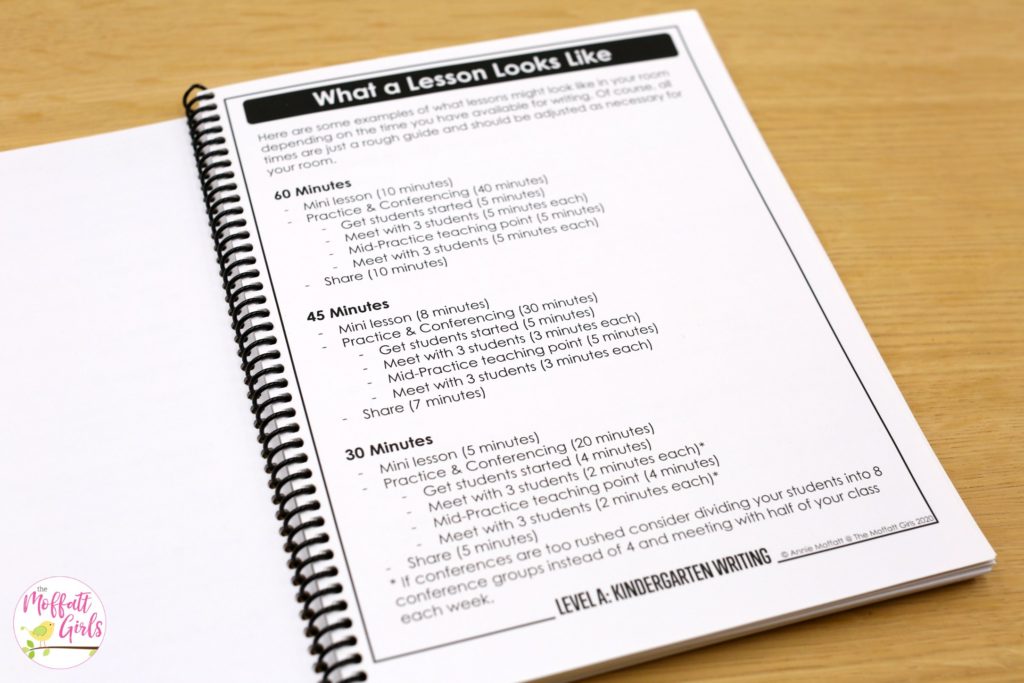
Also included are some tips for getting started! With this cohesive curriculum, I have set you up for success! All the work has been done for you. Just print out your materials and open up your lesson plans! Of course you will want to monitor students progress, and change your plans appropriately.
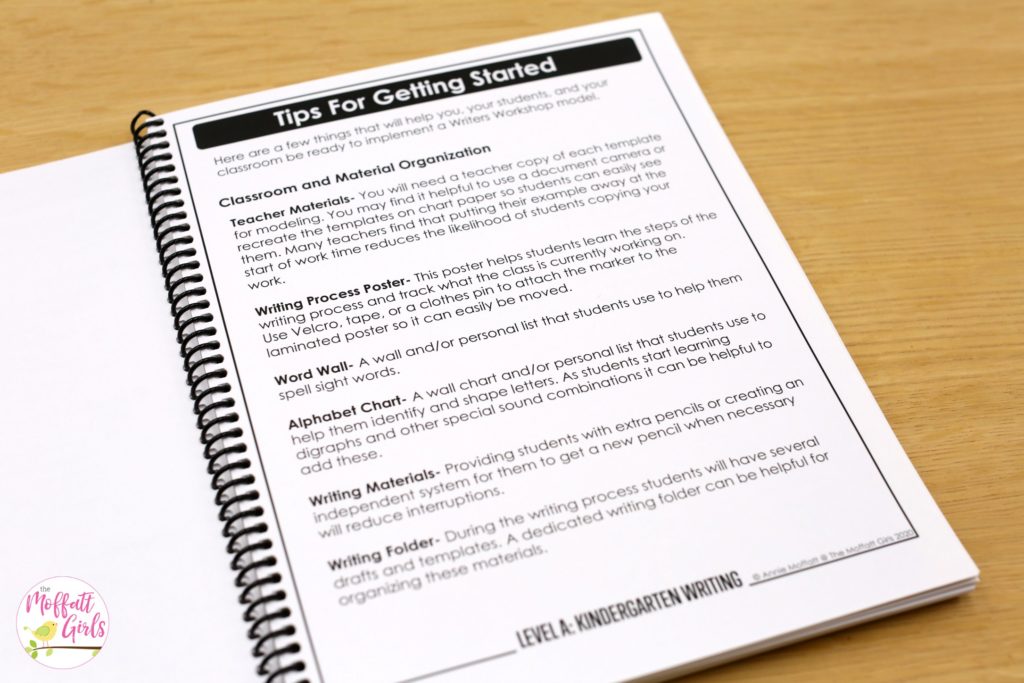
Here are a few things that will help you, your students, and your classroom be ready to implement a Writers Workshop model.
Things to keep on-hand:
Teacher Materials- You will need a teacher copy of each template for modeling. You may find it helpful to use a document camera or recreate the templates on chart paper so students can easily see them. Many teachers find that putting their example away at the start of work time reduces the likelihood of students copying your work.
Writing Process Poster- This poster helps students learn the steps of the writing process and track what the class is currently working on.
Use Velcro, tape, or a clothes pin to attach the marker to the laminated poster so it can easily be moved.
Word Wall- A wall and/or personal list that students use to help them spell sight words.
Alphabet Chart- A wall chart and/or personal list that students use to help them identify and shape letters. As students start learning digraphs and other special sound combinations it can be helpful to add these.
Writing Materials- Providing students with extra pencils or creating an independent system for them to get a new pencil when necessary will reduce interruptions.
Writing Folder- During the writing process students will have several drafts and templates. A dedicated writing folder can be helpful for organizing these materials. I’ve included a cover that you can personalize to add to the front of each writing folder.
Kindergarten Personal Narrative: Unit 1 Scope:
22 detailed lesson plans that will walk you through how to teach a personal narrative! By the end of the unit, your students will have written 3 personal narratives, and will be ready to move onto Unit 2!
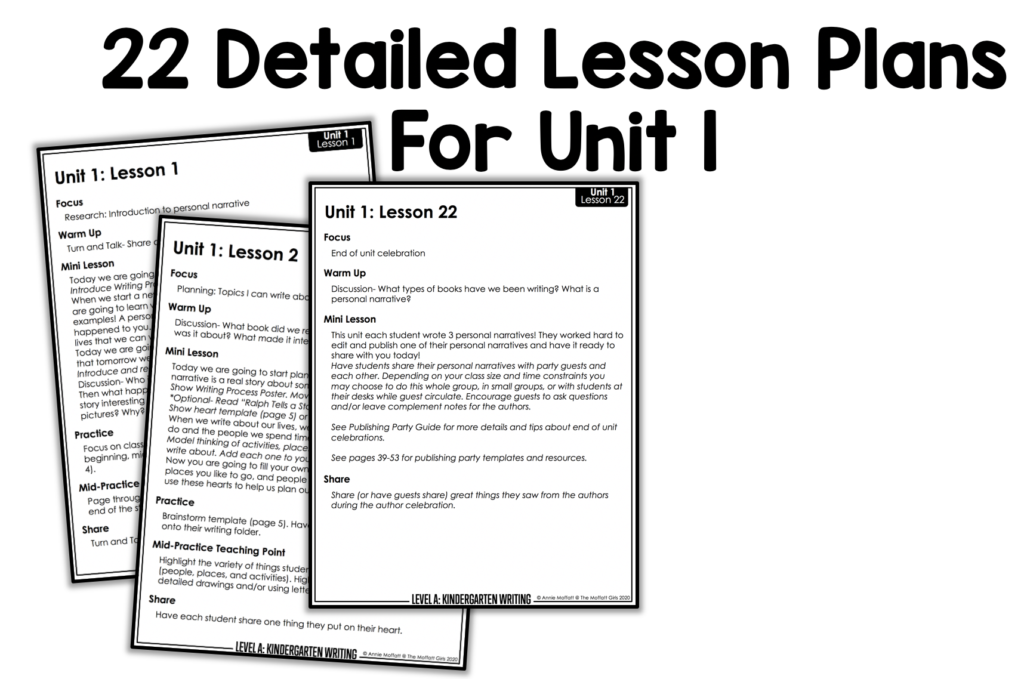
In order to make your writing block effective, be sure to implement procedures and plan out your routines and expectations. Get your materials set up and provide students with a writing folder. Be sure to model, model, model!
Organization:
Each child will get his/her own writing folder. This folder will be the place where they keep all of their writing templates, charts, and materials.
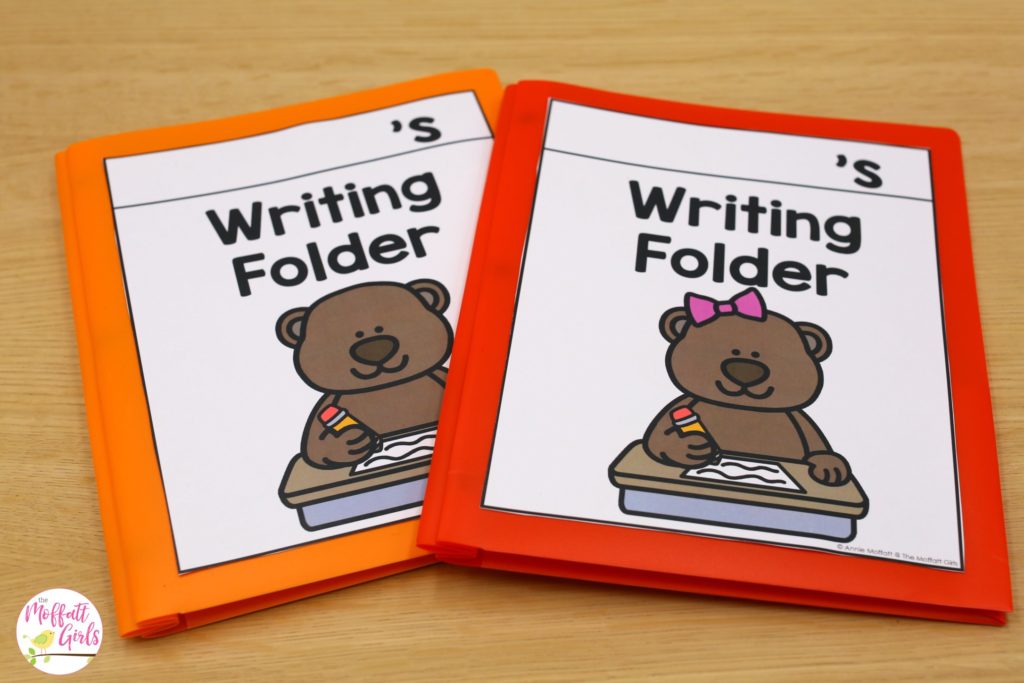
Inside of each folder, you can include the Alphabet Sound Chart, the Letter Chart, Letter Formation Chart and any other resources about the unit.
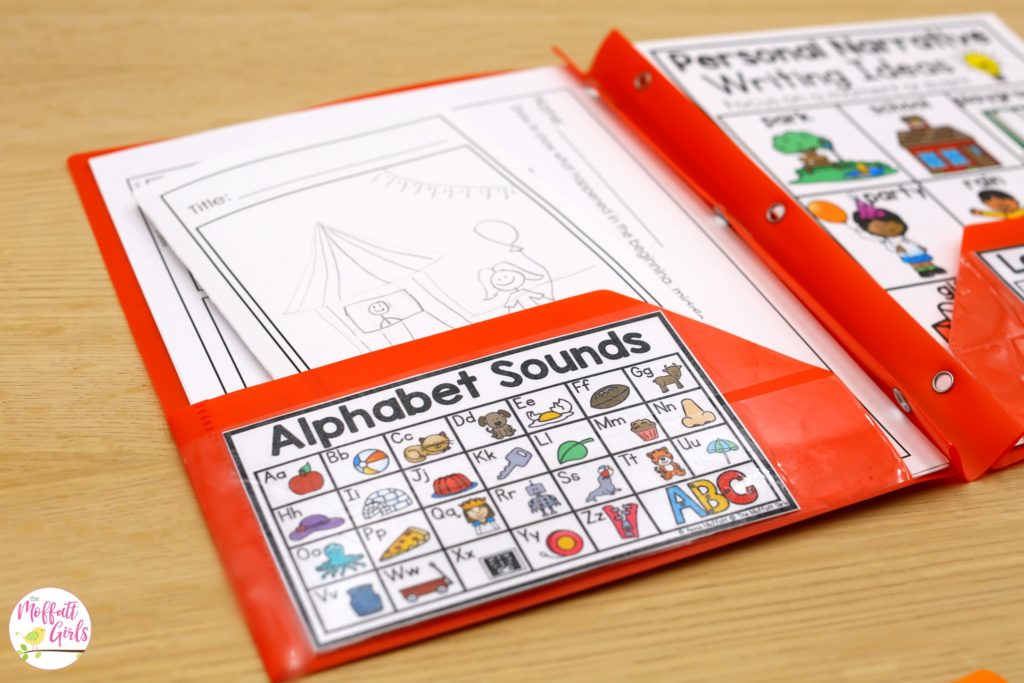
Included in the files are pencil labels…
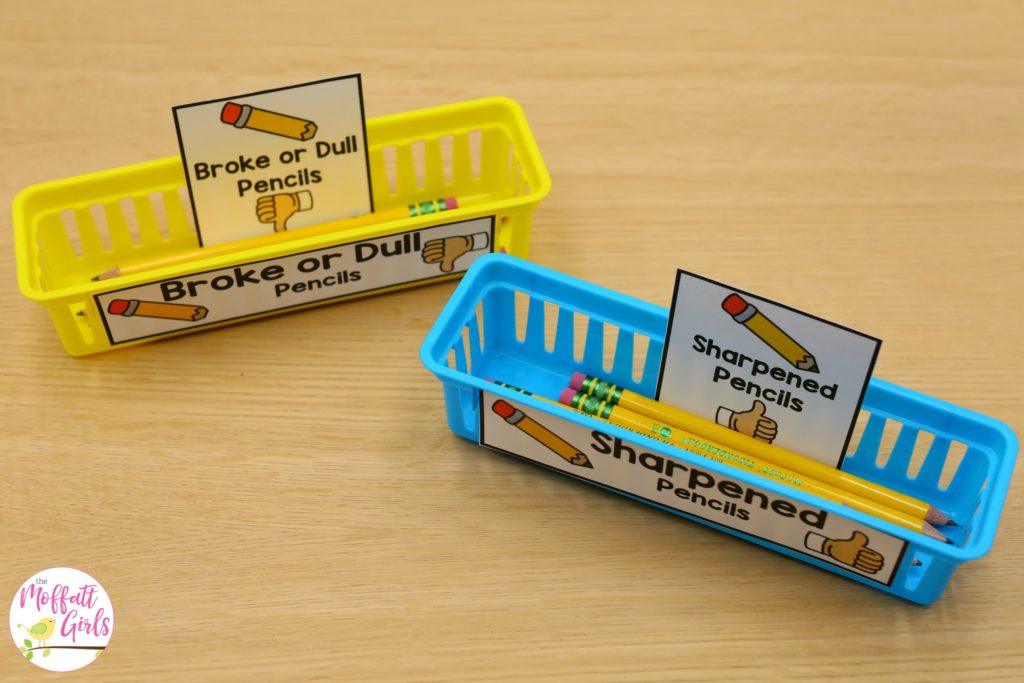
Mentor Texts:
Mentor texts are an important component to each unit in the Writing Curriculum. What are Mentor Texts? Mentor text(s) are 1-2 example texts that illustrate the writing style we are focusing on for the unit.
For the Kindergarten Personal Narrative, here are some examples of mentor texts you can use:
- “Fireflies” by Julie Brinckloe
- “Kitchen Dance” by MaurieJ. Manning
- “Shortcut” by Donald Crews
- “Hello Ocean” by Pam Munoz and Mark Astrella
- “New Shoes” by Chris Raschka
- “The Leaving Morning” by Angela Johnson
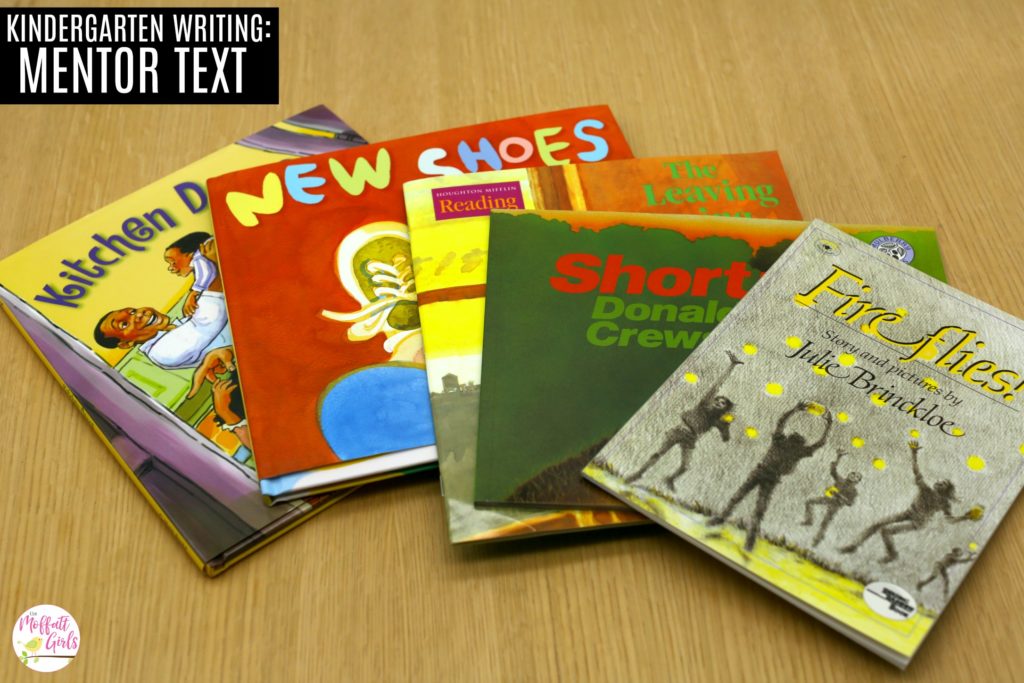
In Lesson 1 , we introduce mentor texts. Discussion- Who is the main character? What happened to them first? Then what happened? What happened at the end? What makes this story interesting to read? Would this story be as interesting without the pictures? Why?
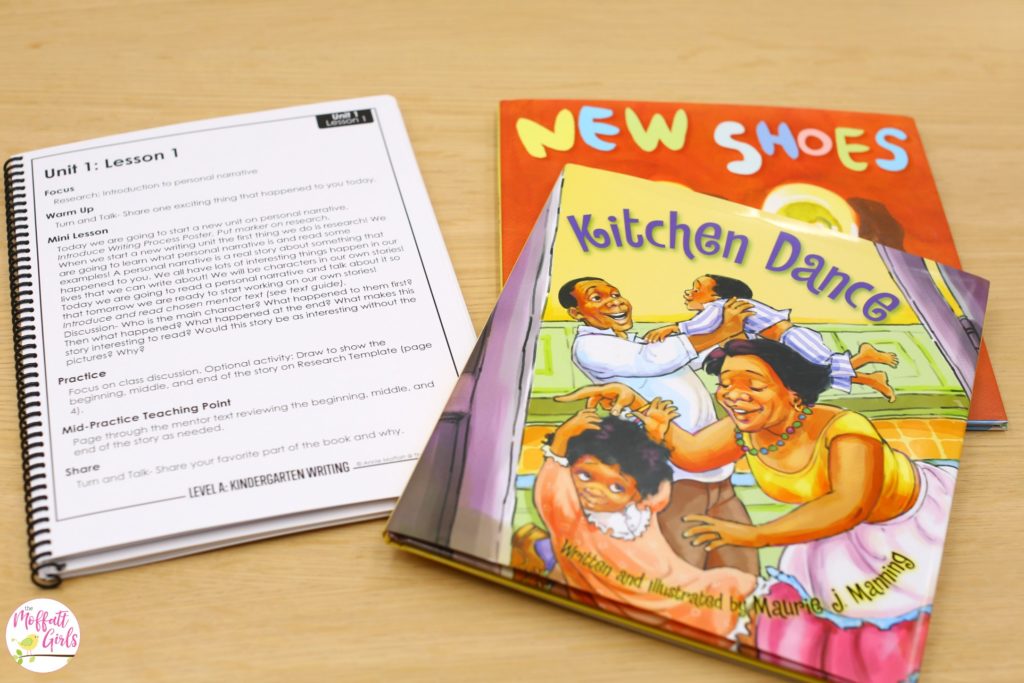
The mentor texts will be part of your Writers Library.
Writers Library
A Writers Library is a larger collection of on-topic texts that students can read and reference throughout the unit. Consider keeping these books in a special location where students can access them throughout the unit.
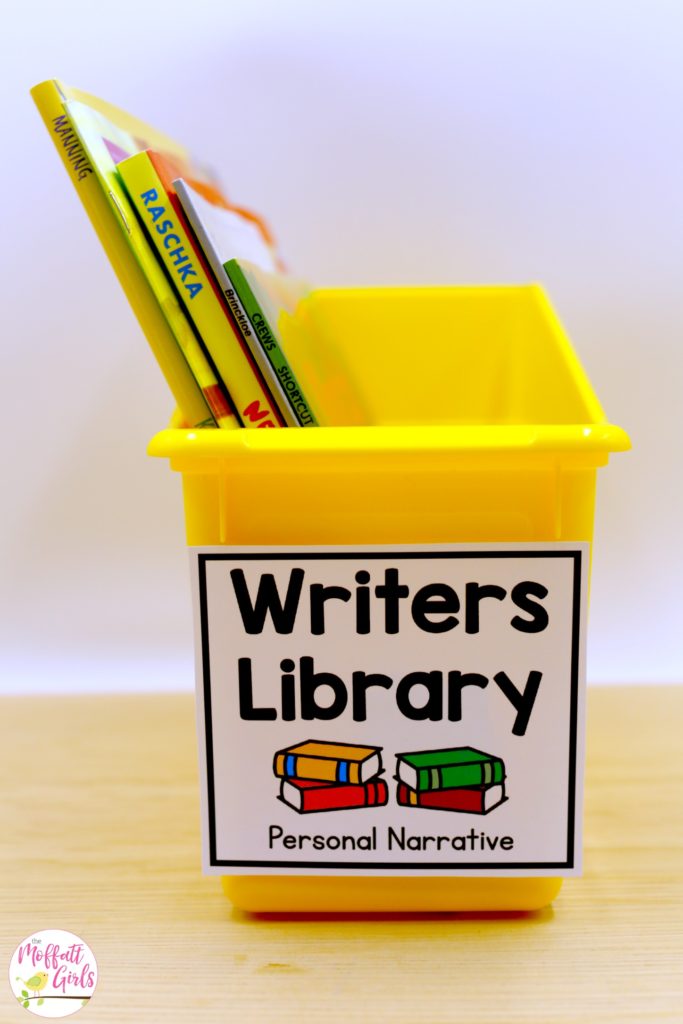
“Ralph Tells a Story” by Abby Hanlon is a great way to introduce students to the idea of being a writer. This is a story about a boy named Ralph who thinks he can’t write a story. Consider using it in Lesson 2 to help students start brainstorming ideas of things they can write about.
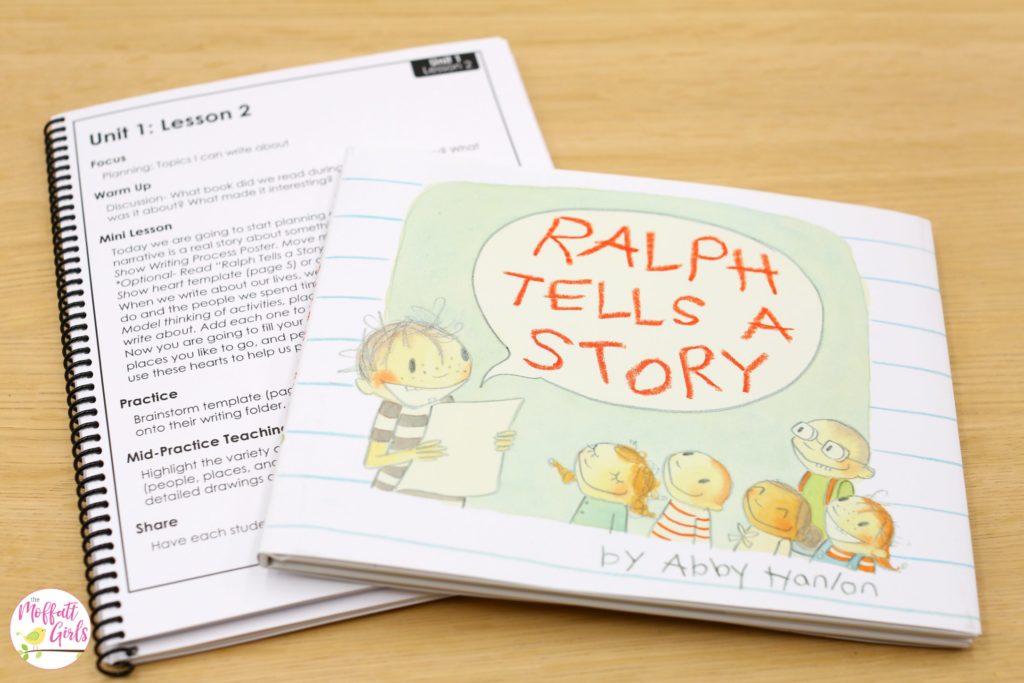
Planning Stage:
During Lesson 2 , students will start planning their narratives. They will complete fill in their own heart with things they like to do, places they like to go, and people they like to spend time with! Students will use these hearts to help plan their writing.
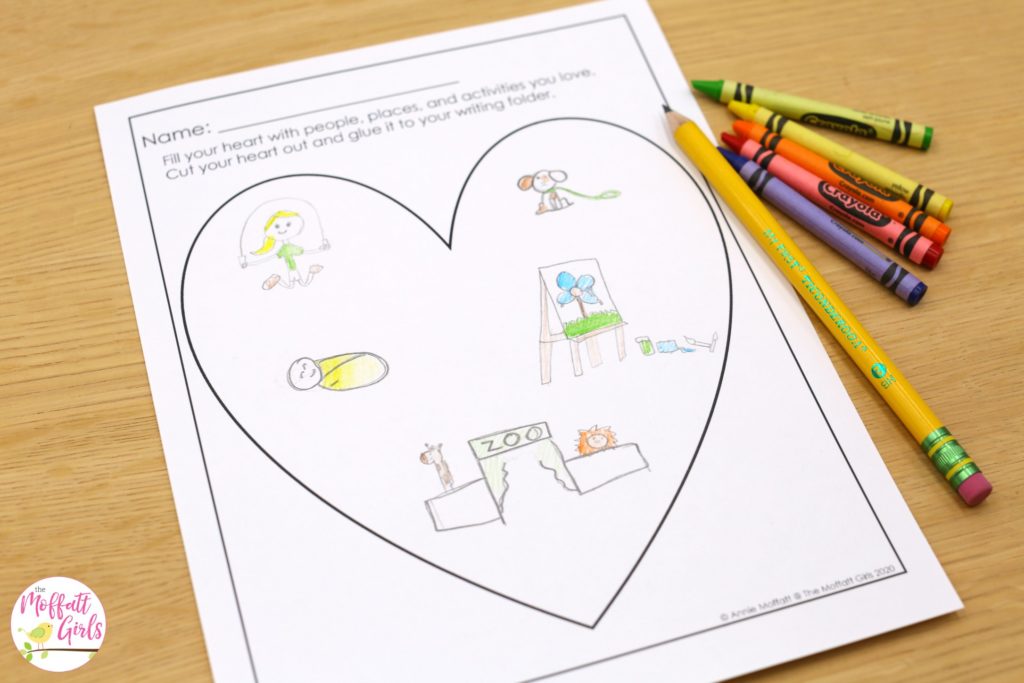
Students will be reminded that they are focusing on a “small moment.” Maybe they went camping, but we don’t want them to tell about their entire camping experience. Rather, we want them to focus on a “small moment.” Maybe they tell about the fish they caught in the stream.
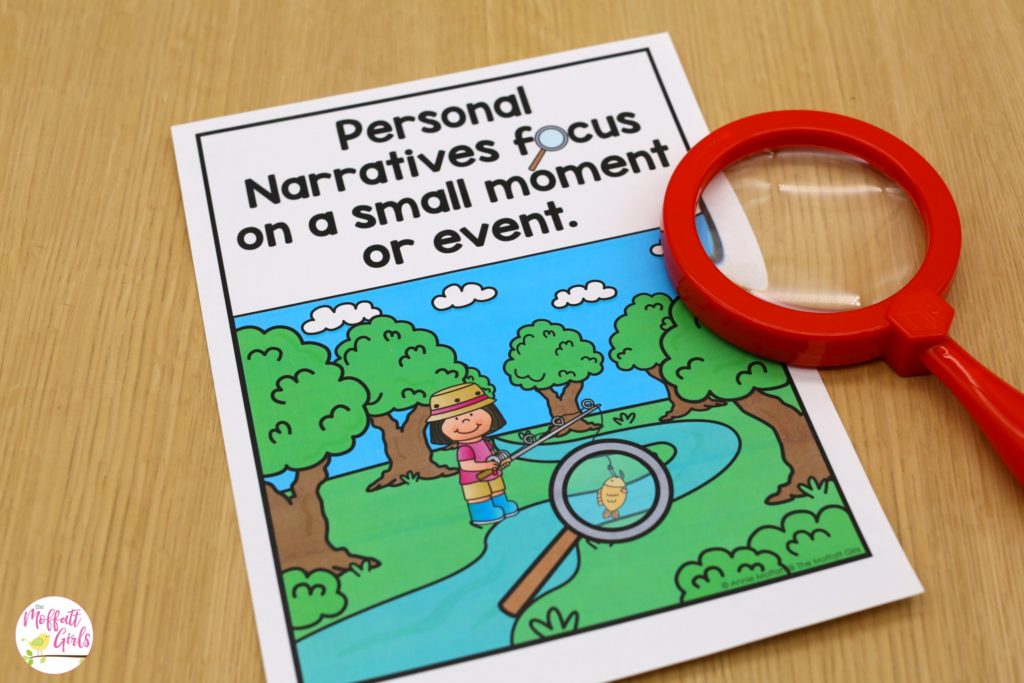
Posters help students understand what a personal narrative is and that their narratives will have a beginning, middle, and end.
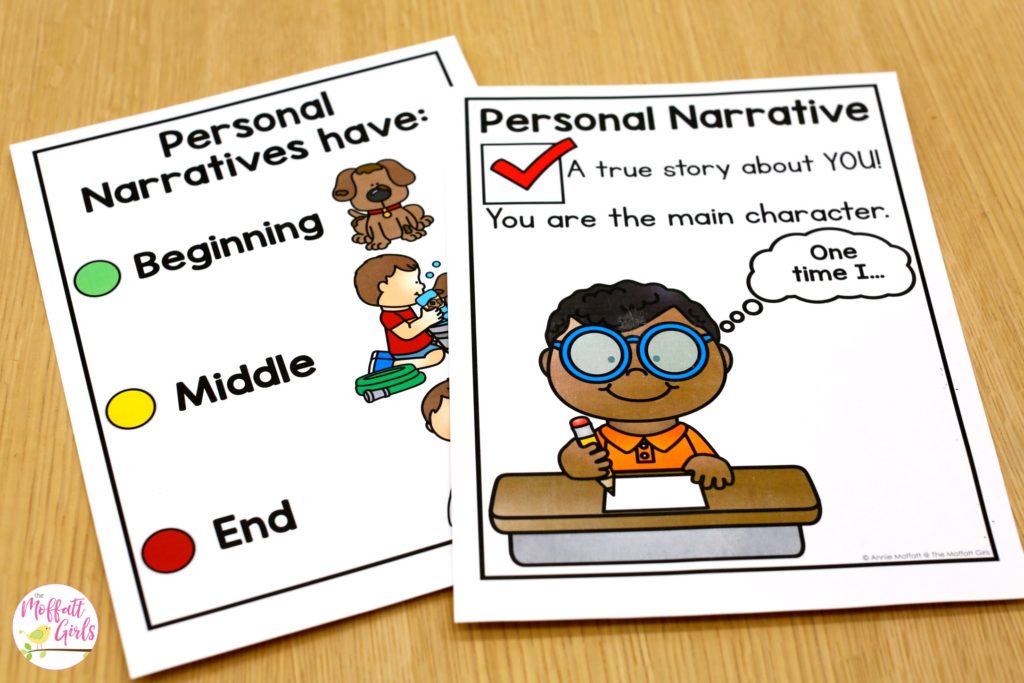
Students learn that personal narratives include words like I, me, my and mine.
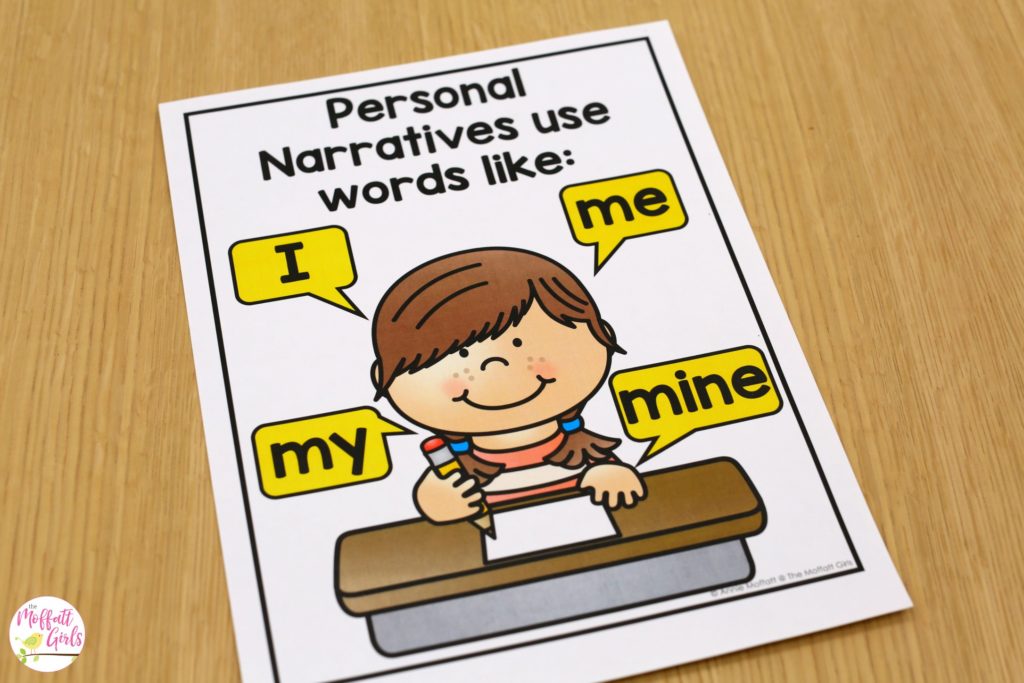
Their personal narrative will include detailed pictures.
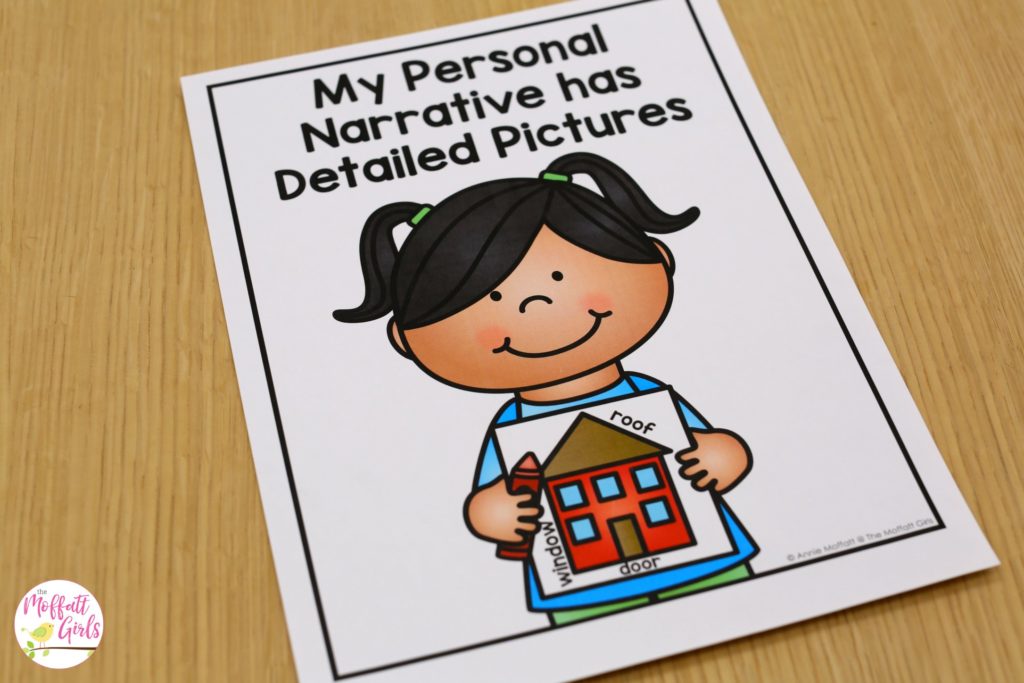
Students will also have access to Personal Narrative Writing Idea posters , if you choose to use them.
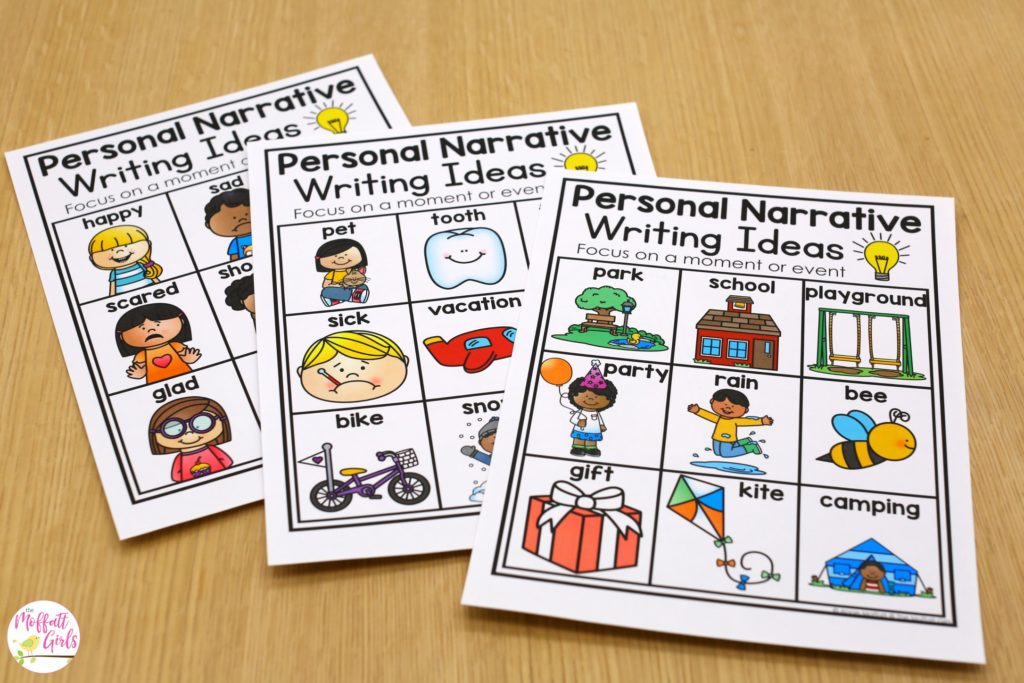
A Writer’s Checklist can be used during small groups to help students edit their writing once they get to that stage.
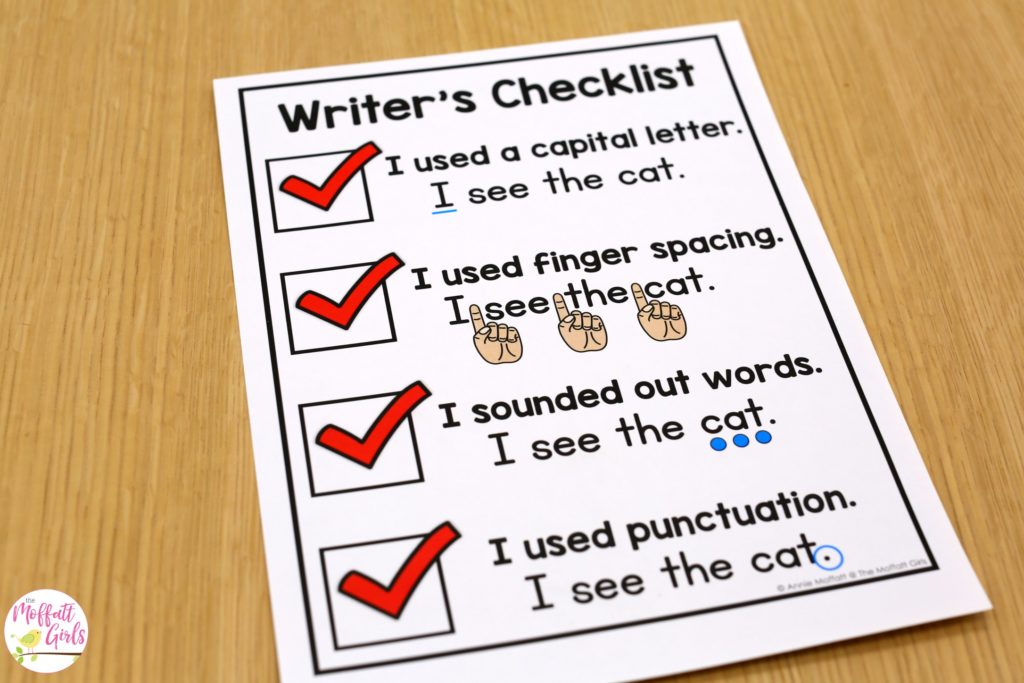
The Writing Process poster will help keep students on track as you move from lesson to lesson. This will highlight where they are in the writing process and what is coming next.
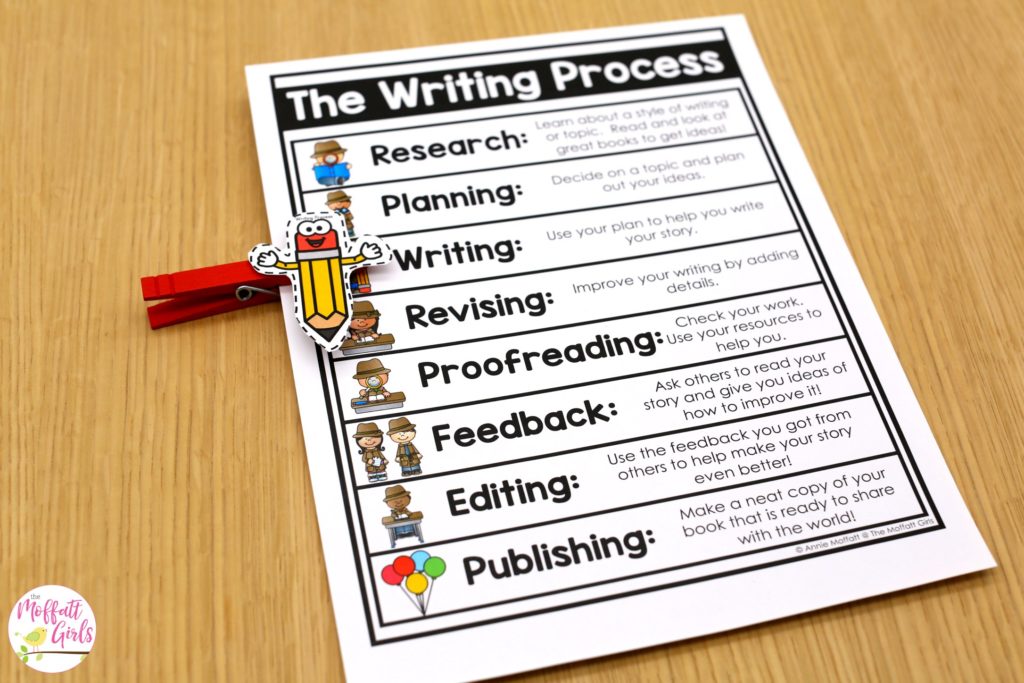
The unit includes templates to get students started by mapping out their personal narrative with pictures.
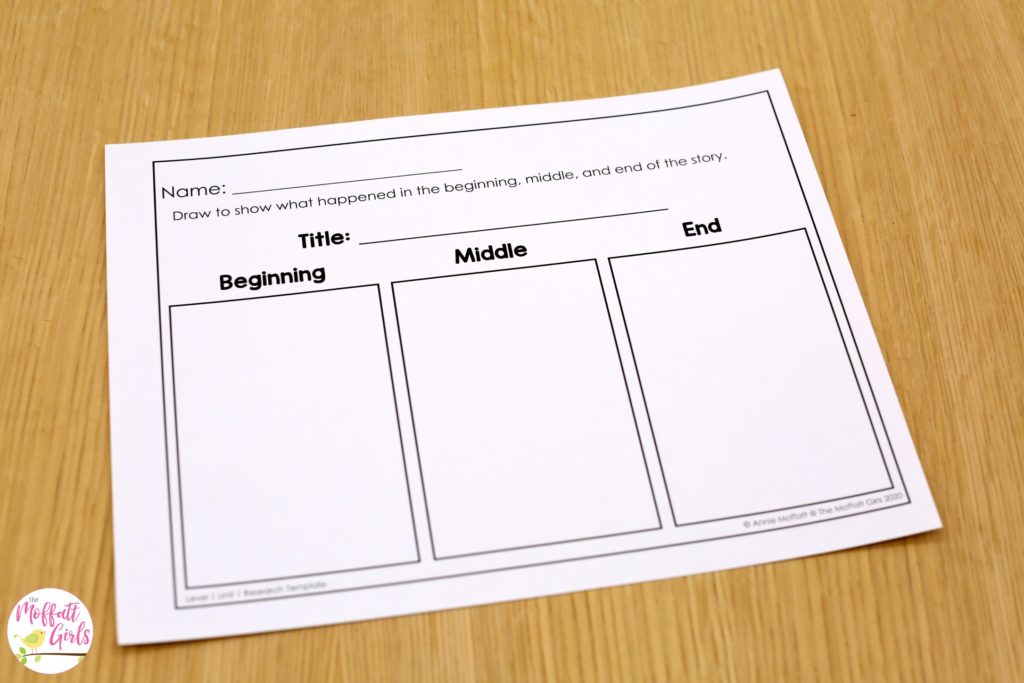
Choose the template of your choice from the Level A Writing Templates.
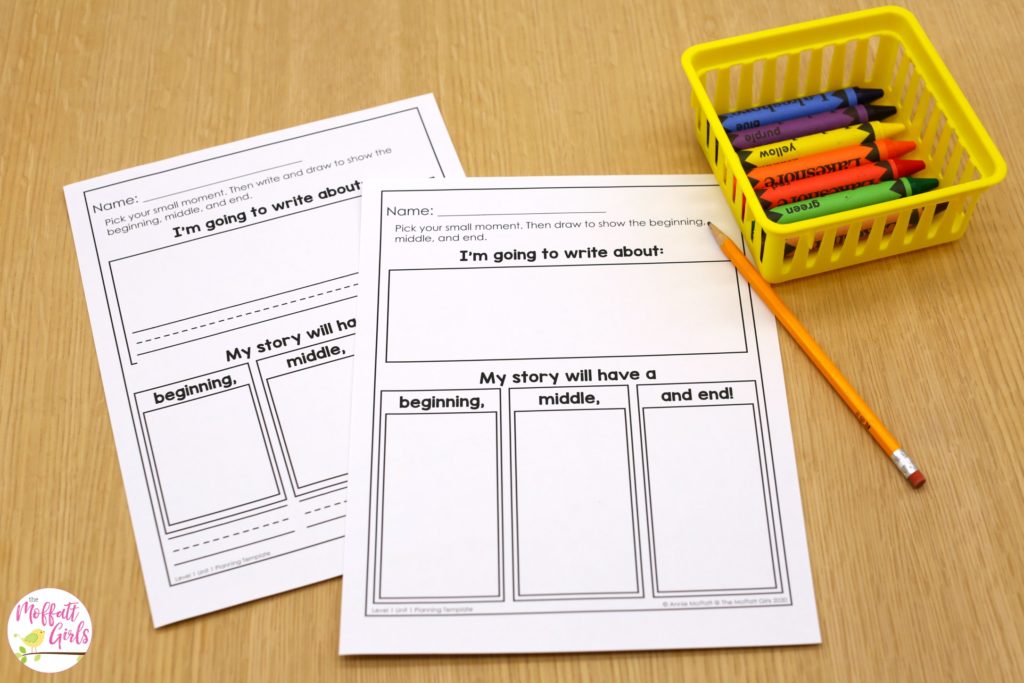
Developmental Stages of Writing appropriate for Kindergarten:
While all students develop differently, most student writing progresses along these developmental writing stages. Therefore, use this chart to determine a student’s current writing level and identify next steps and goals. Keep in mind, it is normal for students to progress through some stages quickly and linger at others.
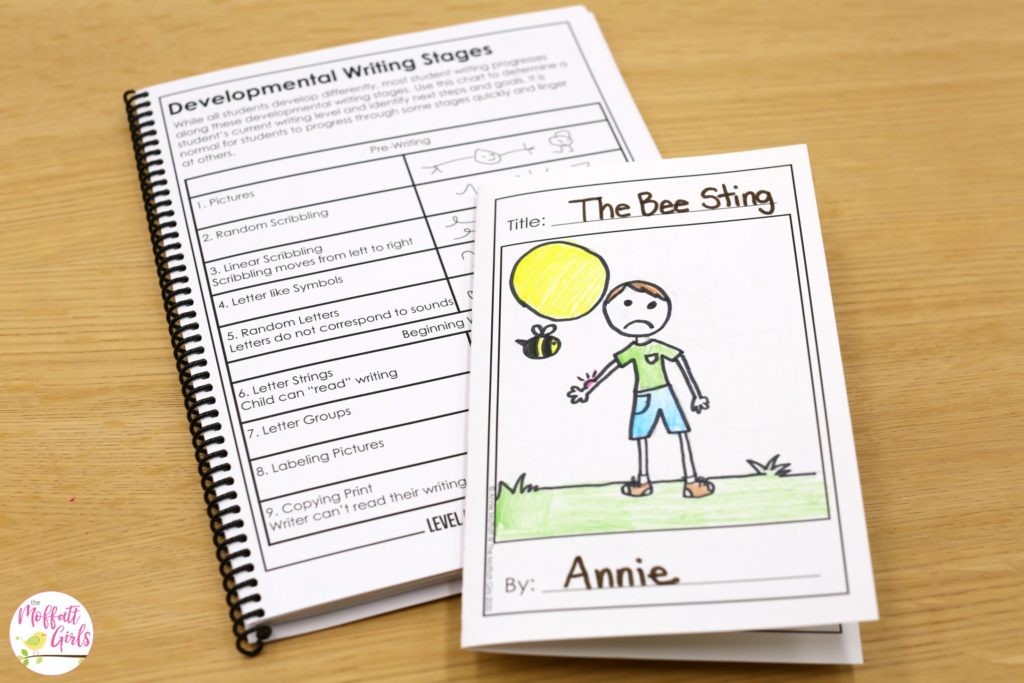
- Pre-Writing Stage:
- Random Scribbling
- Linear Scribbling. Scribbling moves from left to right
- Letter-like Symbols
- Random Letters. Letters do not correspond to sounds.
- Beginning Writing Stage:
- Letter Strings- child can “read” writing.
- Letter Groups
- Labeling Pictures
- Copying Print (Writer can’t read their writing.
- Sound Writing:
- Beginning Sounds
- Beginning and Ending Sounds
- Medial Sounds
- Fluent Writing
- Phrase Writing
- Mixed Sound and Recall Spelling
- Sentence Writing
- All Syllables are Represented
- Paragraph Writing
Conferencing:
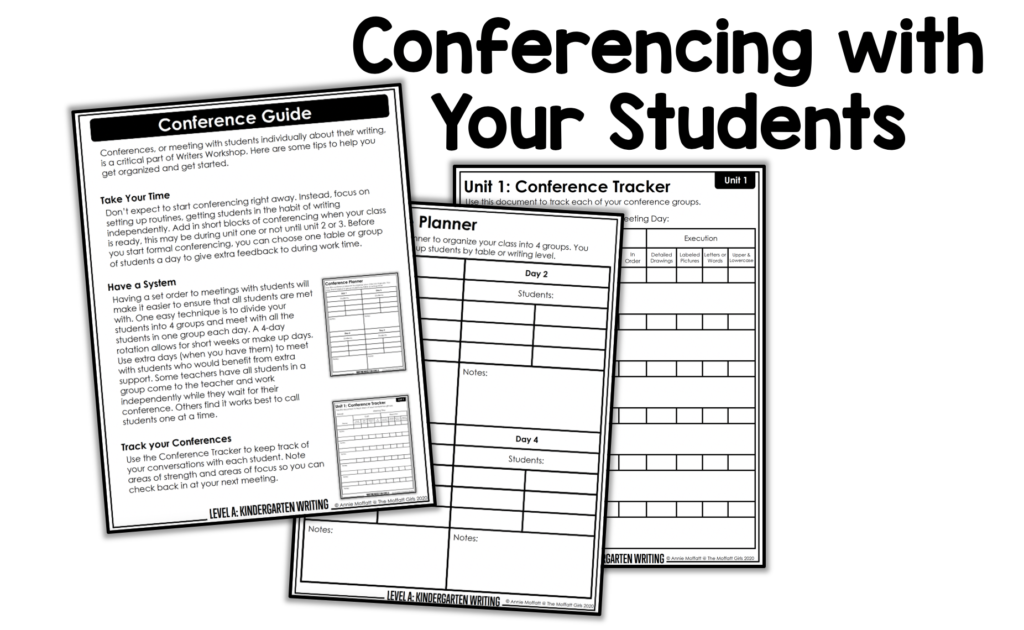
Conference is the heart of Writer’s Workshop! This is where you will work with your small groups and get a good feel of where they are in their writing. Certainly keep in mind that you’re conferring with them. It’s an opportunity to provide individualized instruction, assess students writing, reinforce skills taught during the mini-lessons.
Highlighting Strengths
When you confer with your students, you can identify their strengths and notice what they are doing well. Specifically, these moments are great opportunities to celebrate those moments and help build self-confidence. As a result, students’ writing stamina grows as students learn what they are doing correctly.
Improving Weaknesses
Conferencing also gives the chance for students to think about where they can improve their writing. Certainly you can easily make this your teaching point. You may want to pose questions during this time. For example, what else do good writers do? Suggestions could include adding more details. Or they might need to make sure their writing has a beginning, middle and end. Perhaps the student is working on labeling. Whatever the case, conferencing time is a time to set goals for something they can work on to improve their writing so they can become even better writers.
Scaffolding
In light of the vigorous process, I have included Wordless Picture Books to help make this process more effective! Use the Wordless Picture Books to address specific writing goals with students. Some may be working on labeling. Some might work on detailed pictures. By the end of the year, you will see students progress in the Developmental Stages of Writing and move onto write sentences and even paragraphs.
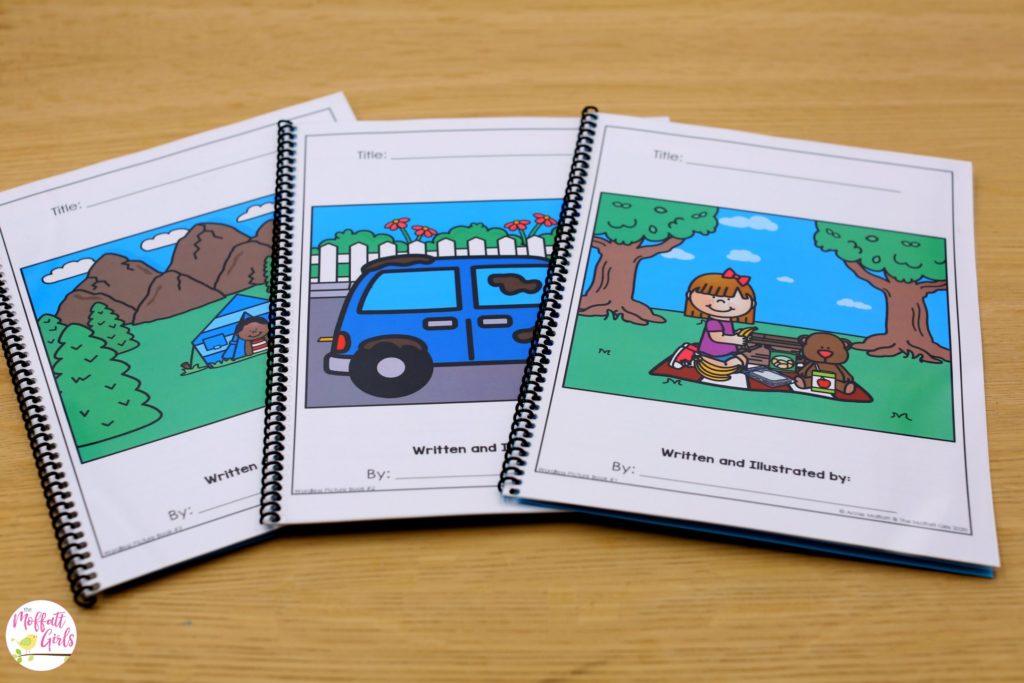
Laminate the Wordless Picture Books and use them model what good writing looks like while meeting with your small groups.
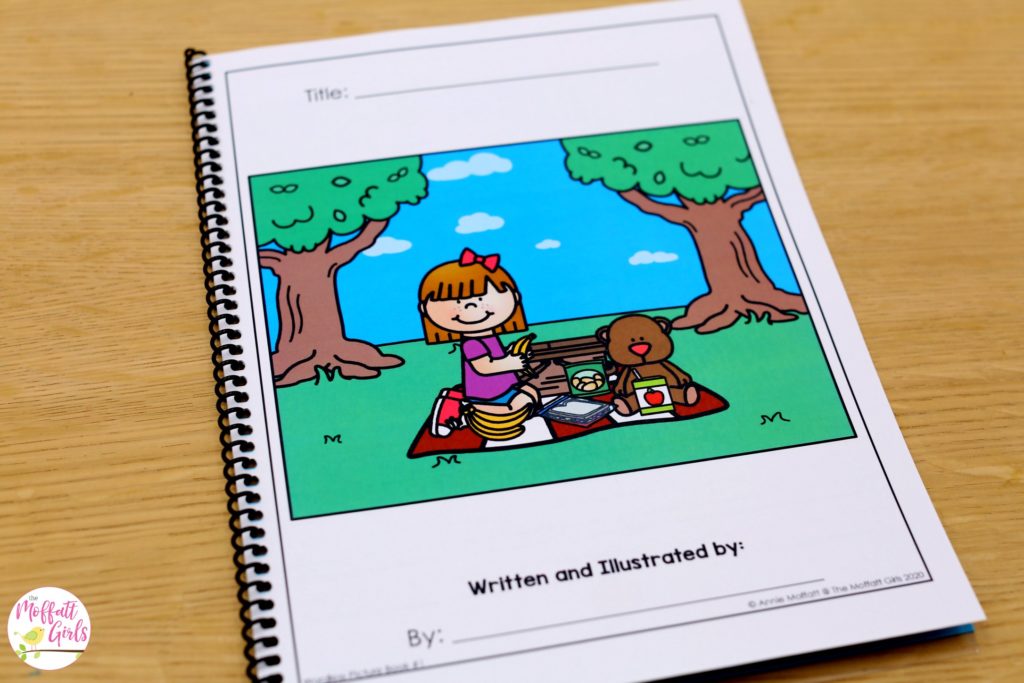
There are blank lines to write a beginning,
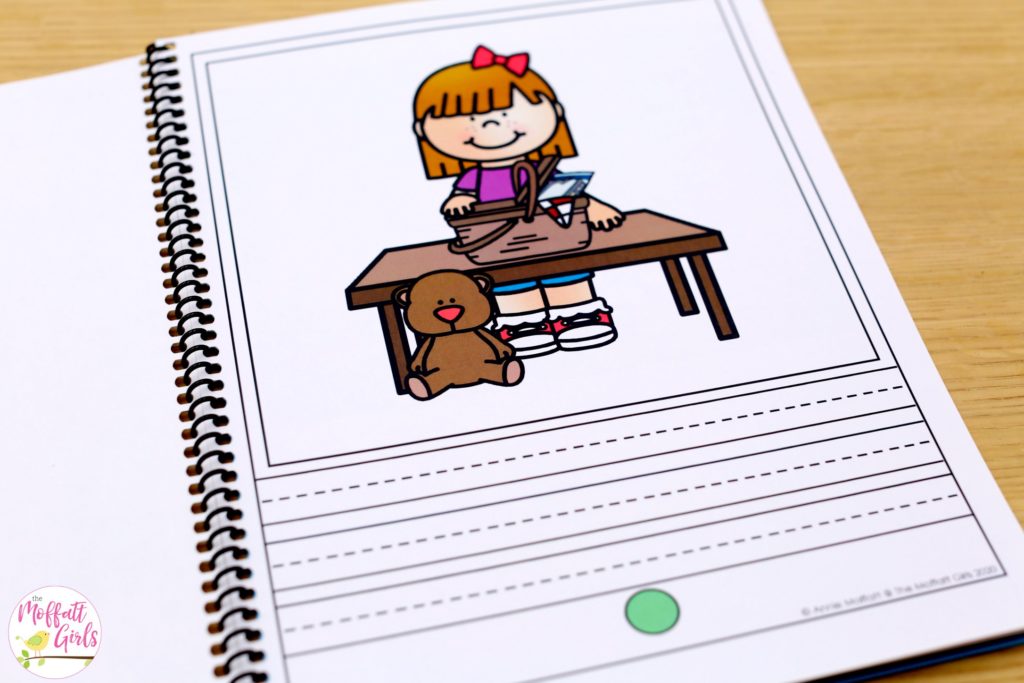
and end to your story.
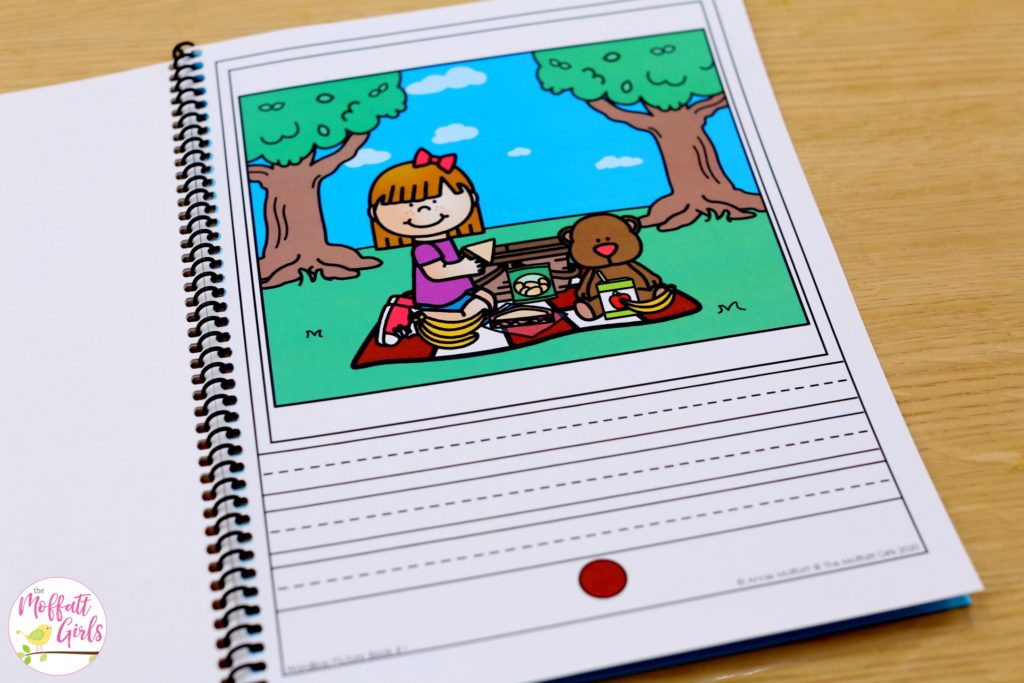
As students progress through their personal narratives, they will continue to grow as writers. Therefore, it is an exciting process to watch! In the example below, students can use the circles at the bottom of the page to show green for beginning, yellow for middle, and red for the end. Alternatively you can have students number their pages 1, 2, and 3.
Remember, some students will just draw pictures, some might label their pictures, and some will attempt to “write” words or sentences. First and foremost, let the creativity flow. Consequently, you will be able to watch your writers blossom and fall in LOVE with writing!
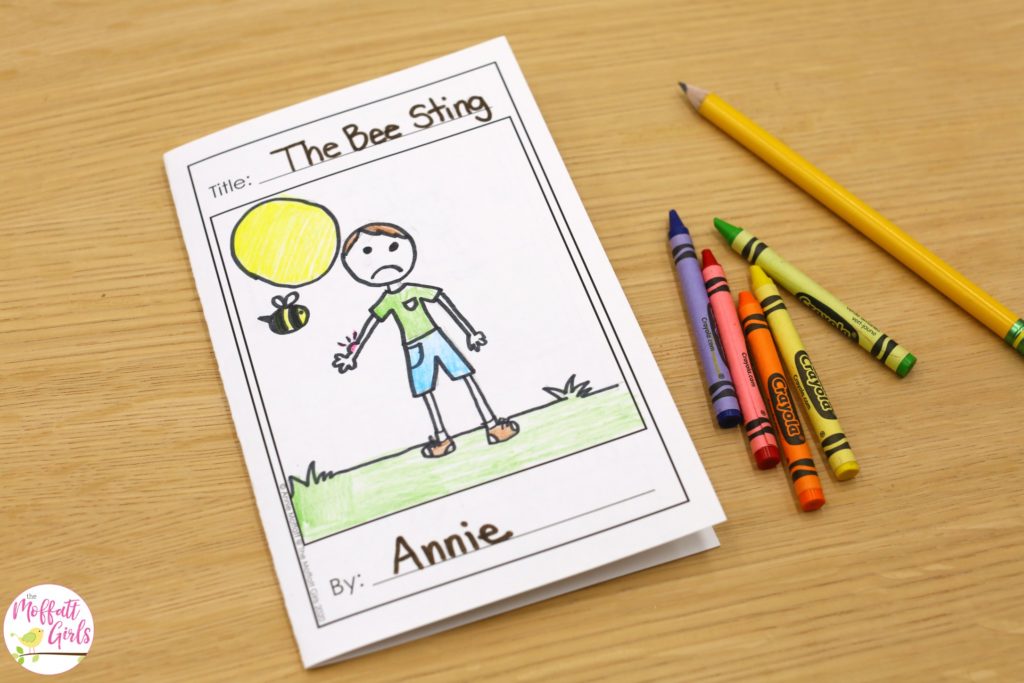
Celebrate your students successes as you continue to build writing stamina!
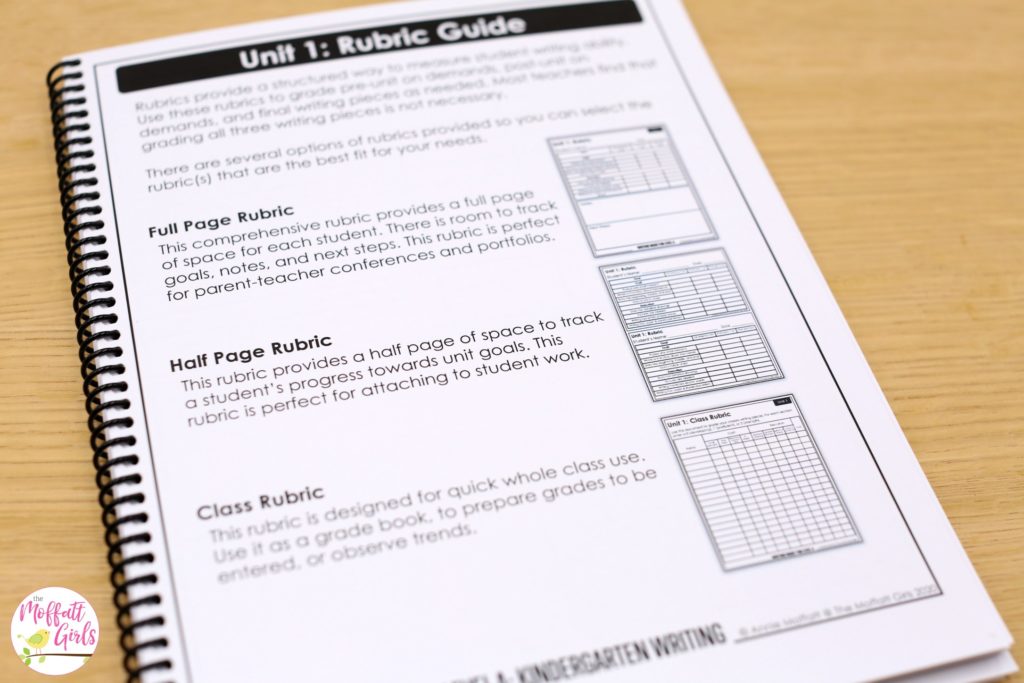
Rubrics provide a structured way to measure student writing ability. Use these rubrics to grade pre-unit on demands, post-unit on demands, and final writing pieces as needed. Most teachers find that grading all three writing pieces is not necessary.
Conveniently, there are several options of rubrics provided so you can select the rubric(s) that best fits your needs.
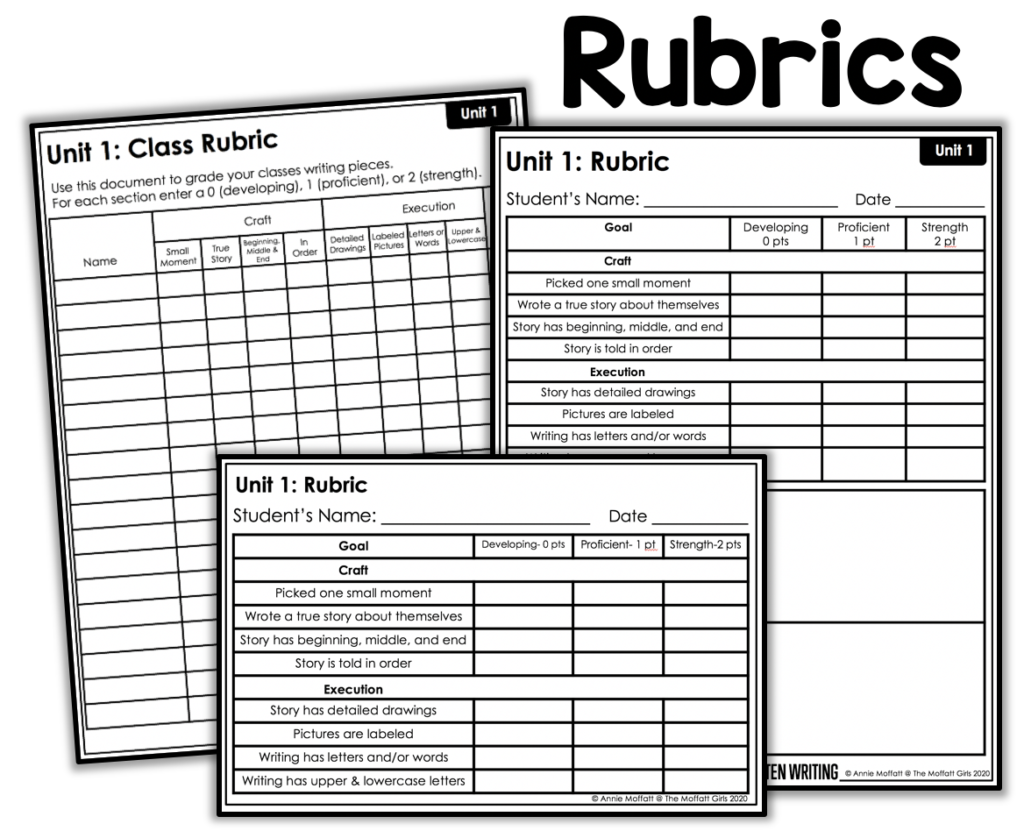
Publishing Party :
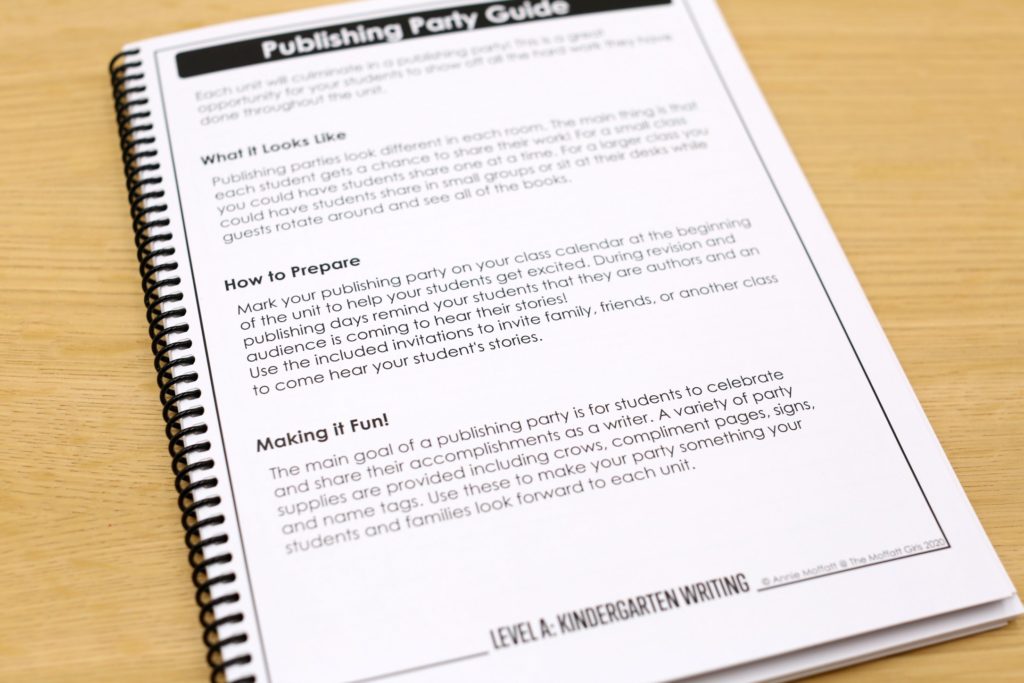
Now it’s time for students to share their writing in Lesson 22 ! This is such an important component to Writer’s Workshop, especially in Kindergarten! Finally, it’s time to have a Publishing Party! Students have worked hard to complete 3 personal narratives! It’s time to celebrate their accomplishments!
Publishing parties look different in each room. The main thing is that each student gets a chance to share their work! For a small class you could have students share one at a time. On the other hand, for a larger class you could have students share in small groups or sit at their desks while guests rotate around and see all of the books.
Plan Ahead:
Mark your publishing party on your class calendar at the beginning of the unit to help your students get excited. Additionally, during revision and publishing days remind your students that they are authors and an audience is coming to hear their stories!
The main goal of a publishing party is for students to celebrate and share their accomplishments as a writer . A variety of party supplies and props are provided including crowns, compliment pages, signs, party invitations, an “I’m an Author” banner and name tags. Use these to make your party something your students and families look forward to each unit. Let’s get this party started!
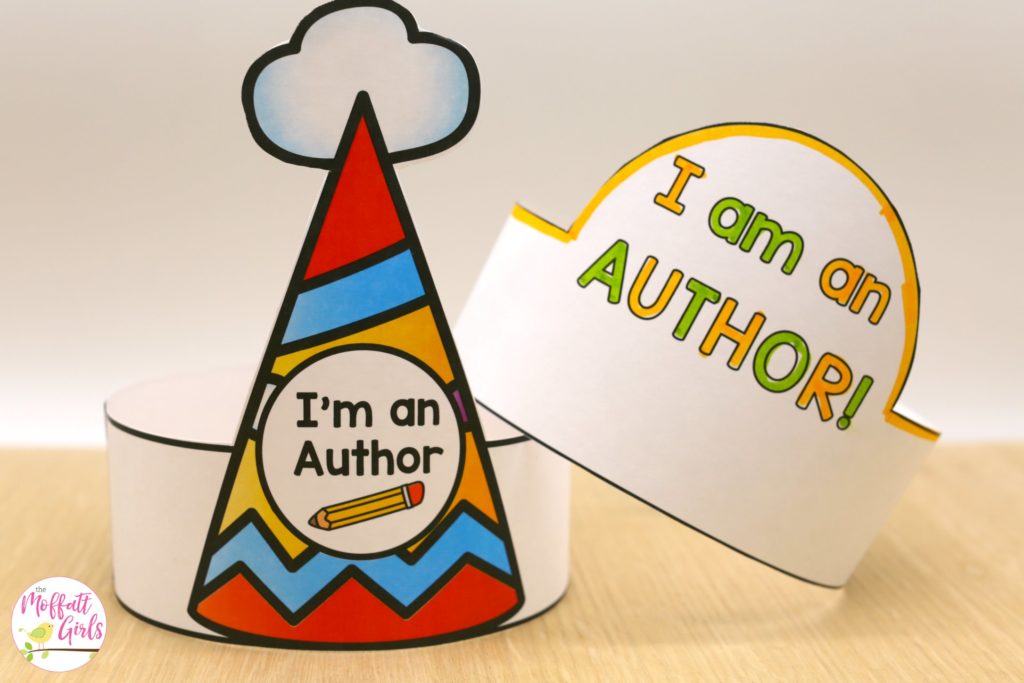
For your convenience, you can use the included invitations to invite family, friends, or another class to come hear your student’s stories.

I hope this post was helpful to you as you set out to implement kindergarten writing workshop this year!

Be sure to join my private Facebook group with other likeminded educators and homeschool families that are using Moffatt Girl Curriculum!
Happy Teaching!

Related Posts
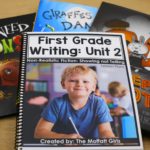
Reader Interactions
February 8, 2023 at 4:07 pm
I. Am intereses on the kindergarten currículum, where caI get It.
February 16, 2023 at 6:06 pm
Hi Karina, here’s the link to the Kindergarten Writing Curriculum: Click Here .
Kindly, Annie
Leave a Reply Cancel reply
Your email address will not be published. Required fields are marked *
Find me on Facebook
The Moffatt Girls
Pinning & Learning
Moffattgirls.

- Number & Place Value
- Addition & Subtraction
- Measurement & Geometry
- Play-based Learning
- Formative Assessment
- Planning & Programming
- Art & Craft
- Digital Learning
- Sustainability
- Transition to School
- Systems & Routines
- Classroom Themes
- Learning Displays
- Decorative Displays
- Emotional Literacy
- Staff Activities
- Teaching Literacy Phonics Reading Writing Math Number & Place Value Addition & Subtraction Measurement & Geometry Teaching Practice Play-based Learning Formative Assessment Planning & Programming Other Categories Art & Craft Digital Learning Fine Motor Sustainability Transition to School
- Classroom Classroom Management Behaviour Systems & Routines Storage Decor & Displays Classroom Themes Learning Displays Decorative Displays DIY & Hacks DIY Hacks
- Well-being Social-emotional Learning Emotional Literacy Kindness Gratitude Teacher Well-being Staff Activities

Narrative Writing for Kindergarten and First Grade
Planning a writing unit of work can be quite overwhelming, particularly as a beginning teacher. I'm here to help you create engaging, effective lesson plans and narrative writing units for your young writers. These tips will be most appropriate for Kindergarten students or Grade 1/2 students, but could also be adapted for older children too!
I'll also share a range of quality mentor texts and writing prompts to support young children, and even the most reluctant writers, in learning to write a narrative story!
START WITH BACKWARD MAPPING
The first thing you need to identify is what the end goals will be for your little learners. What understandings or skills do you want them to have by the end of your unit of work or set of lessons? This is a crucial first step because it then allows you to frame all of your lessons, activities and teaching points around that end goal. This process is known as backward mapping, where you begin with the objectives of a unit and then work backwards to create lessons that will achieve those goals.
For example, in our Kindergarten Narratives unit, the end goal is for most students to be able to write a simple story. I also think about how I will differentiate that end goal. For students who require additional support, their goal might be to write a sentence about an imaginary character or setting. For students who require extension, their goal may be to use more advanced descriptive language (e.g. adventurous adjectives or similes) or to write a more detailed story (e.g. include details about a character’s inside and outside traits, or more than one problem or single event).
As with anything we teach, it is so important that students understand the WHY of what they’re learning. What is the point? Why are they learning it? If they understand this, they will be much more motivated and on board with learning it!
In writing lessons, we talk about the three purposes of writing- writing to inform, writing to entertain and writing to persuade. We use the PIE acronym to help us remember this (Persuade, Inform, Entertain).

When we are writing narrative pieces, we discuss the fact that our writing purpose is to ENTERTAIN others with interesting and exciting stories!
WHAT DO WE NEED TO DO IN ORDER TO GET THERE?
Next, I think of all the skills and knowledge that my students will need to learn in order to be successful. I make a list of all the key teaching points, and break down how I will not only cover all those skills throughout the unit of work, but build upon those skills in an incremental way.
For example, in our Kindergarten Fairy Tales unit, I break down what the components of a story are that I will need to teach my students. This includes:
- Creating imaginary characters, and describing their traits
- Using our senses to describe a setting
- Thinking of interesting problems for a story
- Fixing that problem
Students will also need revision in other key writing skills such as:
- How to write a complete sentence - using capital letters and end punctuation correctly
- How to spell simple words, applying their knowledge of letter sounds and common heart words
- The editing component of the writing process - re-reading over their work and checking for errors.
These skills may be reviewed in small moments throughout our narrative writing lessons, as well as explicitly in our spelling, phonics and sentence structure lessons.
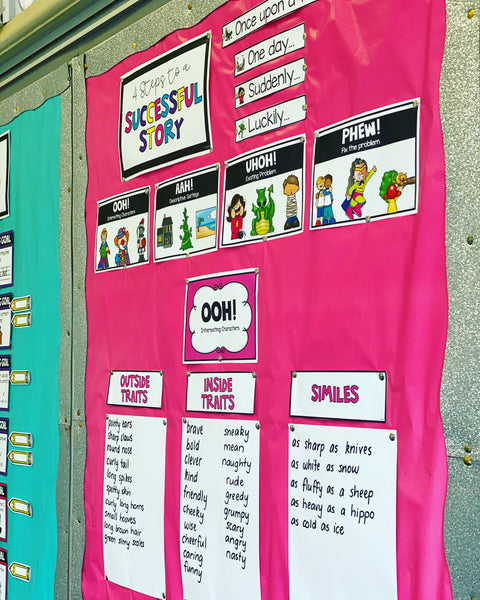
Towards the end of the unit, I begin to teach students how to plan out a whole story with graphic organisers, and also how to adapt known fairy tales to create their own stories. All of these things will need to be EXPLICITLY taught through modelling and scaffolded practice.
Once you know what skills you need to teach, you can have some fun in thinking about what activities you are going to use to teach students all of these concepts. For example, I love finding fun ways to explore characters. We create our own monsters and write a character description, focusing on interesting adjectives. Or we re-imagine characters and discuss whether they might have just been misunderstood- perhaps the Big Bad Wolf was actually good?! Plan activities that are going to explicitly teach the skills, but will also be FUN for the students and get them excited about what they are learning!
HOW WILL I SCAFFOLD LEARNING ALONG THE WAY?
This part of the process is so often glossed over or skipped past, but it is SUCH a crucial step. Too often I think teachers jump straight from explicit teaching to independent practice, without giving students enough scaffolding or opportunities for guided practice in small groups.
The research into cognitive load theory suggests that when we are teaching new knowledge, content or skills to our students, we will be far more effective and successful if we support our students with explicit guidance and scaffolding, along with practice and feedback.
The Gradual Release of Responsibility model is a good rule of thumb to keep in mind whenever you are planning any unit of work or lesson sequence.

Also, don't underestimate the power of modelling examples to your students. This is a great way to scaffold and support young learners in their own writing. Whenever we write, I model writing my own version first on the interactive whiteboard. The quality of my students’ writing is always so much better when I’ve taken the time to model to them first what it is that I’m looking for.

Non-examples are also a really powerful teaching tool as well. I model what NOT to do or make mistakes in my writing, and get my students to help me to edit and correct my own work. Students love being the ‘experts’ who need to help their teachers, and this process allows students to develop much deeper understandings of the success criteria for a lesson.
Some examples of how I scaffold students when teaching fairy tales:
1. break up story elements into manageable chunks and explicitly teach each of these components.
We build up our skills for writing an entire story in incremental chunks, rather writing full stories at the very beginning of the unit. Some examples of what we work on throughout the unit include inside and outside character traits, replacing known characters in fairy tales, and identifying the problem in familiar stories.

2. Verbal before written
We do lots of verbal practice of concepts before we even begin writing. For example, we look at lots of character pictures and unpack ways to describe that character’s inside and outside traits. We also look at lots of setting pictures and use our senses to describe everything about that setting- what can we hear, what can we see, what could we feel, what could we hear and sometimes even what could we taste?

3. Provide students with a scaffold to base their stories around
In the earlier years I use a very simple structure of:
Once upon a time... (interesting character)
One day... (descriptive settings)
Suddenly... (exciting problem)
Luckily... (fix the problem).

These sentence scaffolds are obviously a very simplistic break down of a story, but they are a really useful tool for when you are first helping kids to get their heads around structuring a story! It helps to set them up for success.
Here is an example of how this simple scaffold can lead to a simple story:

As an extension, some students may use alternative sentence starters (e.g. One bright sunny morning... All of a sudden.... As quick as a flash...) or write longer paragraphs for each section.

4. Innovating on known stories
This is another great tool for reducing cognitive load and allowing students to have the confidence to attempt their own stories when they are first learning to write.
We use known stories such as Jack and the Beanstalk, and just adapt some of the elements (e.g. change the character of Jack to Sally, the beans to magic rice, the beanstalk to a ladder, and the giant to a dragon).
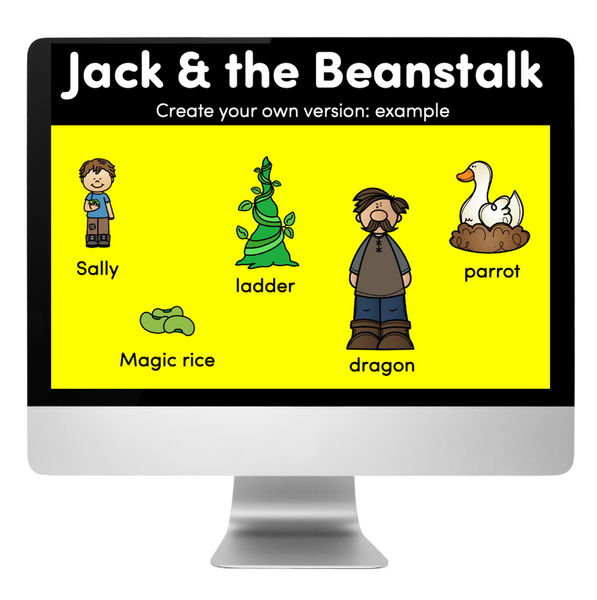
You could also adapt/change parts of a story e.g. change the problem in Three Billy Goats Gruff or change the ending to Hansel and Gretel.

In older years, I use Pie Corbett’s Story Models to give students lots of different story structure scaffolds that they could base a story around (e.g. warning tale, rags to riches tale).

5. Effective Learning Displays
As a class, we create a variety of learning displays and anchor charts to support our unit. For example, we create word banks using words that we come across throughout our lessons. These displays become an inspiration for students when they are creating their own characters or stories.

It’s important that your learning displays are clear and easy for your students to read, and that the students have helped to create them. Sometimes I give my students a challenge- e.g. I want you to have included at least three outside character traits or three adjectives from our display.

6. Practice, practice, practice
For whatever concept I’m teaching, I give my students plenty of opportunities to practise that skill before we move on. For example, we write LOTS of short character descriptions or setting descriptions. In older grades, I might get students to write five different story openings or five different character descriptions in a lesson. Or if we were learning how to plan a story, we might just practise creating lots of story plans.
One of my literacy centers will often be a writing center, where children can review many of the narrative writing concepts that we have been exploring in our explicit whole class lessons. For example, if you have been working on speech marks and speech bubbles, children could use macaroni pasta to add speech marks to different pieces of writing!
BE FLEXIBLE PLANNERS
It is so important that we are willing to be flexible with the programs that we have created. We need to adapt them as we are teaching, so that they are based around the needs of our learners. Sometimes you will find that students grasp a concept much quicker than you’d anticipated, and you’ll be able to delve much deeper into that concept or move along to the next concept a bit sooner.
Other times, your students will really struggle with a concept and you may need to slow down and spend more time on something, or adjust the activities to better support your students. Most of the time you’ll probably need to do a mixture of all of the above, because the reality of teaching is that we tend to have a huge range of learning needs within the one classroom!
Be reflective practitioners and don’t be afraid to adjust your programs as you go! I recommend reading up on formative assessment techniques (otherwise known as assessment FOR learning) in order to build up a repertoire of ways that you can be checking in on student understanding throughout your entire teaching and learning sequence!
HOW CAN I HELP YOU?
1. My free resource library, The Freebee Library , is packed full of free resources for you to use with your students to take good writing to GREAT writing! You'll also find a full Imaginative Texts Writing Program .
2. My Kindergarten Writing Bundle for Imaginative Texts will be the perfect addition to your kindergarten writing curriculum. Whether you're looking for a mini lesson, or a full week or term of lesson plans, you'll find loads of quality and engaging activities to use with your students, including:
- Narrative Writing Activities & Templates | Fairy Tales
- Narrative Writing Lesson Slides - Fairy Tales - Imaginative Texts POWERPOINT
- Narrative Writing Posters

3. If you are teaching personal narrative writing (recount writing), where your children are writing a personal narrative based on their own experiences, you might like to check out my Recount Writing PowerPoint Slides . This PowerPoint is most appropriate for a Kindergarten classroom setting, but it can also be a helpful scaffold for older children who might need a little bit of extra support when writing about their own personal experiences.
Unlock 500 free downloads here .

Let’s Chat all Things Writing
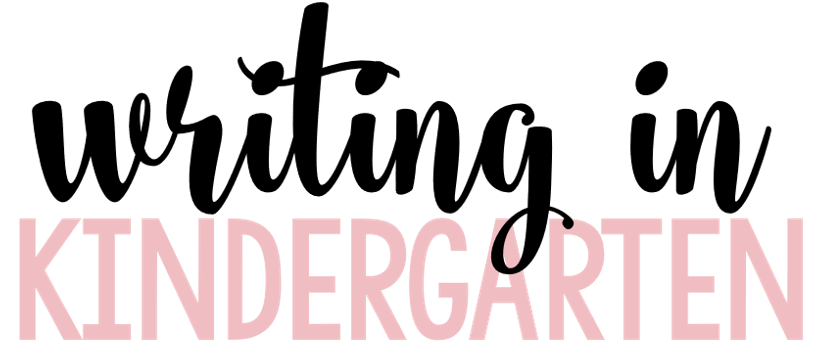
Let’s talk writing! Hey friends! I wanted to take a moment (or a few moments) of your time today to visit about all things WRITING! Writing has always been one of my favorite subjects to teach but for sure not the easiest! I mean when you start the year there is SO MUCH to learn… what a pencil is, how to hold a pencil, how to write with a pencil, what to write, how to stretch words, how to put words into sentences and it goes on from there! Sometimes teaching writing can be intimidating because there are SO many varying opinions. Should you give them a starter? Should you give them a sentence frame? Should they spell words phonetically. Should YOU spell words phonetically when modeling stories and so on!
I finally realized that there is not ONE way to teach writing and if someone tells you that there is only ONE way to do it… then you smile, nod and close your door. All of our students will start at different levels and need different instruction. That brings me to writing instruction and curriculum. There are of course many different writing programs! I was first given the writing lessons from my “big box” curriculum. The top of the lessons started with ALL YEAR, “Students will draw a picture to tell their story. You can dictate the story for them after.” REALLY? I mean yes there will be some kids that start lower and some that still might not get to sentences by the end of kindergarten. However, I’m going to assume that first grade teachers won’t be real happy with me if I only EXPECT my kiddos to color pictures for writing throughout the entire year. That brings me to the opposite end of writing curriculum *cough I’ve shared this program on my own blog before.* I liked this program and it had/has REALLY good parts. The problem is goes TOO fast and leaves out the majority of my students. Sure the program says that the teacher will scaffold by modeling but if the program is too tough for the majority of my class then that means the majority is not receiving the instruction they so deserve.
My first couple of years in the classroom I was constantly changing my kindergarten writing approach due to the above mentioned lack luster big box writing program. One day I would give them a sentence starter. The next day I didn’t. At the end of the year my writers were where they needed to be but there was one thing I noticed… not all the kids enjoyed writing like I enjoyed it! I knew that there was something I had to change! After much research and chatting with colleagues I realized that writing is a work of heart! When the kids are inspired and then able to express that into their kindergarten writing… they too will fall in love with writing! What I didn’t realize those first couple of years was that I was writing and modeling stories that were near and dear to ME. I can’t tell you every story I modeled for them but I am going to guess that a story about four-wheelers or Minecraft wasn’t wasn’t one of those! By turning it over to the kids and having them choose their writing topics, I saw my kids BLOSSOM and year after year my writers fell in love with writing just like me! This is something that the second above mentioned program did but it was SO hard or me to “buy into” that one because it was just not the level of my kiddos. I took that same new passion and worked hard to put it into to easy to read lesson plans! That is when KinderWriting was born! 🙂 In this post, I will share all about my favorite writing lessons I’ve done through the years, give you the freebie templates so you can plug them right into your lessons and I will be sharing all about the writing program I created called, KinderWriting .
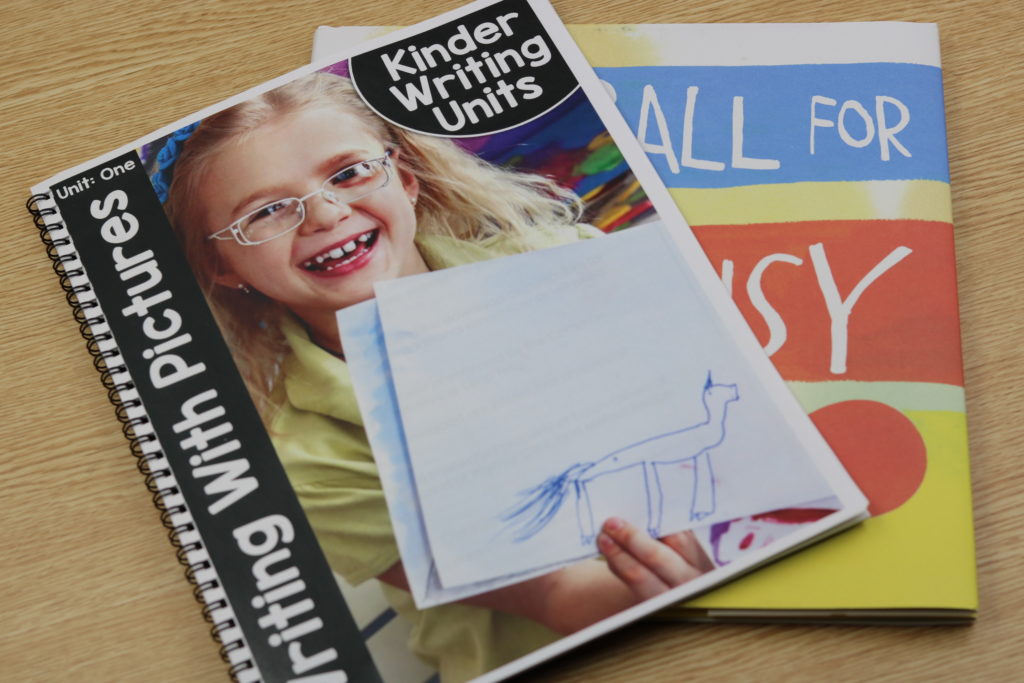
What is KinderWriting?
KinderWriting Curriculum is an engaging, kindergarten, genre-based writing curriculum. KinderWriting encourages young learners to look inward at their endless possibilities as a writer. KinderWriting is based upon nine units: Writing With Pictures, Writing With Sentences, Writing With Stories, Writing With Narrative, Writing With Opinion, Writing With Direction, Writing With Persuasion, Writing With Imagination, and Writing With Information. Each unit is broken down to 20 lessons. The units cover 20 days of academic instruction. The lesson plans have listed unit objectives, “I can” statements, Common Core writing standards and needed mentor texts.
KinderWriting encourages a daily routine of a minilesson, independent writing, and a share time. Each of the lessons in KinderWriting are well thought out for the young writer and spiral back to previous lessons to ensure students are retaining their skills. KinderWriting also includes unit anchor charts, a variety of writing paper, conferring schedules and note sheets, sample writings, student writing goals display, writing rubrics, and step-by-step guides that are made specifically for each unit.
What is included in KinderWritring Curriculum?
-Teacher “simple read” lesson plans. You will not need to rewrite these lesson plans, unless you choose do. If so I have included editable lesson plans. -Each unit I have planned out the; big idea, focus standard, essential questions, and so much more! -Writing paper -Unit posters -Student material -Unit rubrics -Spanish posters included
What about the standards?
Each unit has a focus standard that is based upon the Common Core Standards. Units further into the year will have more than one focus standard. If you teach to a varying set of standards, you can email me for assistance. Thanks!
What Units are Covered?
Unit 1: Writing with Pictures Unit 2: Writing with Sentences Unit 3: Writing with Stories Unit 4: Writing with Narrative Unit 5: Writing with Opinion Unit 6: Writing with Direction Unit 7: Writing with Persuasion Unit 8: Writing with Imagination Unit 9: Writing with Information
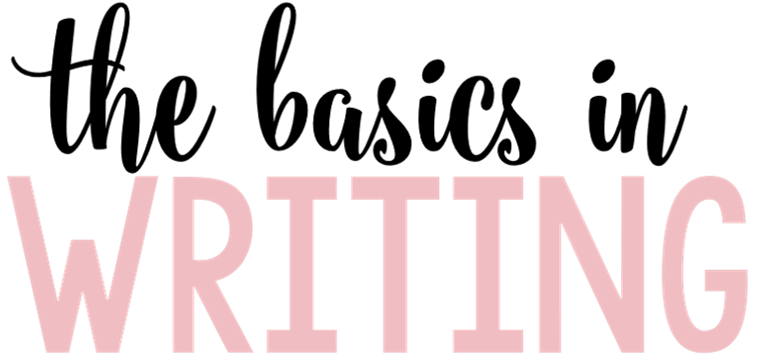
Let’s get started with Unit 1: Writing With Pictures. This unit is all about setting the kiddos up for success! If we jump right into “writing” our kiddos can sometimes feel unsure of themselves. They might worry if their words are spelled correctly or if their pictures are perfect! In unit 1, we introduce students to writing using illustrations! This is big, big, big especially for those lower kiddos! We want them to and NEED them to LOVE writing. We want to set them up with success from the very beginning.
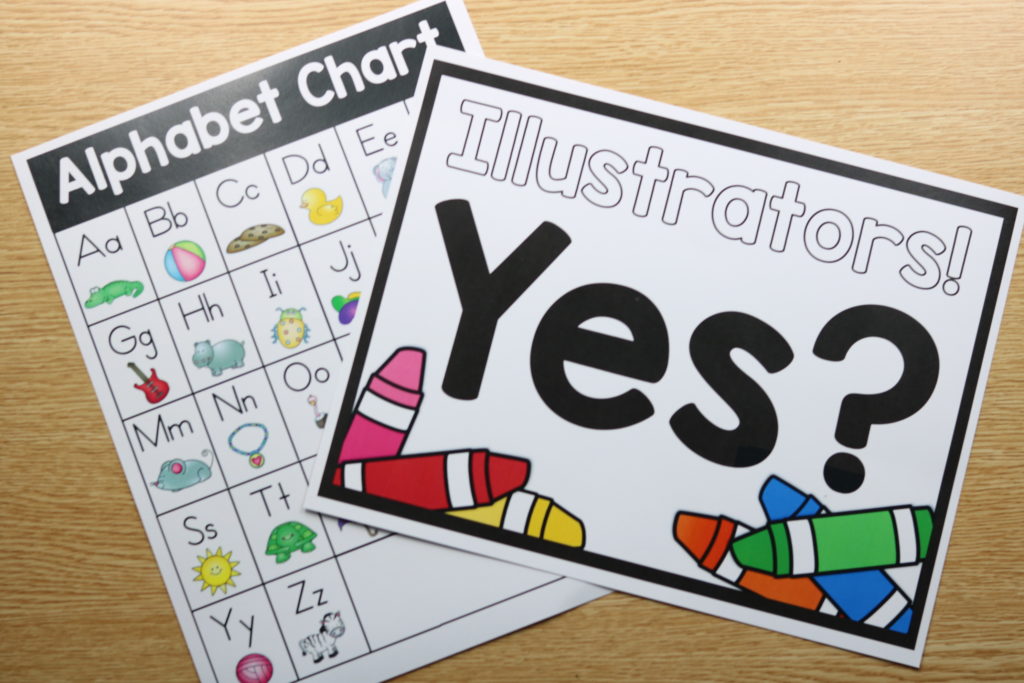
Unit 1: Writing With Pictures
Lesson 1: Illustrators! Yes? Lesson 2: Establishing the Minilesson Lesson 3: Drawing Sticks, Circles, & Boxes Lesson 4: Establishing Independent Write Lesson 5: Share Time Lesson 6: Illustrating the Best I Can Lesson 7: Detailed Pictures Lesson 8: Visualizing My Story Lesson 9: Looking Closely Lesson 10: Setting Goals Lesson 11: What is a Label? Lesson 12: Adding Labels Lesson 13: The Pencil Lesson 14: Labeling for Detail Lesson 15: Ask and Write Lesson 16: Show and Retell Stories Lesson 17: Labeling Your Name Lesson 18: Sticky Conferences Lesson 19: A Picture Book Lesson 20: Celebration
I recently had a Facebook live all about Unit 1! You can listen into that video below! If the video doesn’t load, you can access it HERE !
I have organized my units into a plastic tote! Each unit has a folder in the tote!
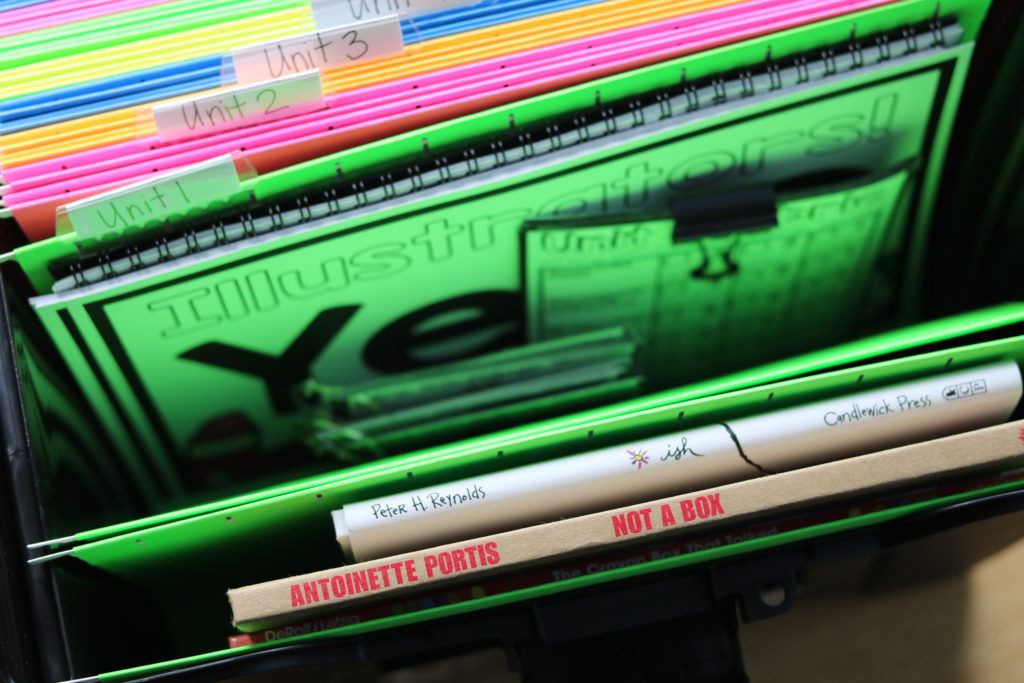
The plans include your needed materials, minilesson and ideas to expand your teaching during the share block!

For independent writing I have offered a variety of writing journals and writing paper! You can choose between landscaped and portrait style! I include lots and lots of styles so that you can decide what works best for your kiddos!
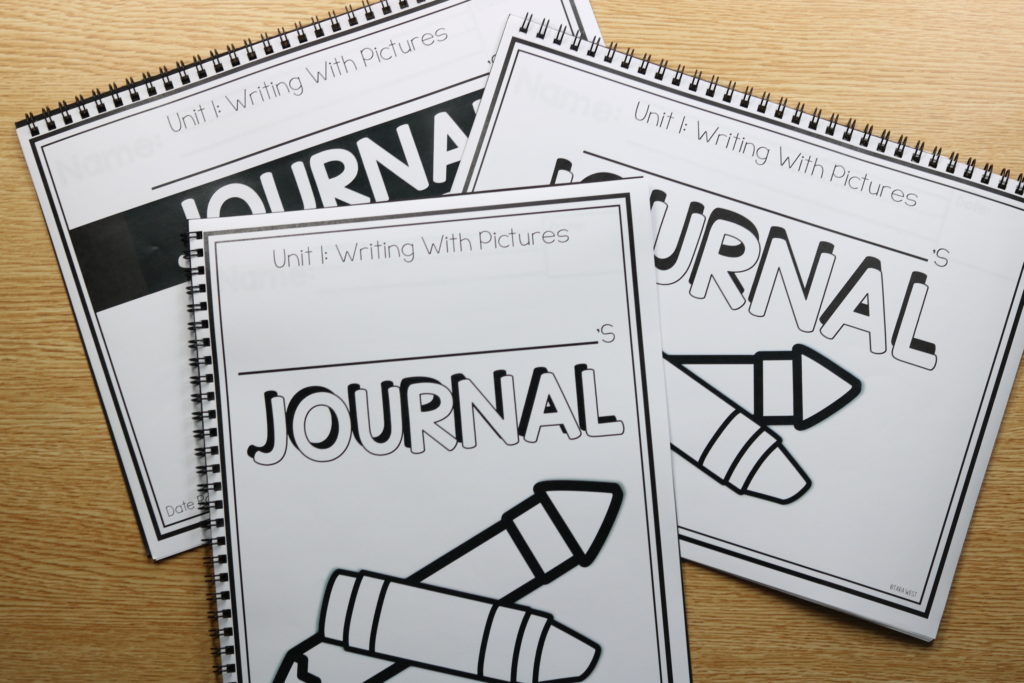
Now let’s take a look at unit 2! In Unit 2 we start to introduce students to writing words and stringing some SIMPLE words together to make sentences!
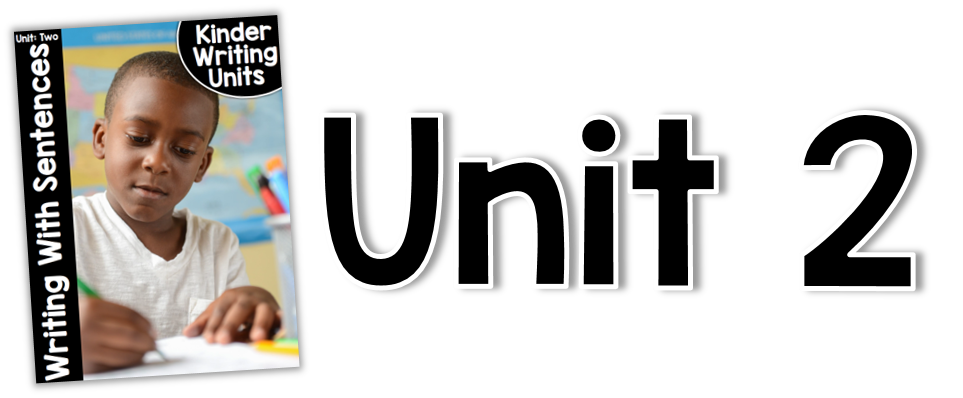
KinderWriting Unit 2 is all about encouraging students to stretch words, write words and then place those words into sentences!
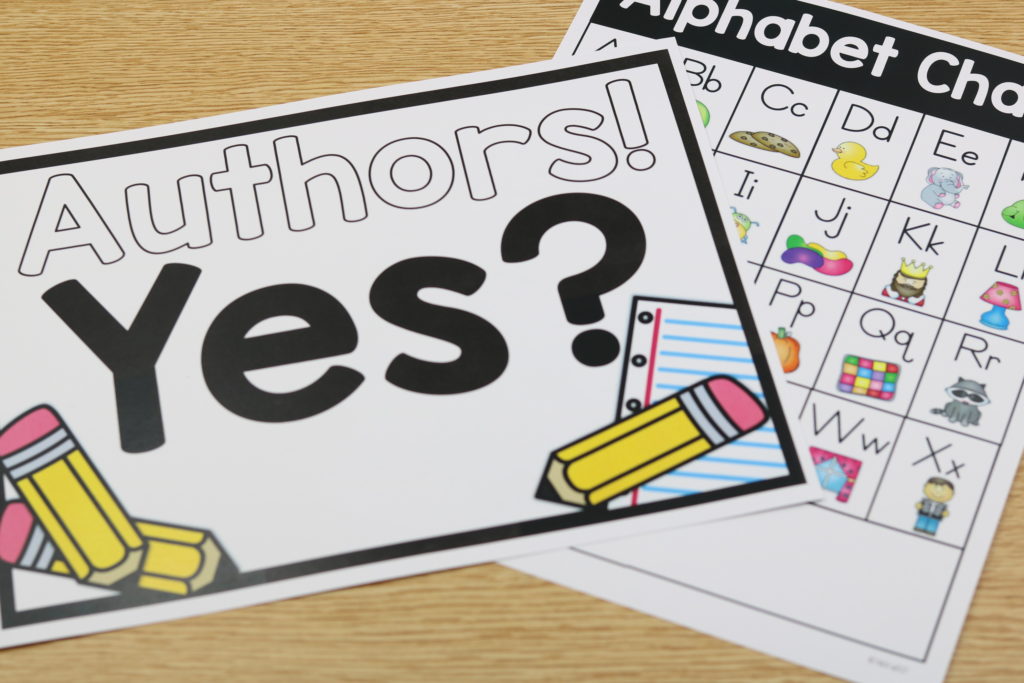
Below is a full listing of the lessons found in Unit 2 of KinderWriting!
Unit 2: Writing With Sentences
Lesson 1: Authors! Yes? Lesson 2: Authors Persevere Lesson 3: Writing Tools- ABC Chart Lesson 4: Making Words Lesson 5: Writers Make Mistakes Lesson 6: Stretching Sounds Lesson 7: Stretching More Sounds Lesson 8: Writing Tools- Sight Word Chart Lesson 9: Color Words Lesson 10: Letters vs. Words Lesson 11: Conferring and Writing Partnerships Lesson 12: Speech Bubbles and Emotion Lesson 13: Using the Room Lesson 14: Are You Really Done? Lesson 15: Capitals Lesson 16: Spacing Lesson 17: Punctuation Lesson 18: Words Make Sentences Lesson 19: Writing Storybooks Lesson 20: Sharing Storybooks
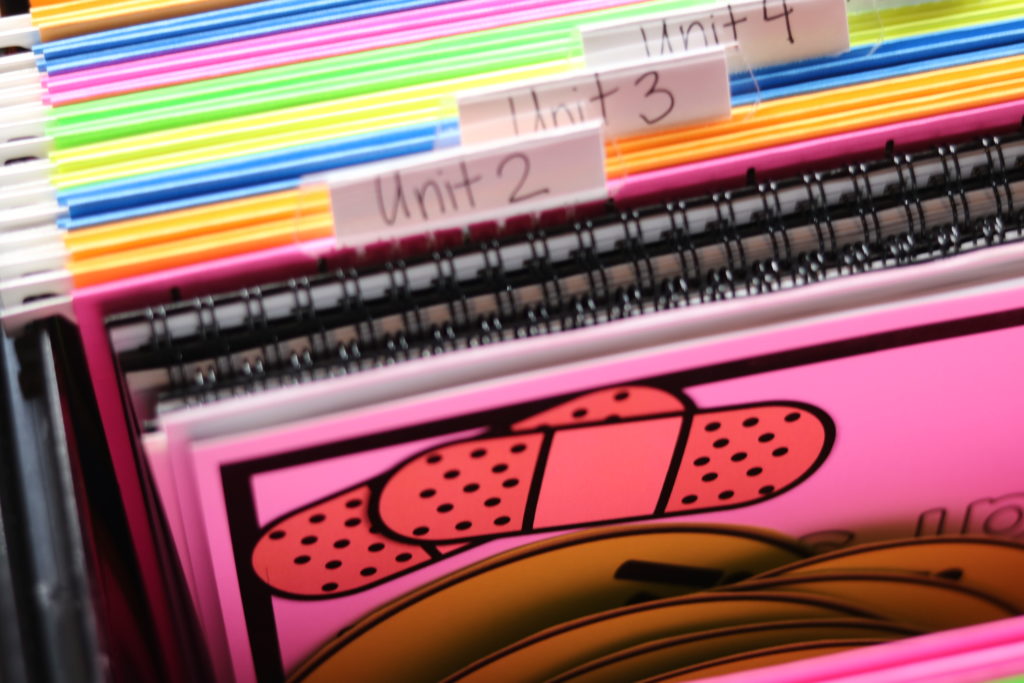
Also in the folder is the unit spiral bound lessons, unit posters and the student mini poster rings!
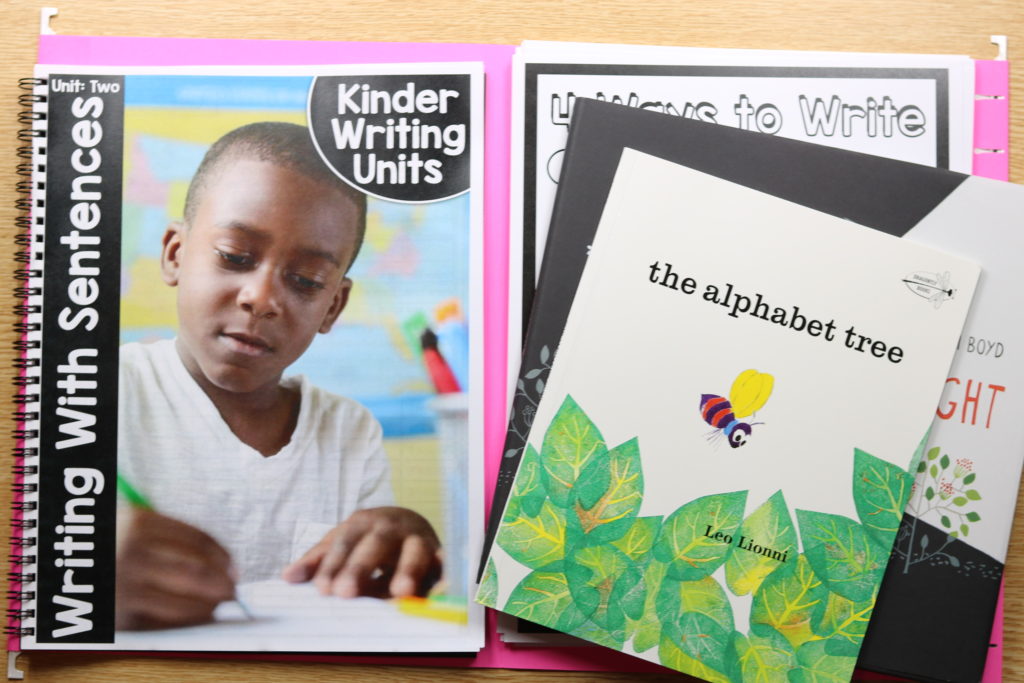
The student resource rings are perfect for the kiddos to keep in their pencil boxes! You can also use them back at your guided reading table!
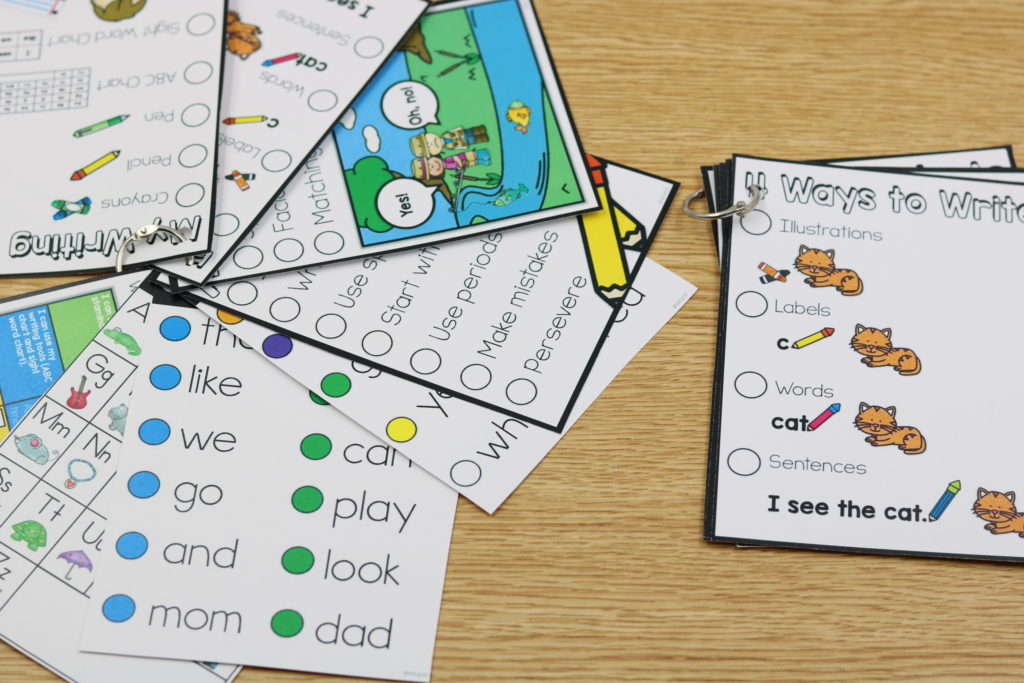
We will use the mentor text, The Alphabet Tree, and build words!
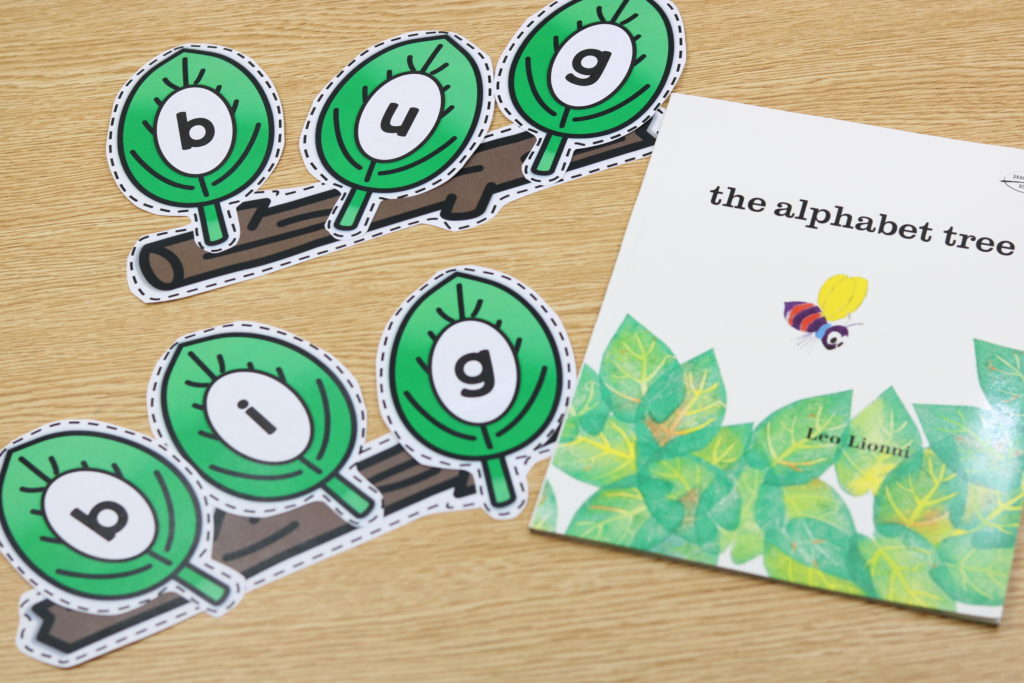
Unit 3: Writing With Stories
Lesson 1: Storytellers! Yes? Lesson 2: Authors Write About What They Love Lesson 3: Authors Write About What They Can Do Lesson 4: Authors Write About What They Know Lesson 5: Authors Write About The Past Lesson 6: Mechanics Matter Lesson 7: Names and Places Use Capitals Lesson 8: Tap Out the Story Lesson 9: Powerful Punctuation Lesson 10: Ask More With Writing Partners Lesson 11: A 5 W’s Story Lesson 12: Topics are Everywhere Lesson 13: Books are Stories Lesson 14: Places are Stories Lesson 15: Colors are Stories Lesson 16: Elapsed Time Lesson 17: Adding On Lesson 18: Illustrations Tell Stories Lesson 19: Storytelling Booklets Lesson 20: Sharing Storybooks
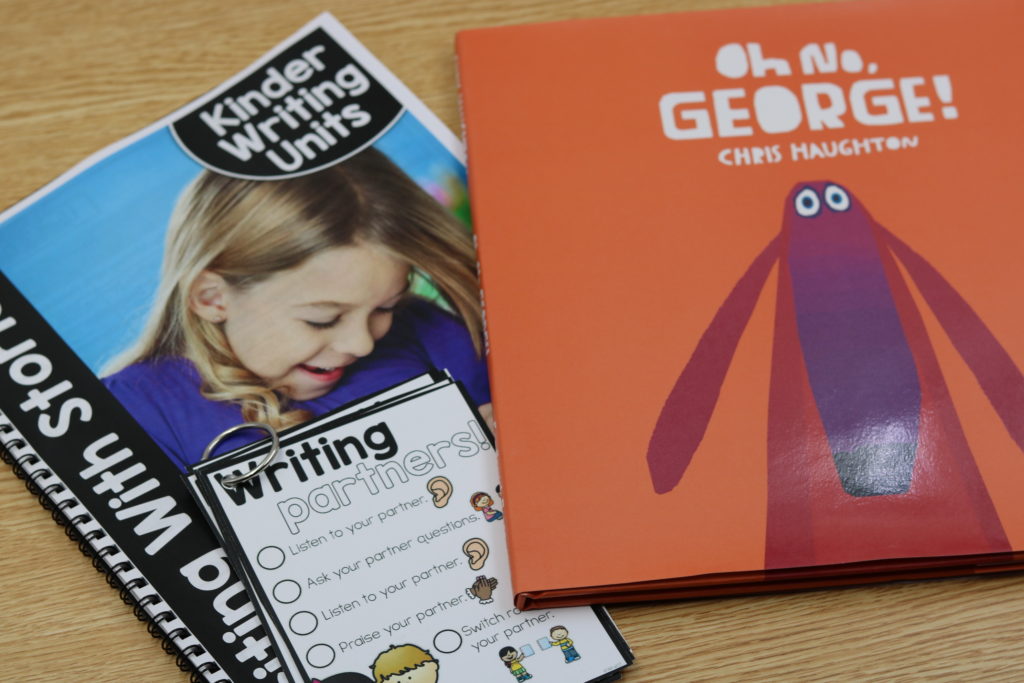
The big push in Unit 3 is to help those that struggle with generating their own witting topic each day! We want them to be confident in realizing that there are stories ALL AROUND US! We use included pictures to help students generate writing ideas.
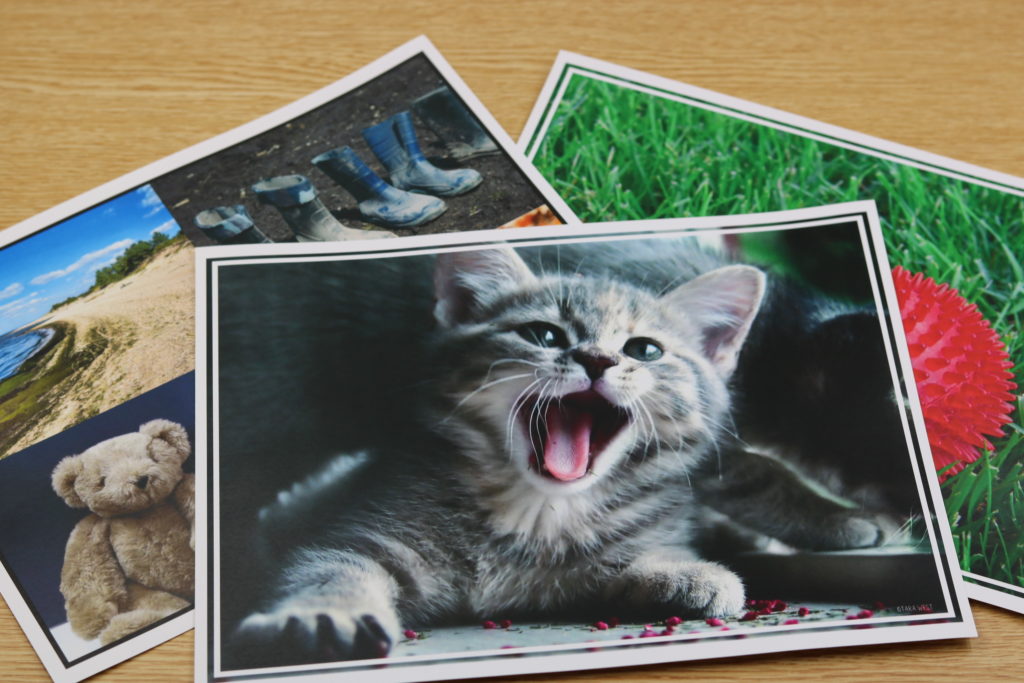
We also teach them about using color as a writing inspiration!
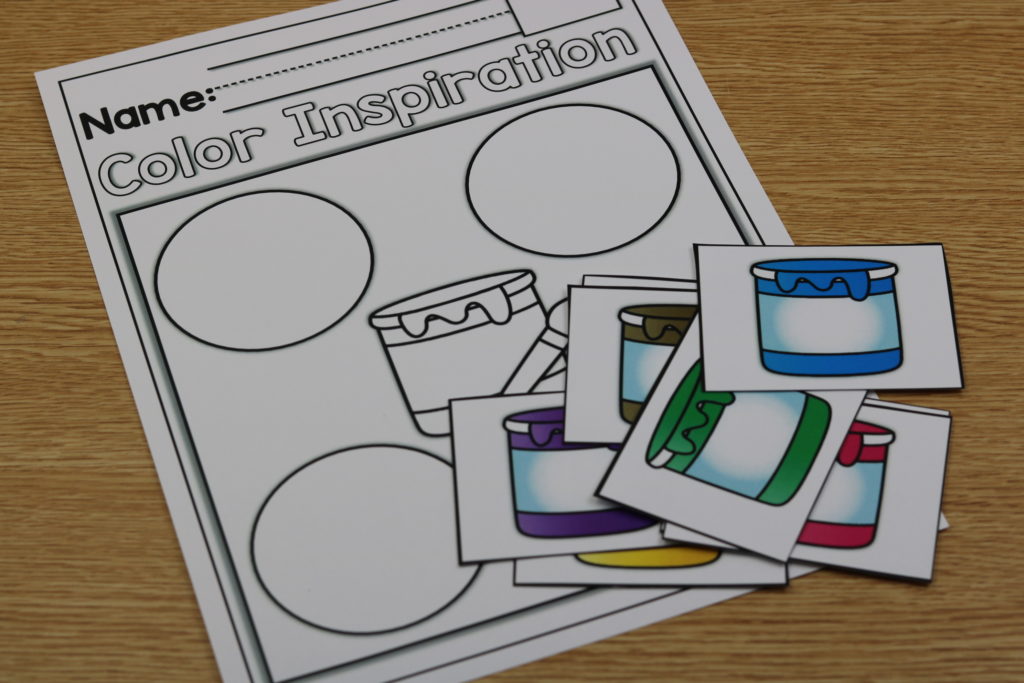
What do writers write about? Well, the write about things they love, things they know, things they can do and things from the past!
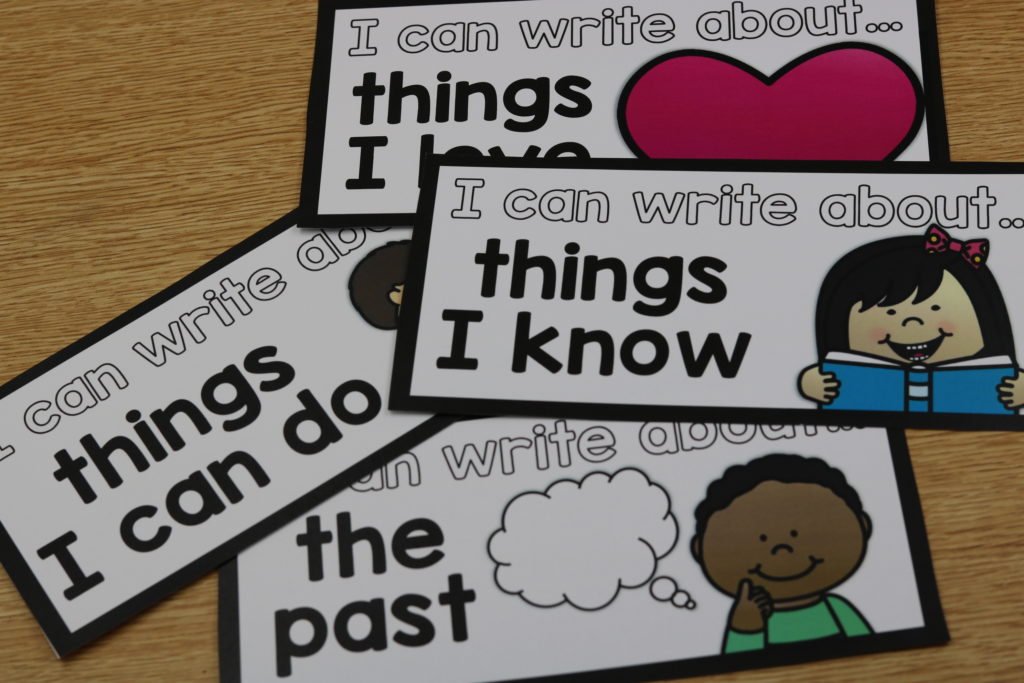
We work on STRETCHING those words!
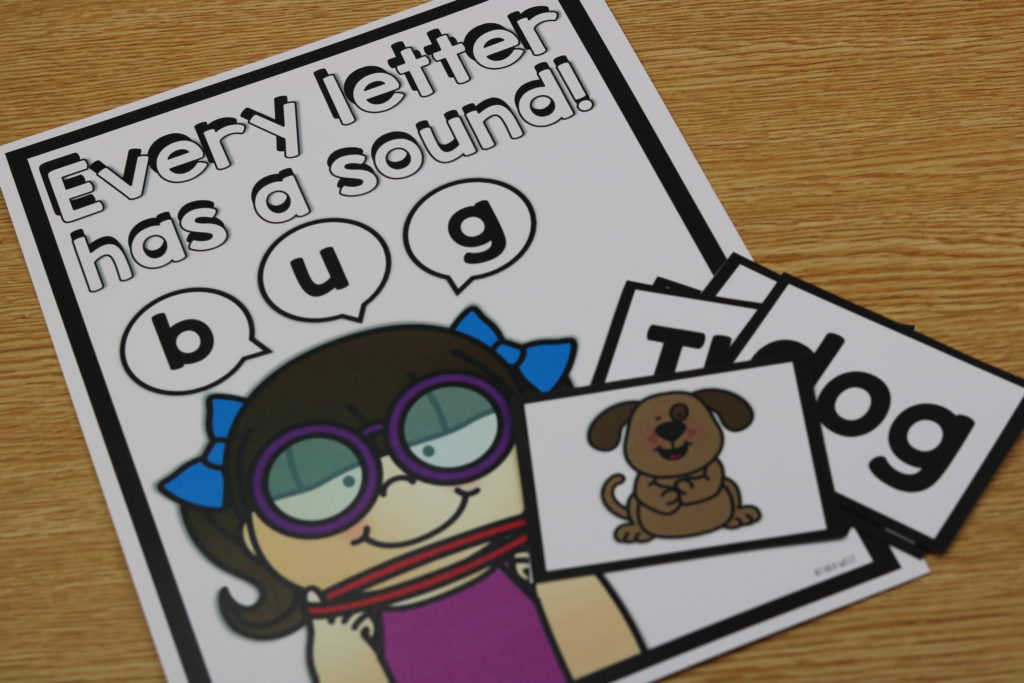
In unit 3, we become mechanics so we can work on all of those important skills, too!

Establishing writing goals are vital!
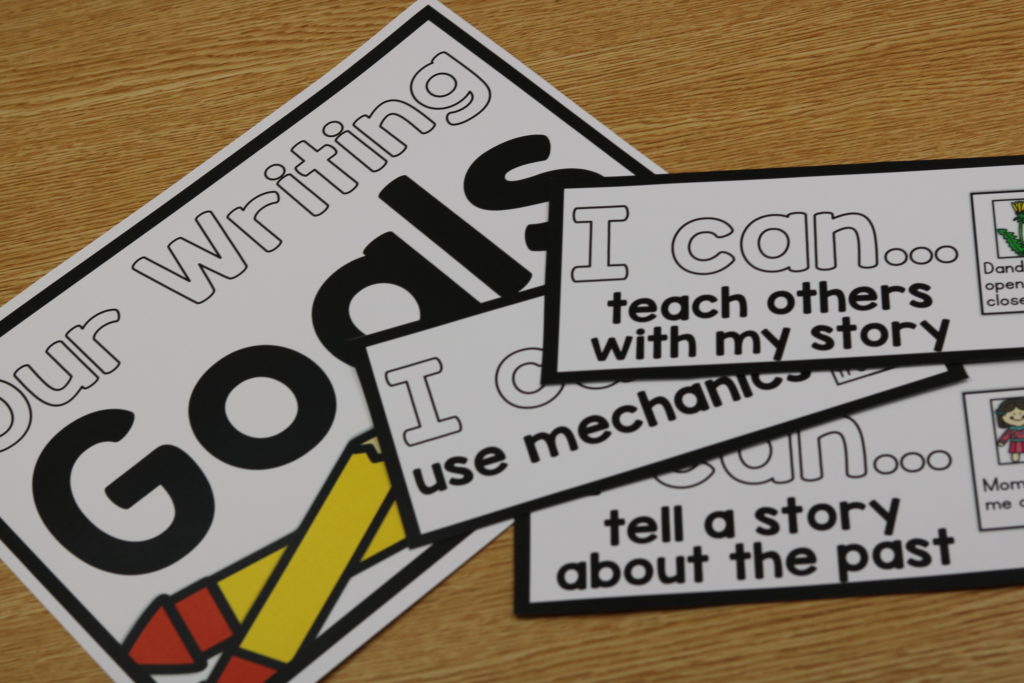
In each unit I supply you with a lot of learning posters to present to the kiddos!
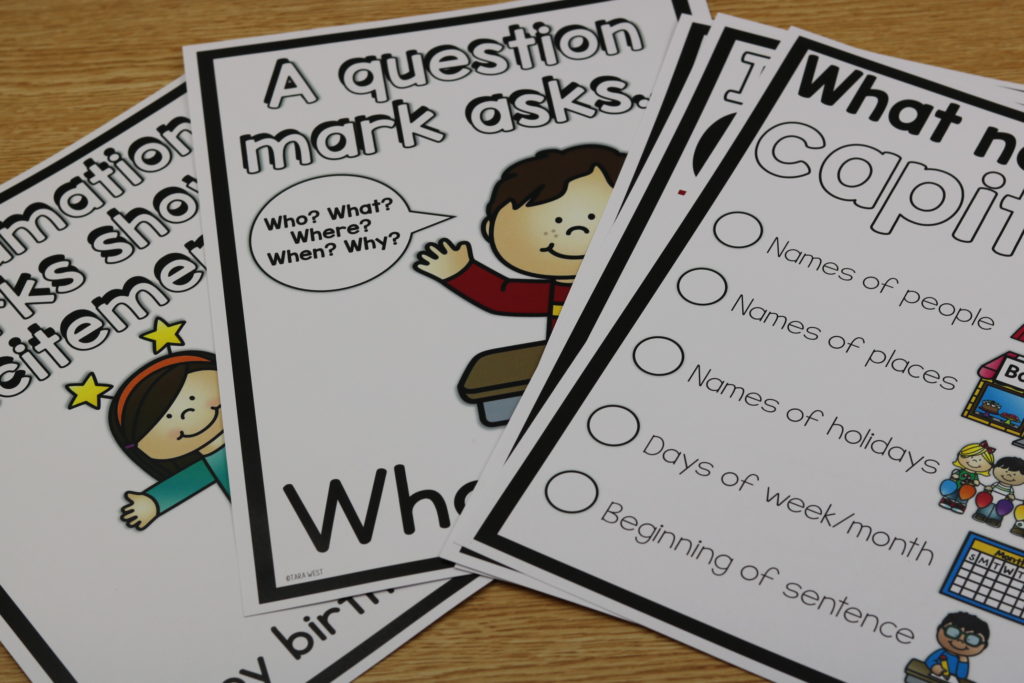
We can’t forget the rubrics in each unit!
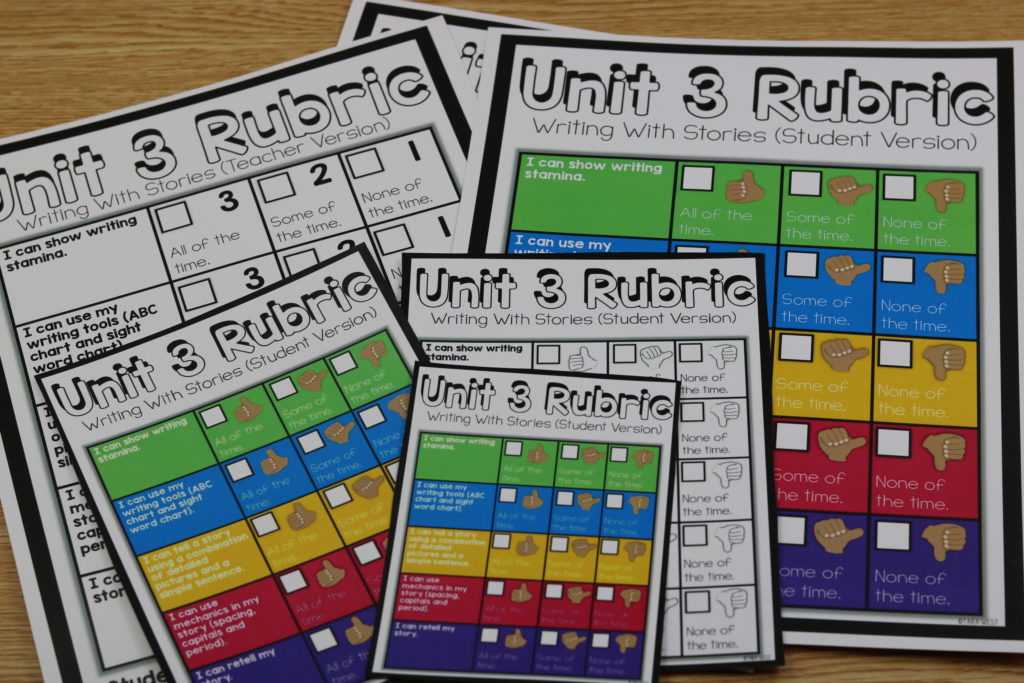
The student resource rings!
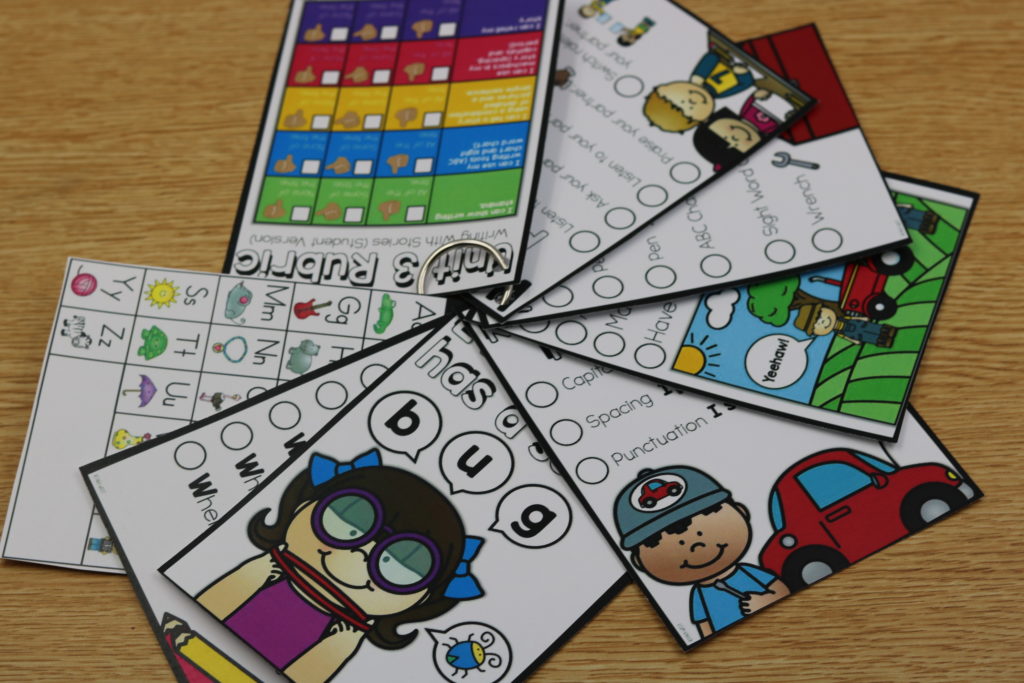
Unit 3 of KinderWriting wraps up the “basics” units! Units 4-9 are genre-based writing units! Let’s jump into those now!
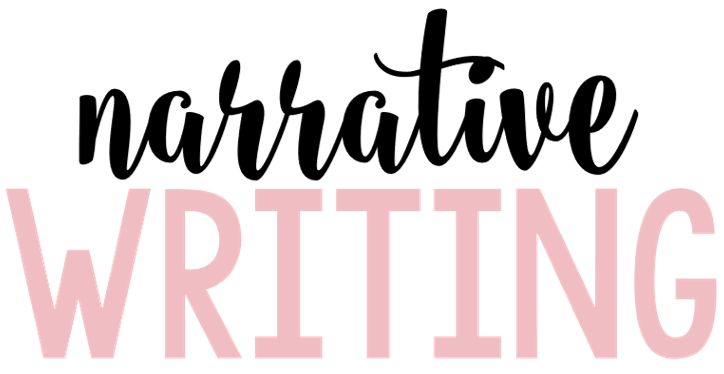
I like to play ninjas.
Also, here is the story booklet we used for this lesson! You can grab yours for free below!
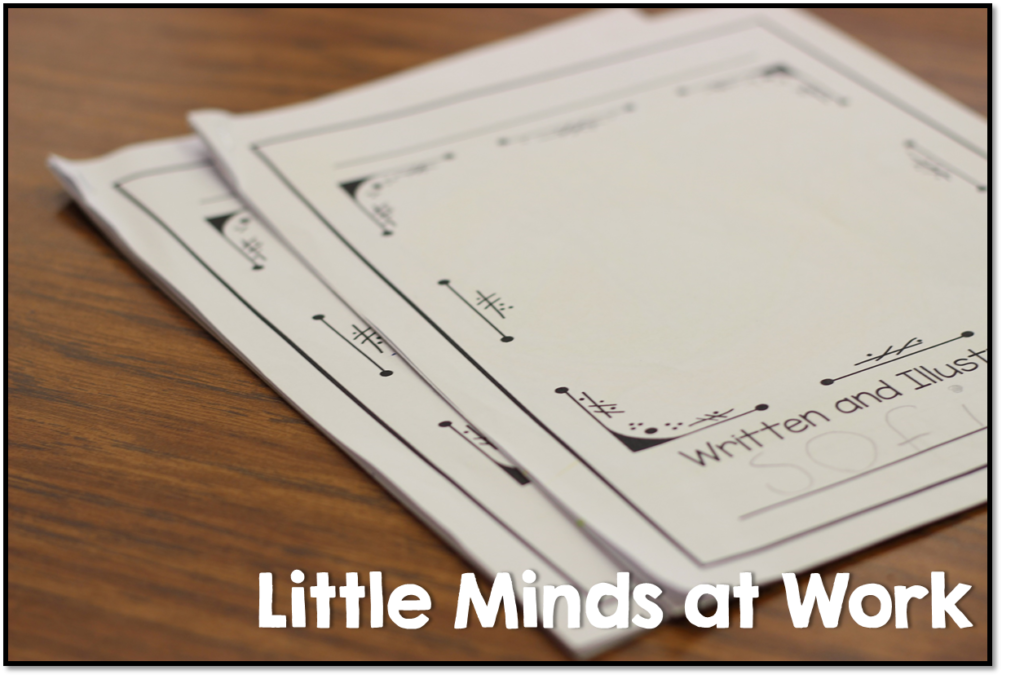
Now let’s talk about Unit 4 of KinderWriting ! Unit 4 is all about Narrative writing! In unit 4, we take take the kiddos through the entire Narrative writing process! There is a week that we spend on mechanics and adding in adjectives/verbs into our stories as well!
Lesson 1: Narrators! Yes? Lesson 2: Narratives Use Words Like I, Me and My Lesson 3: Narratives Have a Setting Lesson 4: Narratives Have a Problem & Solution Lesson 5: Narratives Have a BME Lesson 6: Starting With a Hook Lesson 7: Ending With Feeling Lesson 8: Sequential Words Lesson 9: “Zoom” In Moments Lesson 10: Using Details Lesson 11: Writing With the 5 Senses Lesson 12: Adding in Adjectives Lesson 13: Adding in Verbs Lesson 14: Words Have Families Lesson 15: Mechanics Lesson 16: Narrative Booklets Lesson 17: Writing With a Rubric Lesson 18: Writing Process- Draft Lesson 19: Writing Process- Polish Lesson 20: Writing Process- Publish
Below is a look at the mentor texts for this unit! You can see there are three specific to narrative writing and three for the mechanics focus!
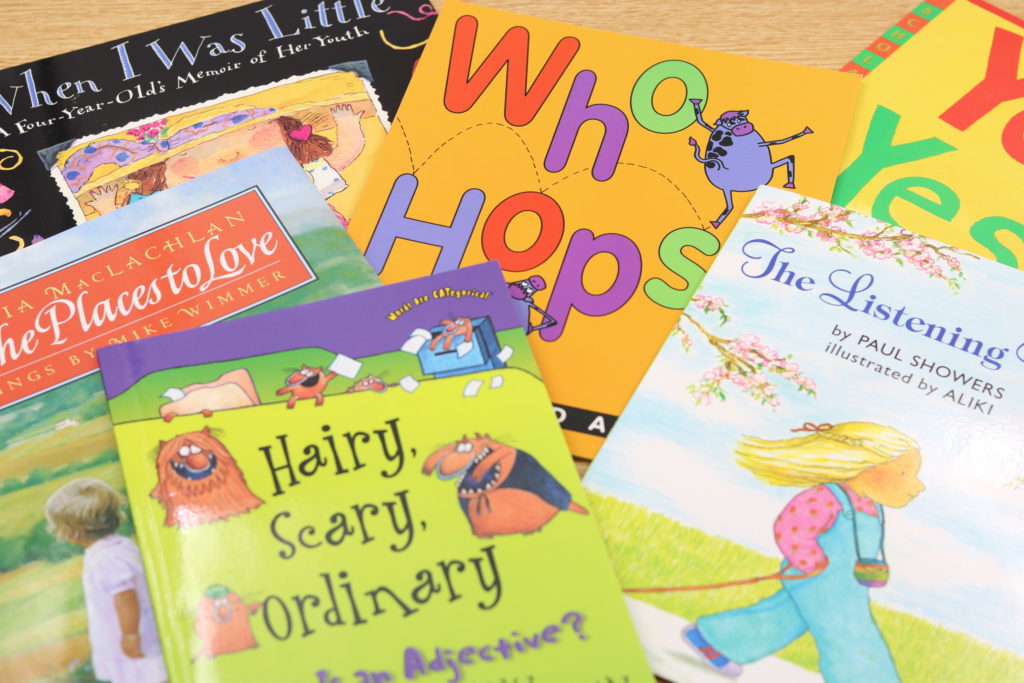
In Unit 4, we discuss all of the parts of a narrative story!
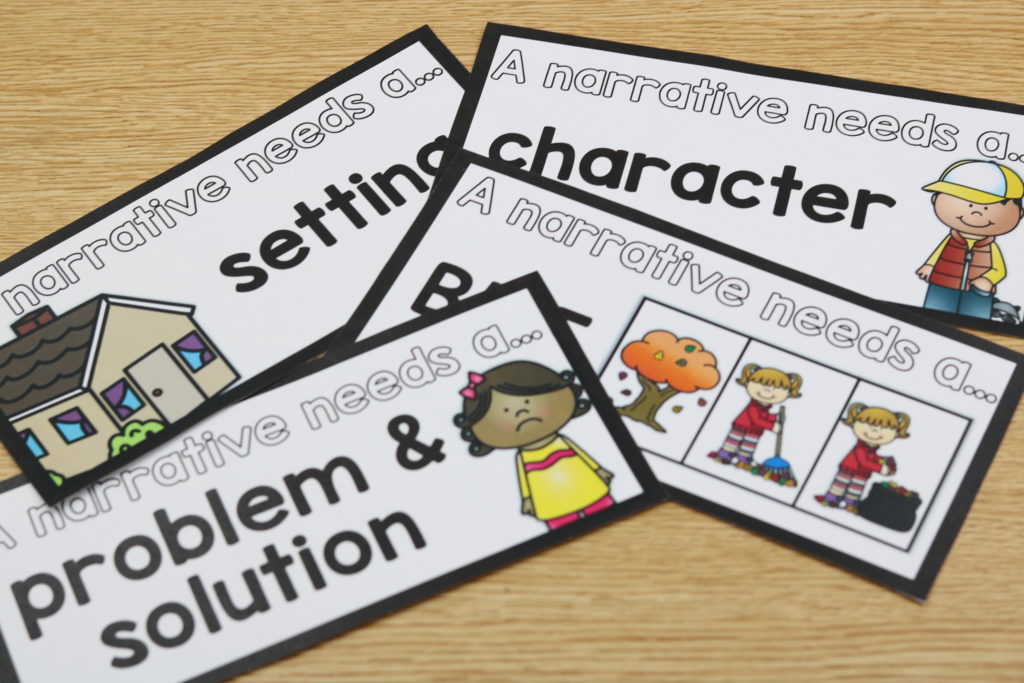
Unit 4 posters to teach all of the important tasks!
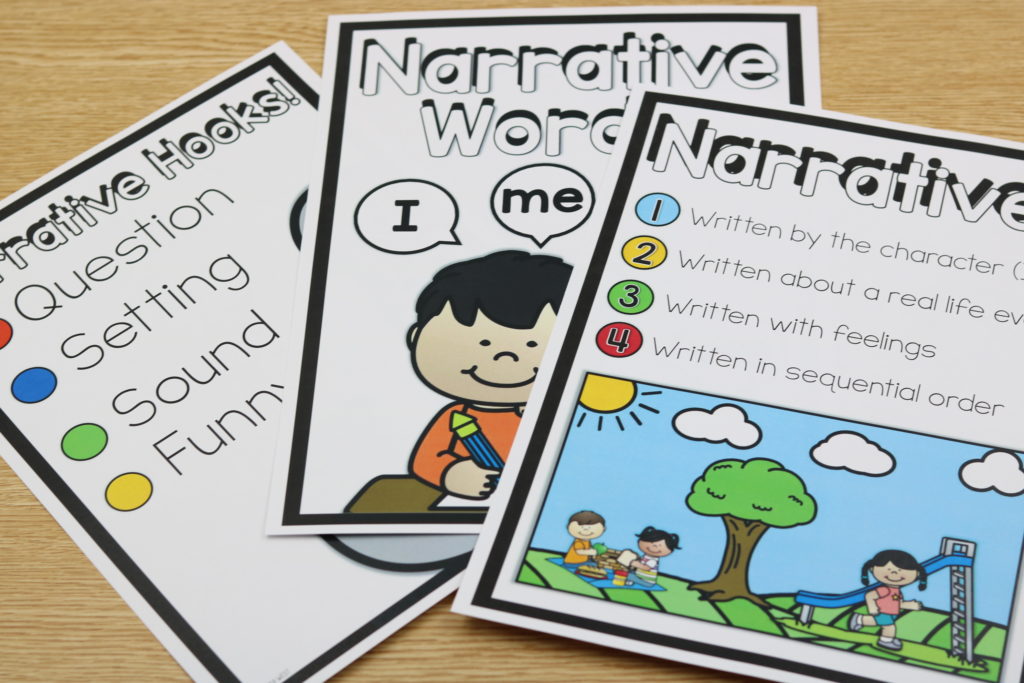
Unit 4 rubrics!
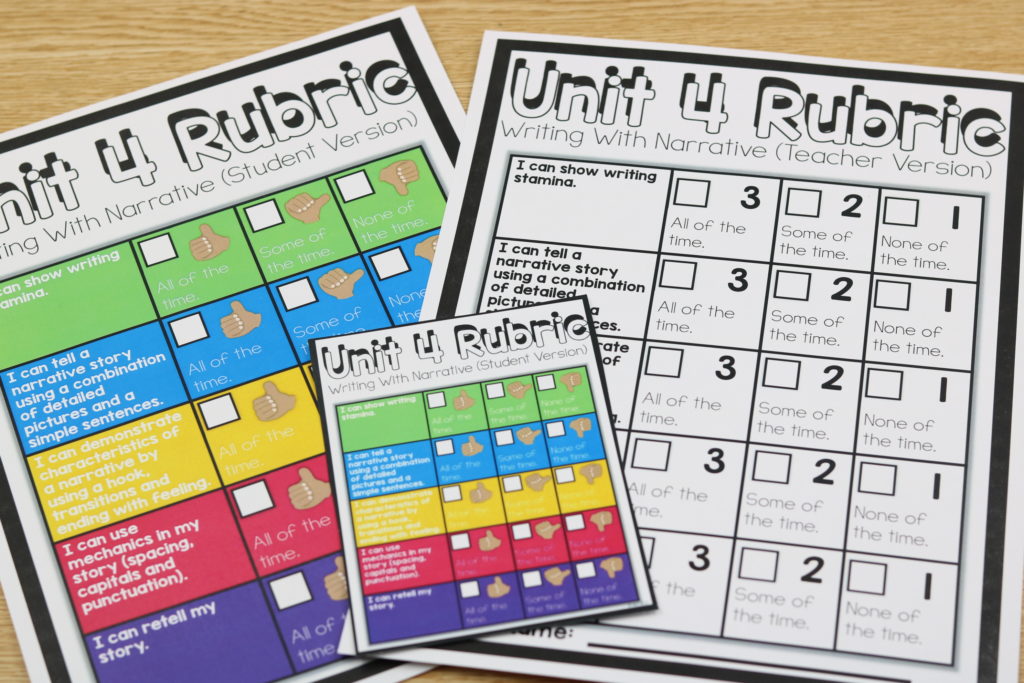
Student resource rings!
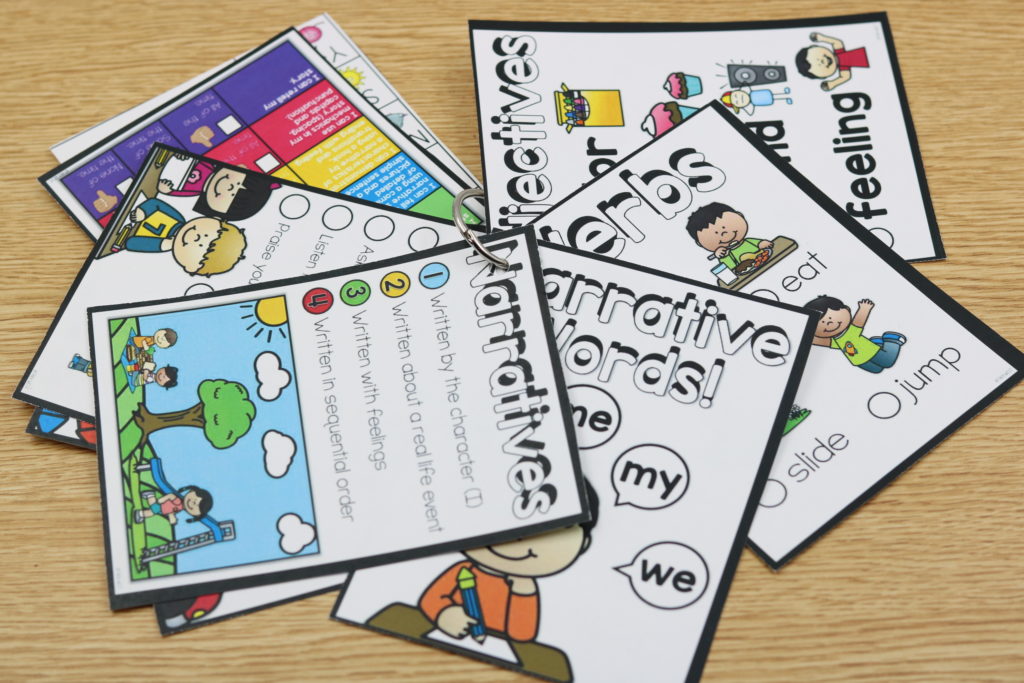
Unit 4 writing goals!
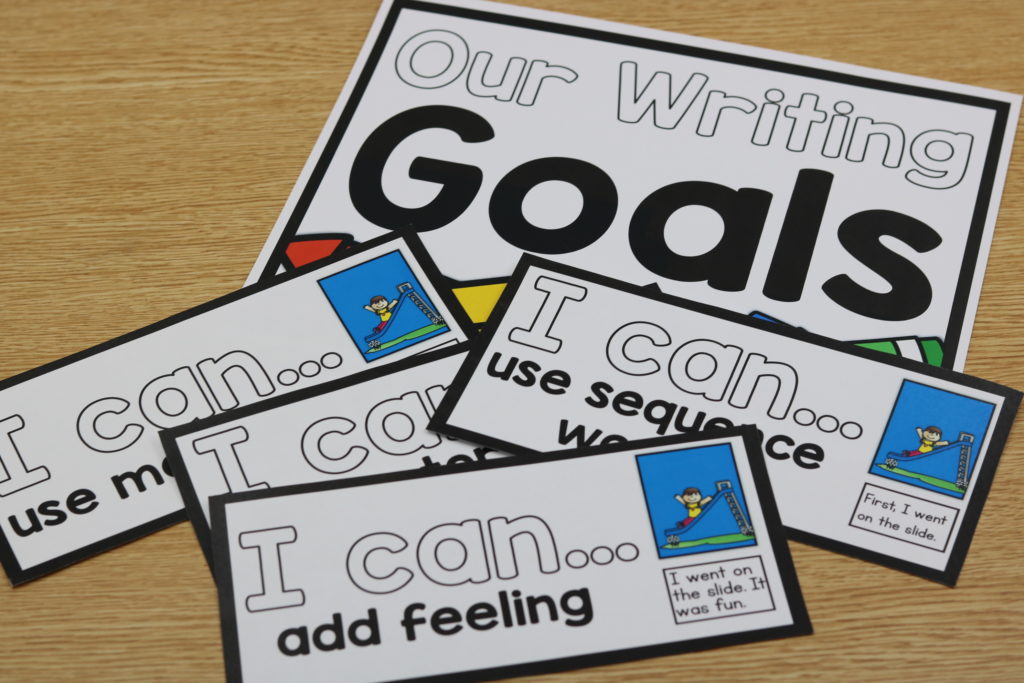
Now let’s talk opinion writing! I will discuss first some of my favorite opinion writing lessons over the years and then jump into opinion writing from KinderWriting! I love introducing the kiddos to the big word for our opinion writing, because! I always give a big hoopla over making sure we pronounce it correctly! This might not be an issue in other parts of the country, but here in Missouri it’s usually pronounced as “becuz!” So, after this talk they are correcting me the rest of the year if my pronunciation isn’t spot on! We start with some simple opinion writings! We also talked a lot about what an opinion is and how it’s okay to have a different opinion then our friends!
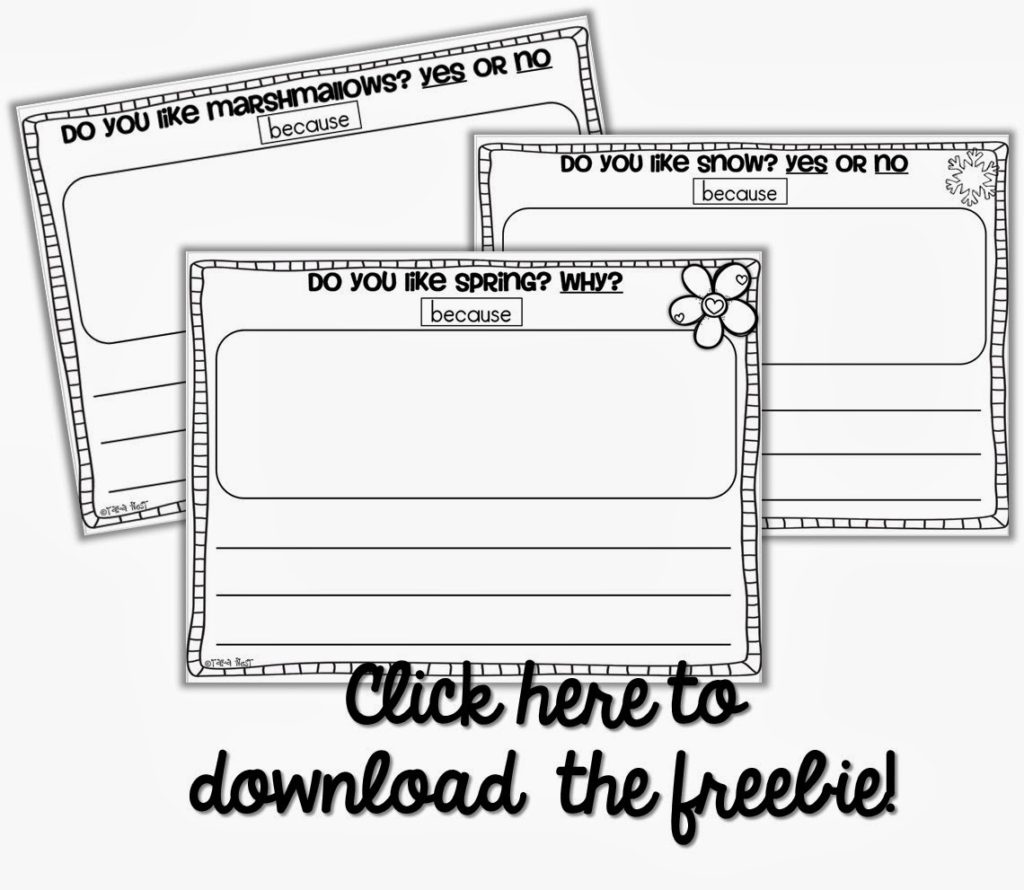
We also write opinions on if we like the tooth fairy best or Santa Claus! Below students wrote their thoughts in the opinion graphic organizer! {Download the freebie below}
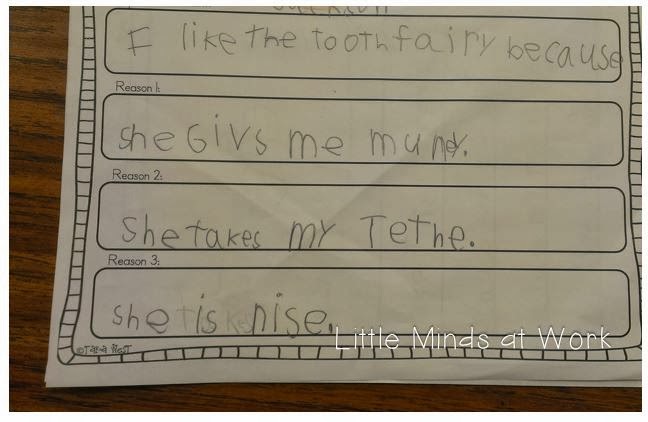
Let’s talk KinderWriting Unit 5 which is all about opinion writing!
Lesson 1: Opinionators! Yes? Lesson 2: Giving Opinions Lesson 3: Fact vs. Opinion Lesson 4: Opinions Around Us Lesson 5: Opinions on the Spot Lesson 6: Using the Word Because Lesson 7: Giving Two Reasons Lesson 8: Using a Mentor Text Lesson 9: Opinion Starters Lesson 10: Defending an Opinion Lesson 11: Using the Word Wall Lesson 12: Spacing for Our Readers Lesson 13: Setting Letters on the Line Lesson 14: Reversals and Handwriting Lesson 15: Sounds in Words Lesson 16: Sharing Opinions Lesson 17: Writing With a Rubric Lesson 18: Writing Process- Draft Lesson 19: Writing Process- Polish Lesson 20: Writing Process- Publish
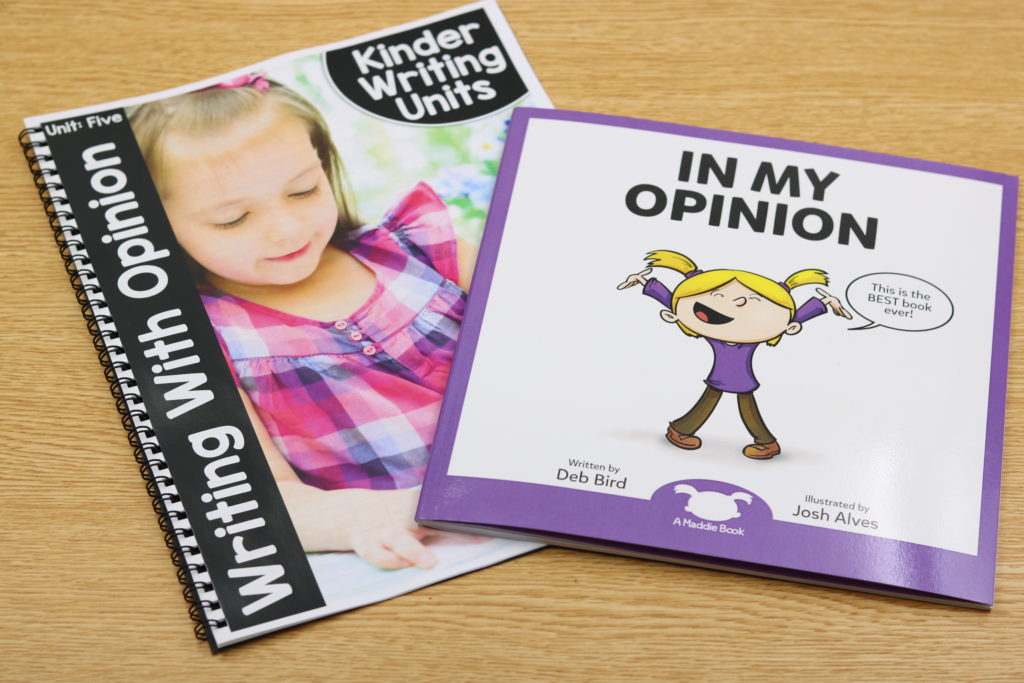
Unit 5 writing posters!
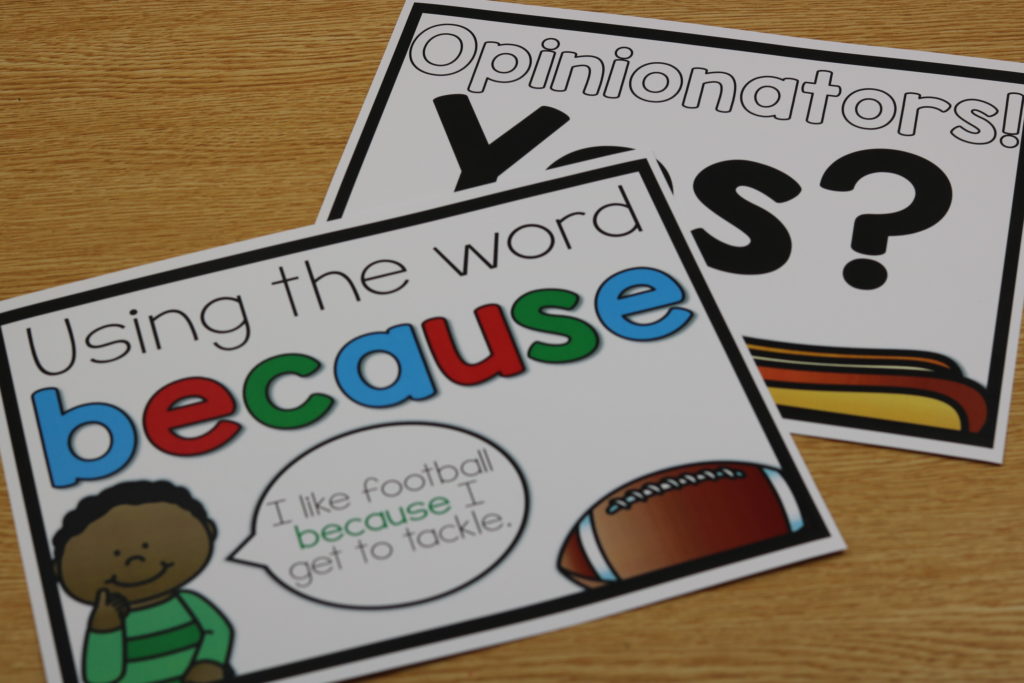
Unit 5 rubrics!
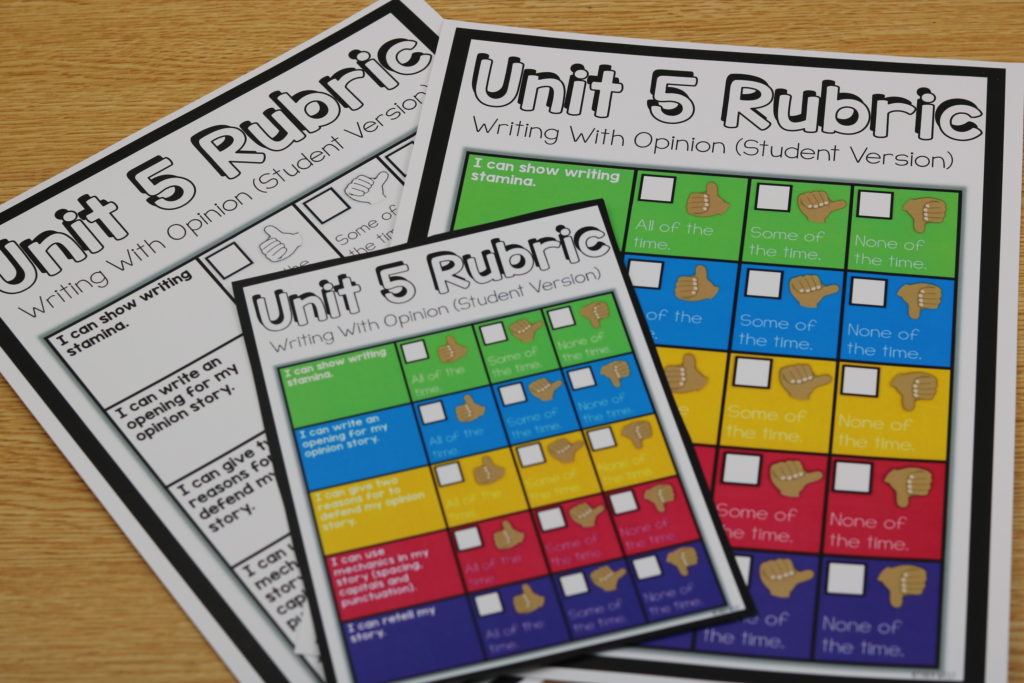
Writing goals are a must!
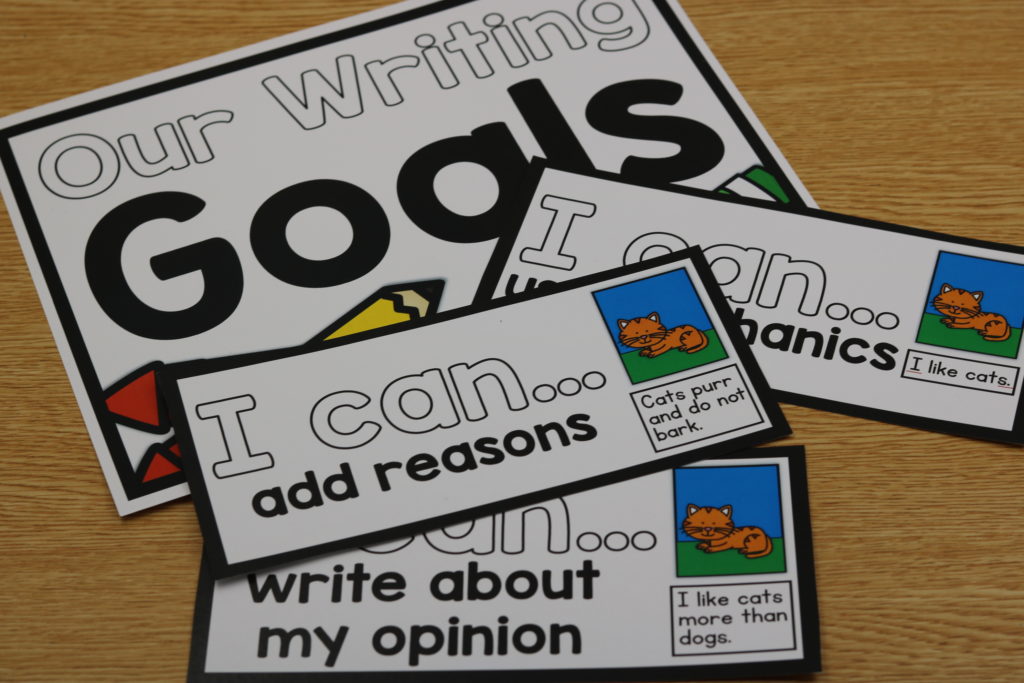
In unit 5, we work on fact vs. opinion!
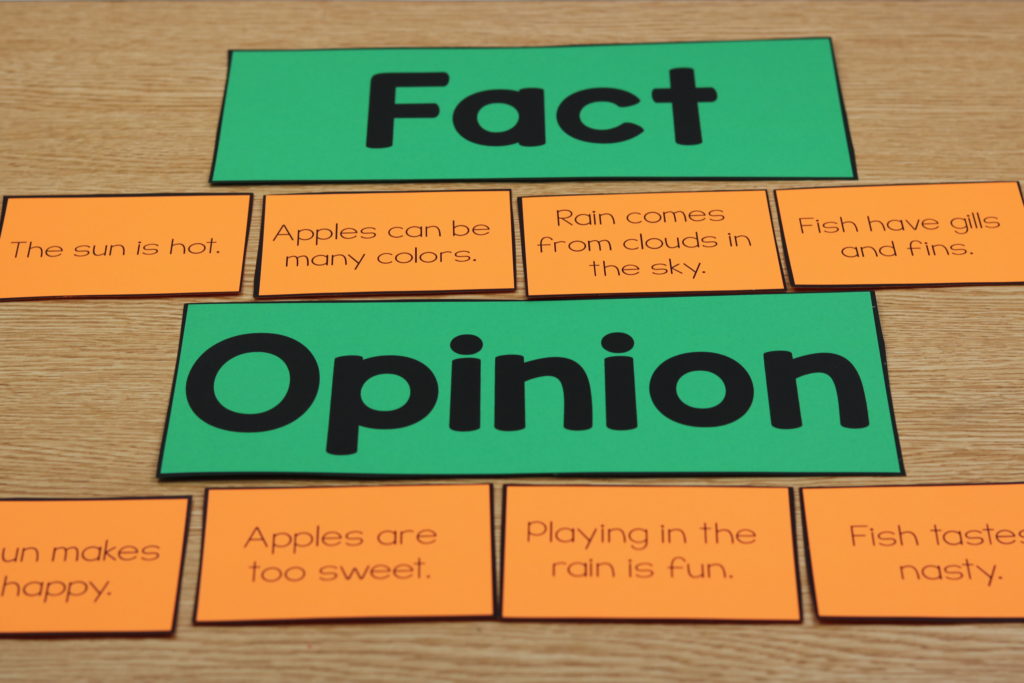
Unit 6-9 (Procedural writing, persuasive writing, fiction writing, informational writing) are also part of the KinderWriting bundle!
A note about pricing!
Snag this bundle for 25% OFF . Each of the writing units sells for $12 each, a total of $108. You can view KinderWriting HERE or clicking below!
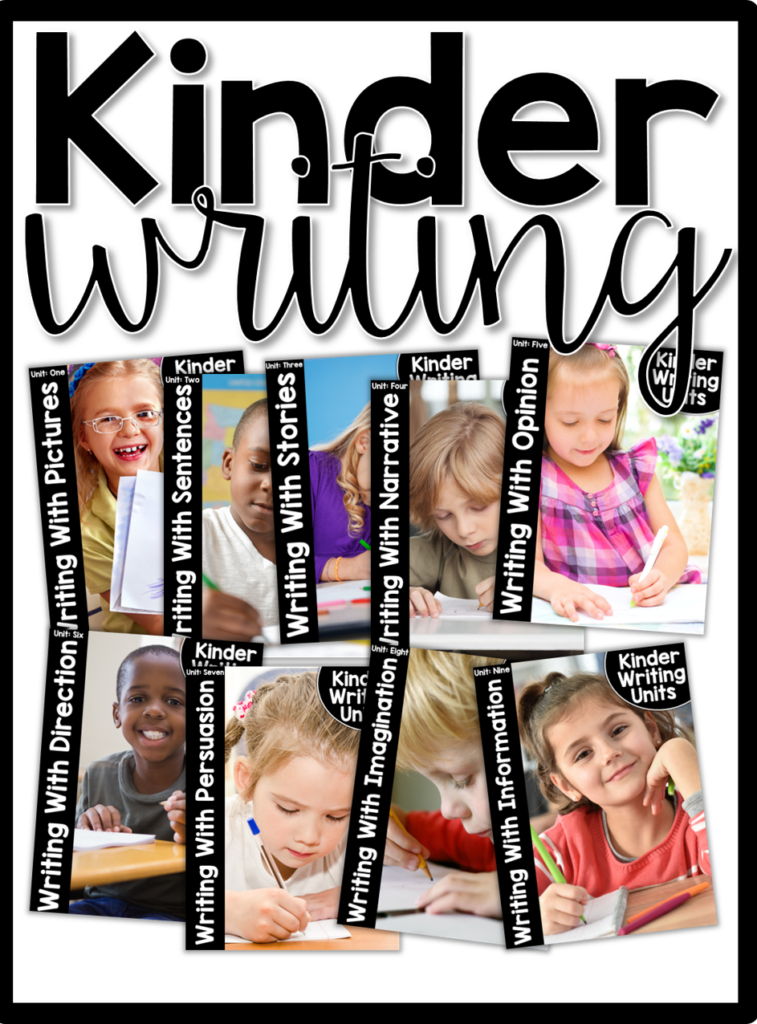
Now let’s talk letter writing! Depending on your district/standards, you might also be required to teach letter writing!

Now let’s talk a little about assisted writing! I like to use assisted writing sheets mainly during independent writing times! This would be for example during daily five work on writing! My kiddos can’t get enough of my writing story starters! I use them in their work on writing folders and as a choice for early finishers! I have found these story starters to work absolute wonders in my classroom! What I love about the story starters the most is their ability to assist the students when working independently. Students WANT to work without the assistance of their teacher, but sometimes they just don’t know how. This can be especially true in writing. Students of course would love to write a story of their own, but they at times don’t know what to write about. The story starters take that out of the equation. Students simply look at the picture given to them and start to write their story!
I like the spider and web.
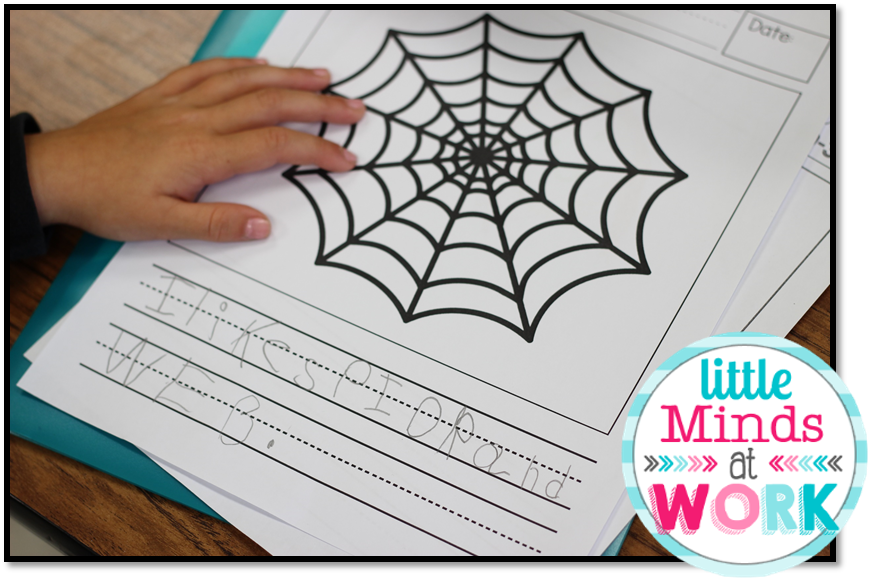
You can download an additional set of freebie writing posters HERE or clicking the images below!
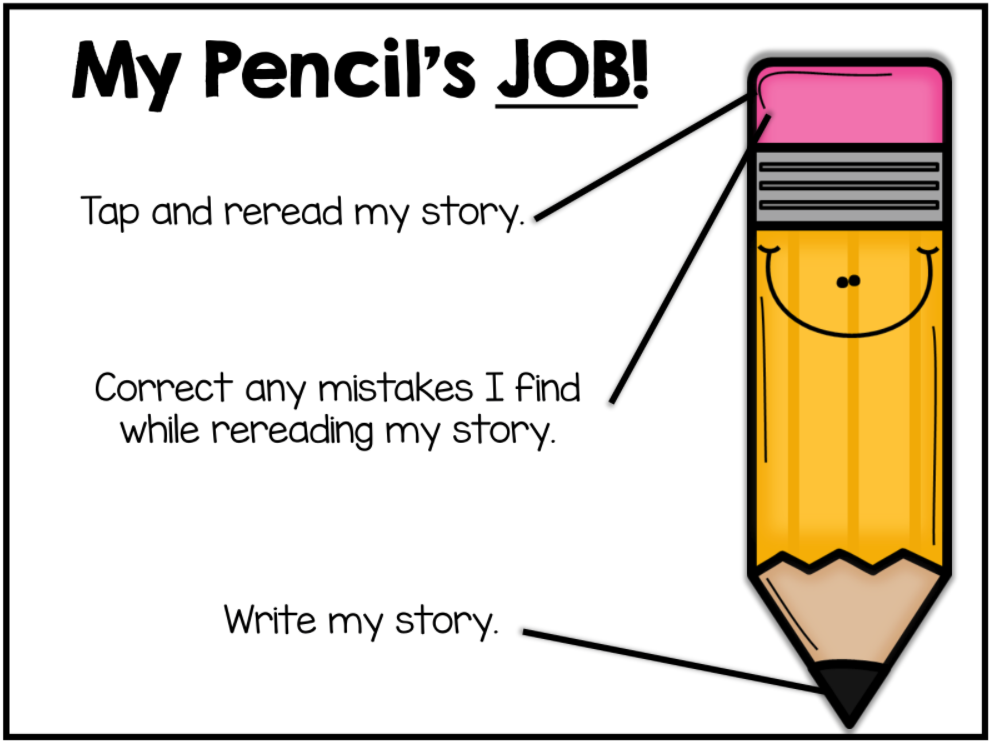
Well I hope you enjoyed these freebies! Leave me some love if you were able to use any of these and feel free to pass them along! 🙂
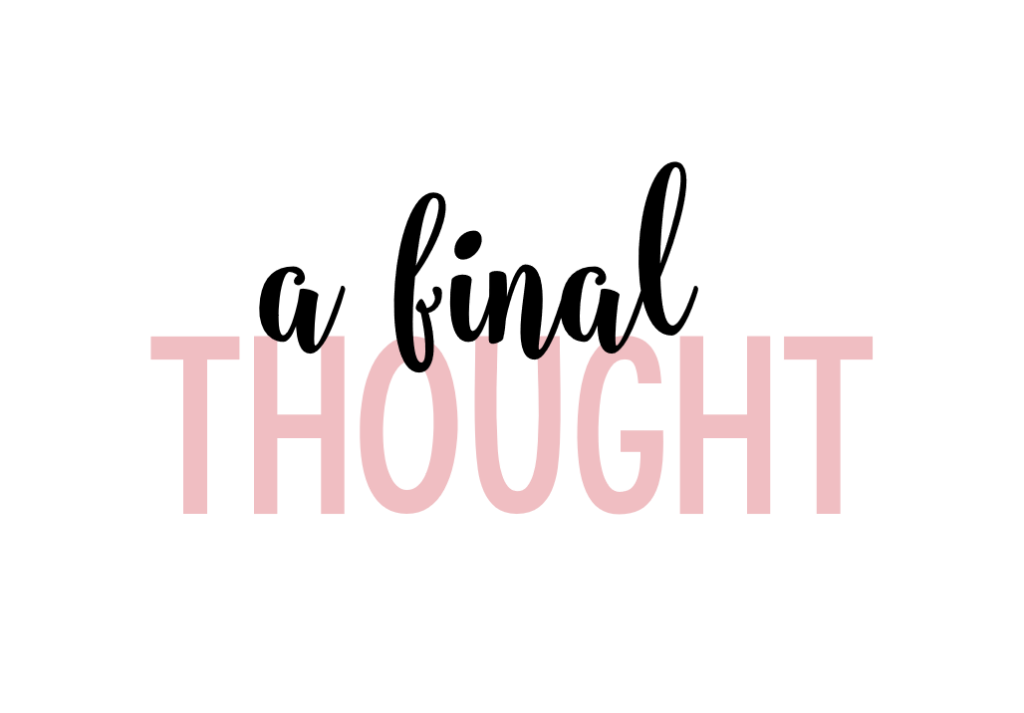
If you’re unsure if KinderWriting would work in your classroom, I recommended that you take a moment to read TEACHER feedback here ! There is no one that will tell you more accurately than fellow teachers!
Snag this bundle for 25% OFF . Each of the writing units sells for $12 each, a total of $108. You can view KinderWriting HERE or clicking below!
Do you teach first grade? Snag the FirstieWriting curriculum HERE .
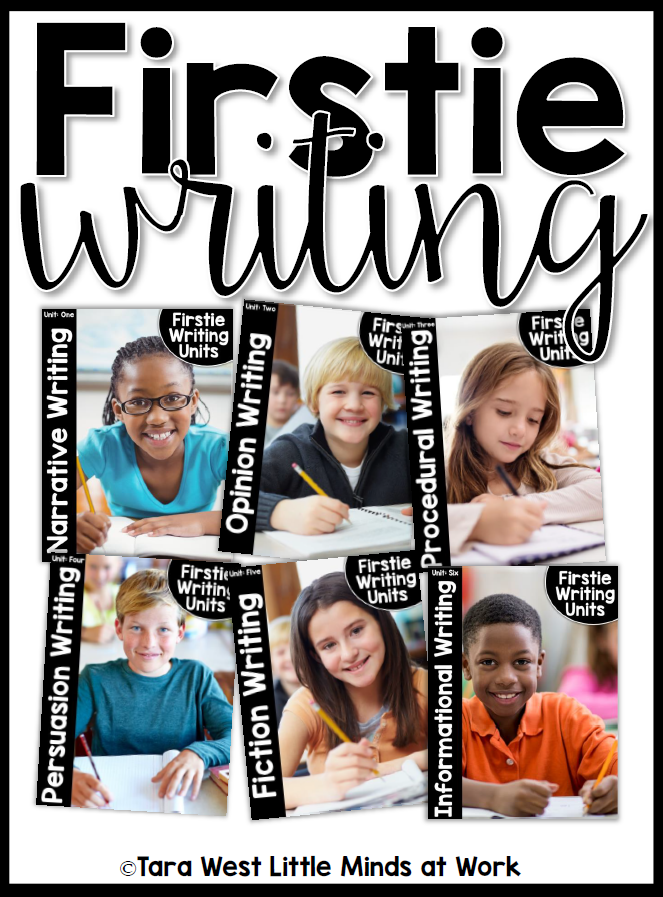
Leave a Reply Cancel reply
You must be logged in to post a comment.
- Grades 6-12
- School Leaders
FREE Poetry Worksheet Bundle! Perfect for National Poetry Month.
25 Fun Kindergarten Writing & Storytelling Prompts (Free Printable!)
To help you get them writing from the get-go.
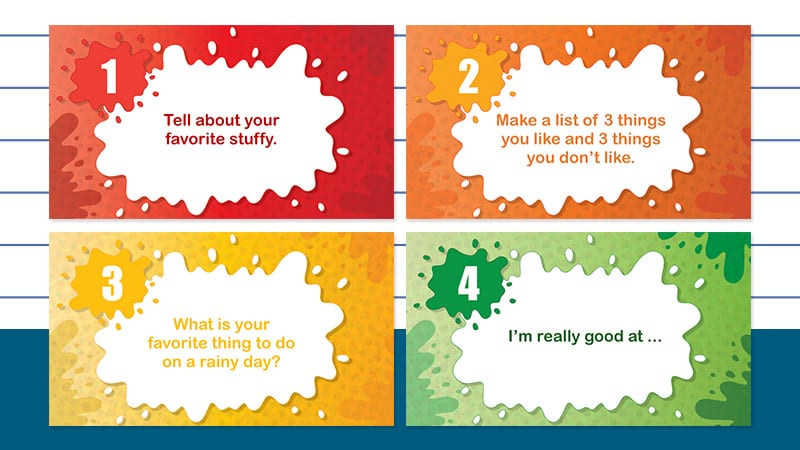
Most kindergartners are just learning how to put letters and words together, but that doesn’t mean they can’t be writers. What they lack in technical ability, they more than make up for with creativity and imagination. Plus, kindergartners usually have lots to say! Kindergarten writing prompts, often called story starters, help young writers focus on a single topic as they develop writing skills. Topics should be broad enough that every child can easily think of something to write about and interesting enough that they stay engaged. Developing a daily writing routine helps kindergartners develop confidence as they learn to articulate their thoughts in a structured way.
The following writing prompts are designed to spark your kindergartners’ imaginations and get them writing! And they are perfect for in-person or virtual learning.
(Want this entire set in one easy document? Get your free PowerPoint bundle by submitting your email here, so you’ll always have the challenges available!)
1. Tell about your favorite stuffy.
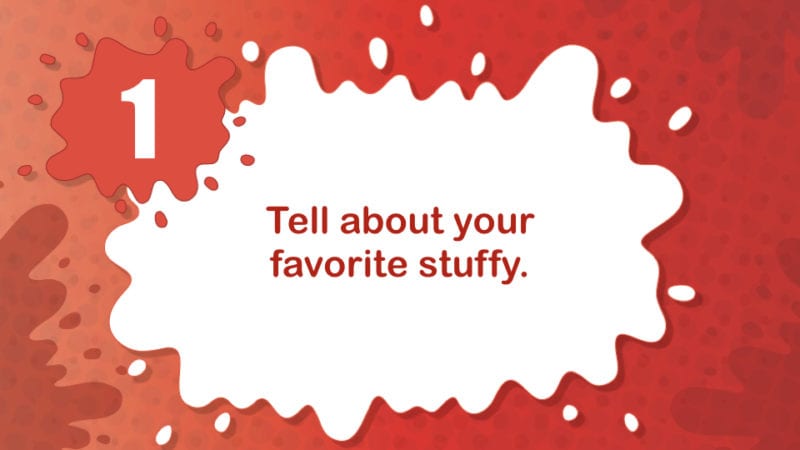
2. Make a list of 3 things you like and 3 things you don’t like.
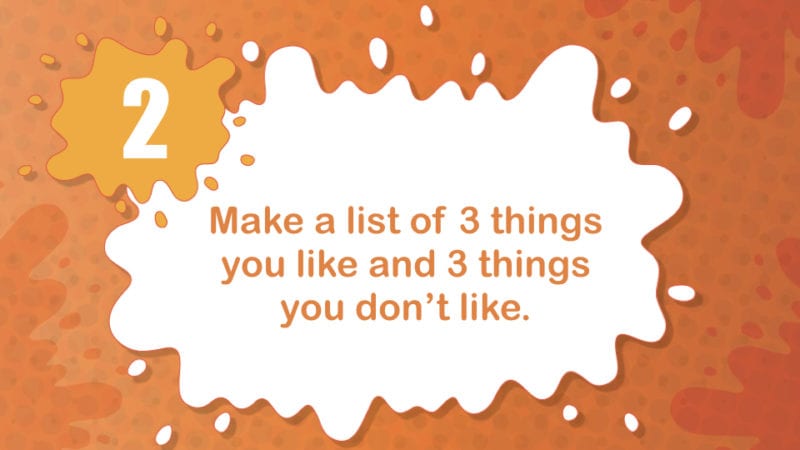
3. What is your favorite thing to do on a rainy day?
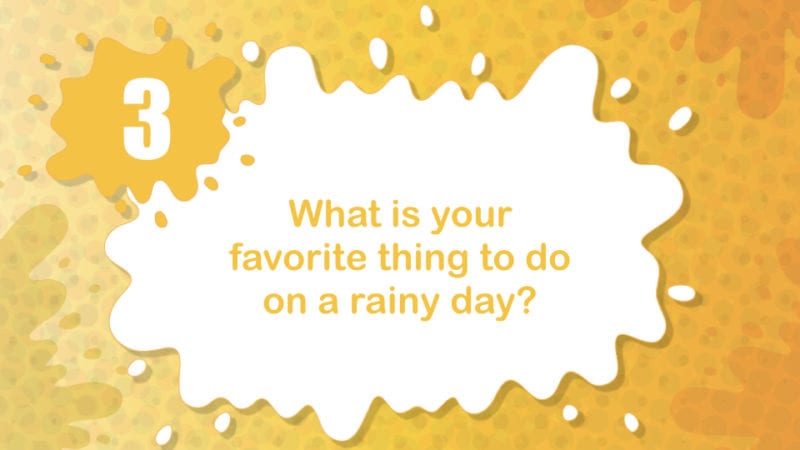
4. I’m really good at …
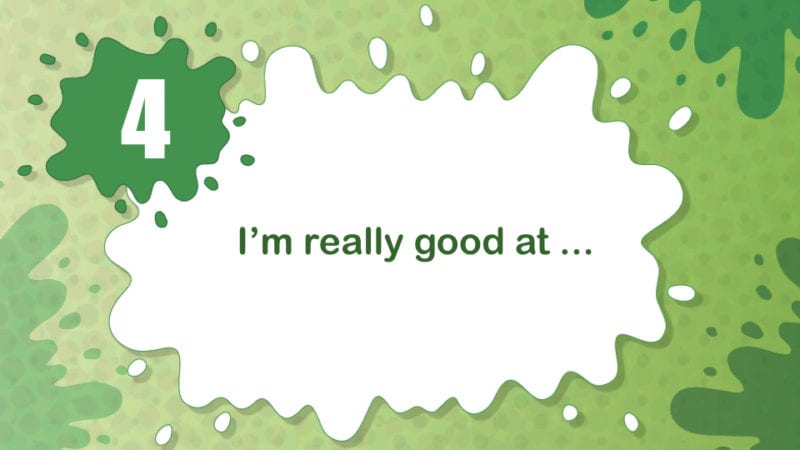
5. If I could fly …
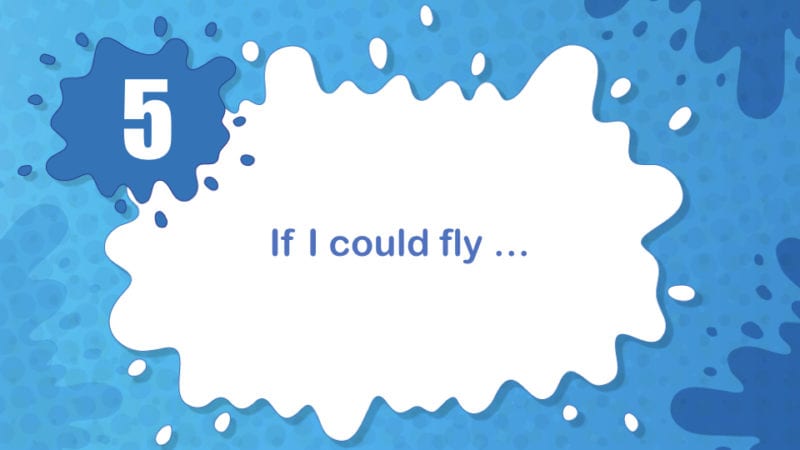
6. Describe an interesting place you’ve visited.
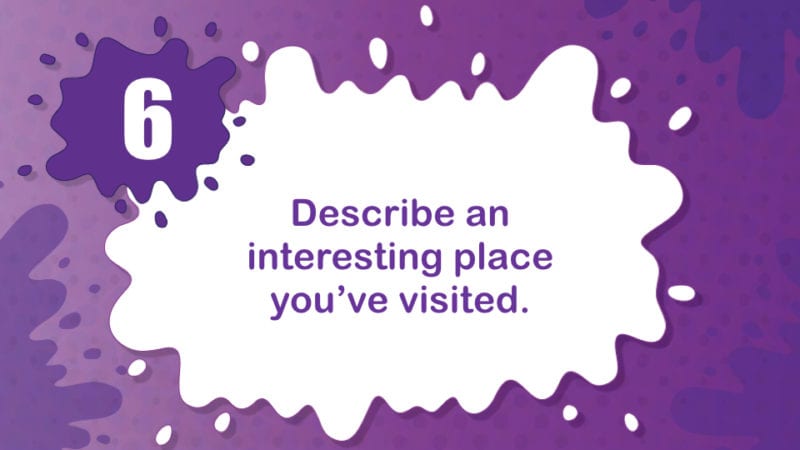
7. Something I like to do that makes me happy is …
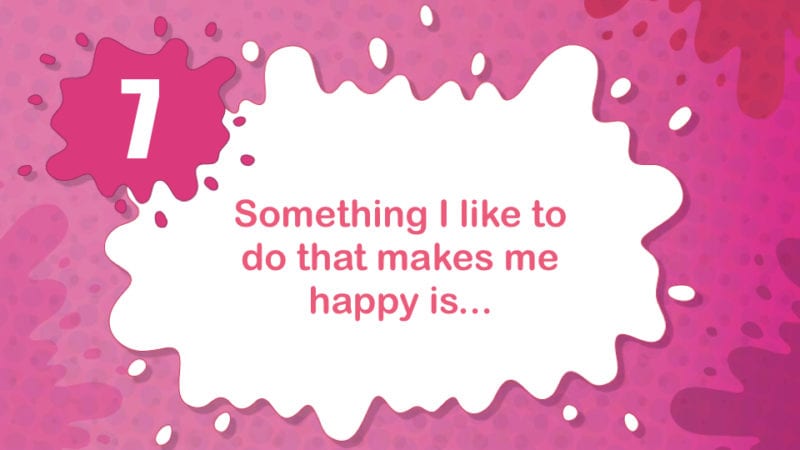
8. Do you prefer to play inside or outside? What do you do there?
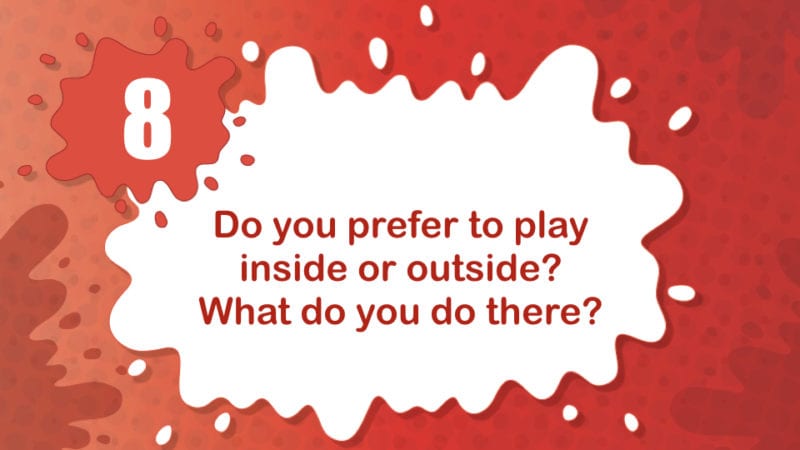
9. What is your favorite season and why?
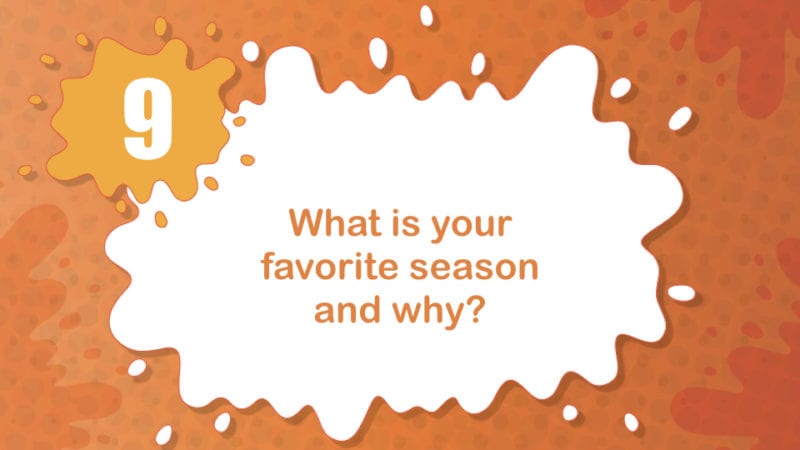
10. The best part of being in kindergarten is …
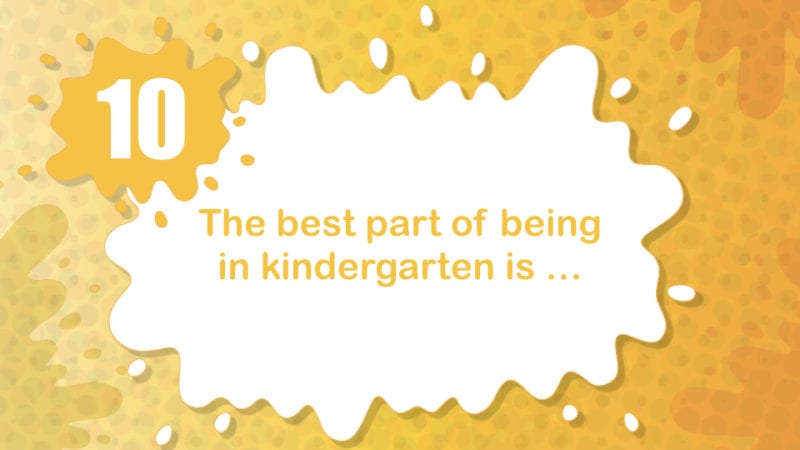
11. If I were a superhero my superpower would be …
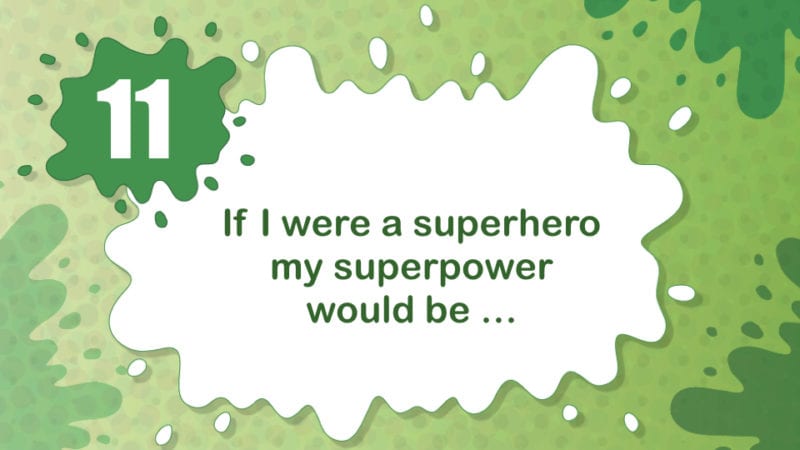
12. When I am 100 years old …
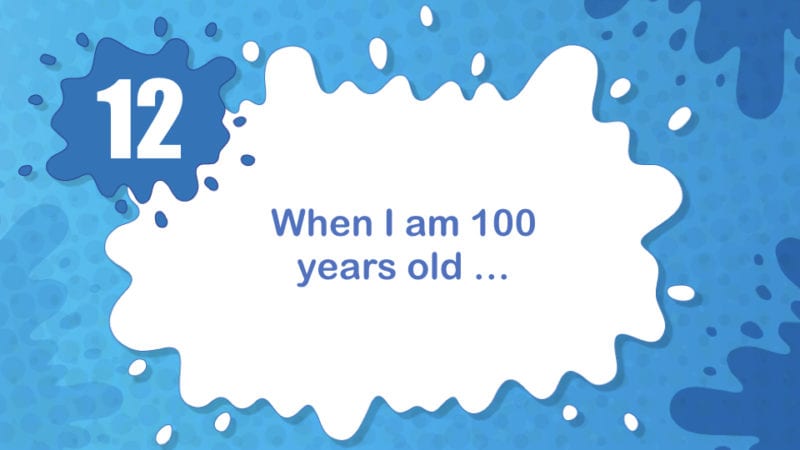
13. When I was a baby …
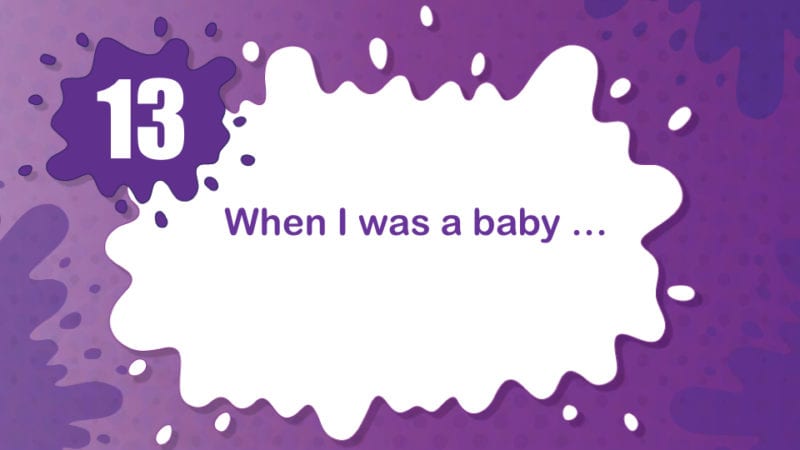
14. My favorite part of the school day is …
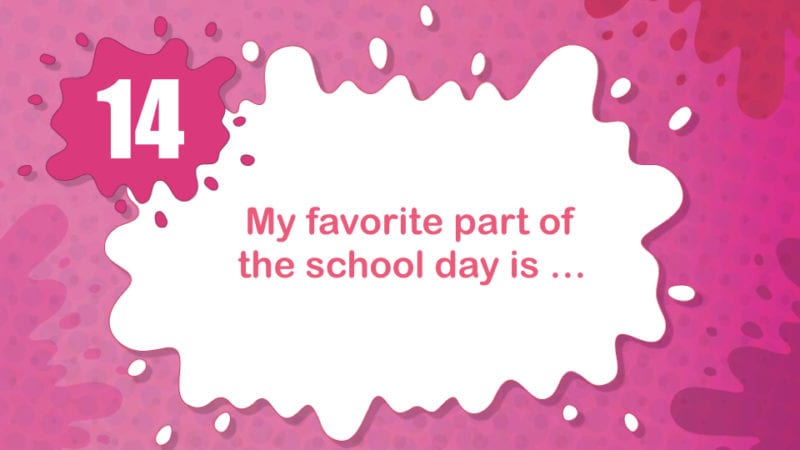
15. Tell about a time you were a good helper.
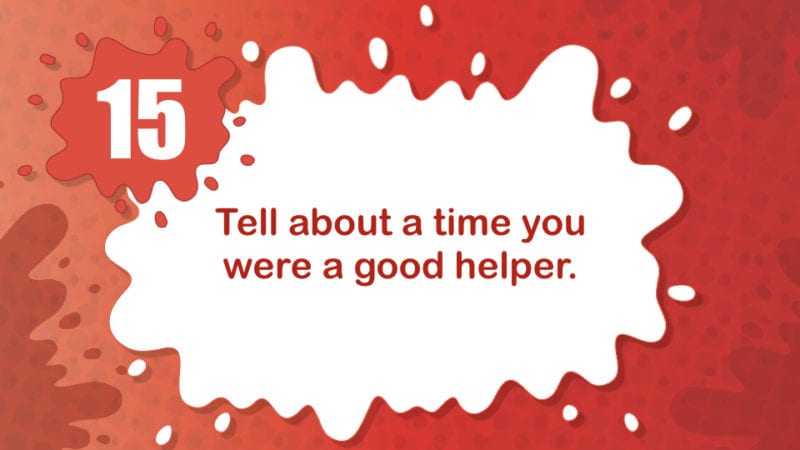
16. What is one activity you like to do with your family?
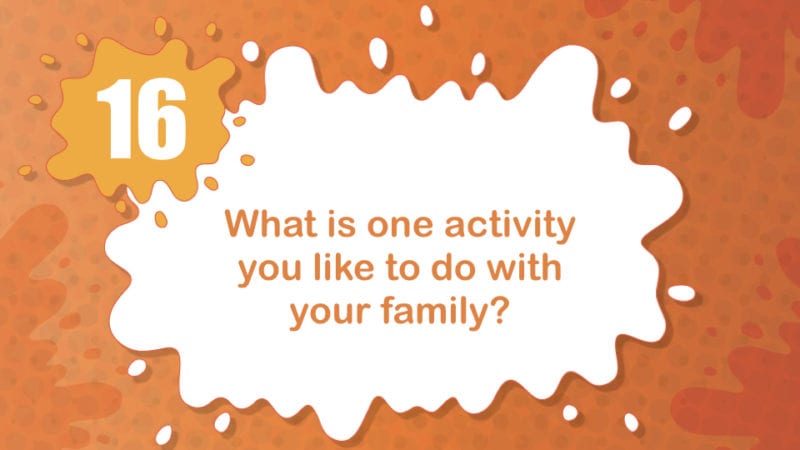
17. Tell about your best friend.
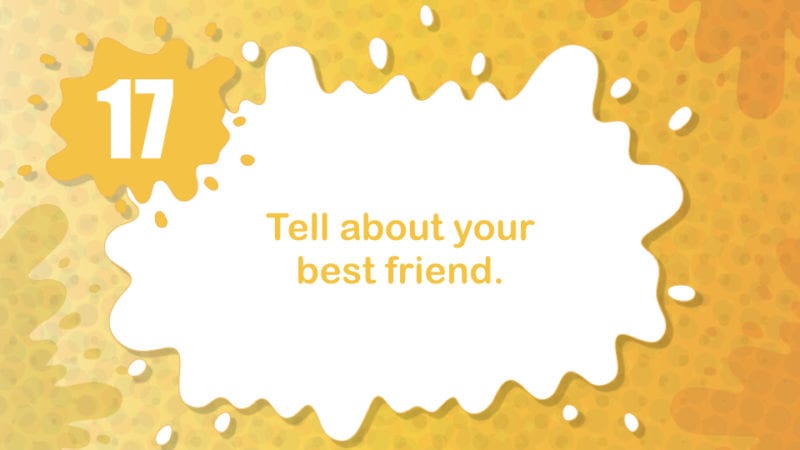
18. My mom (or dad) always …
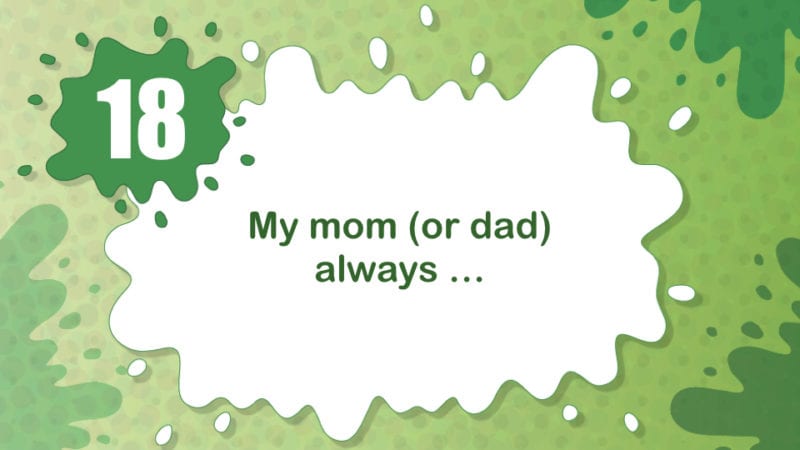
19. My favorite animal is _____ because …
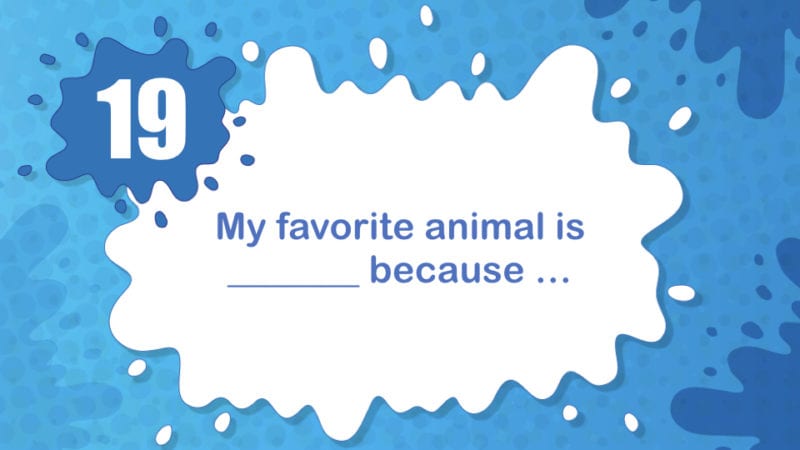
20. Once upon a time …
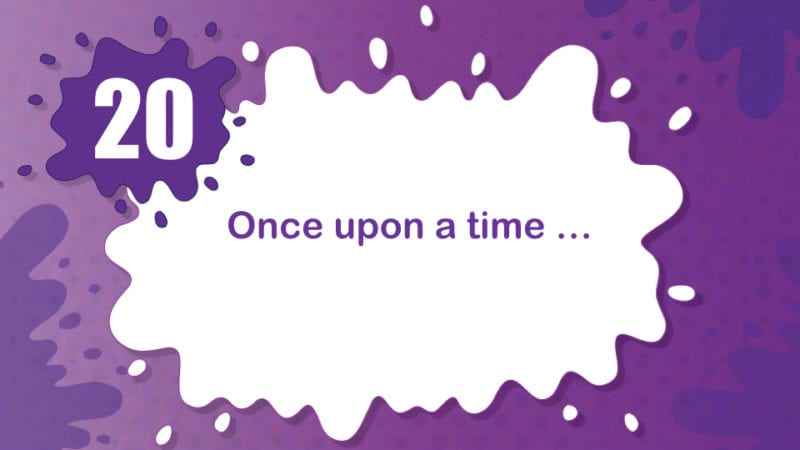
21. If you made dinner for your family what would you make?
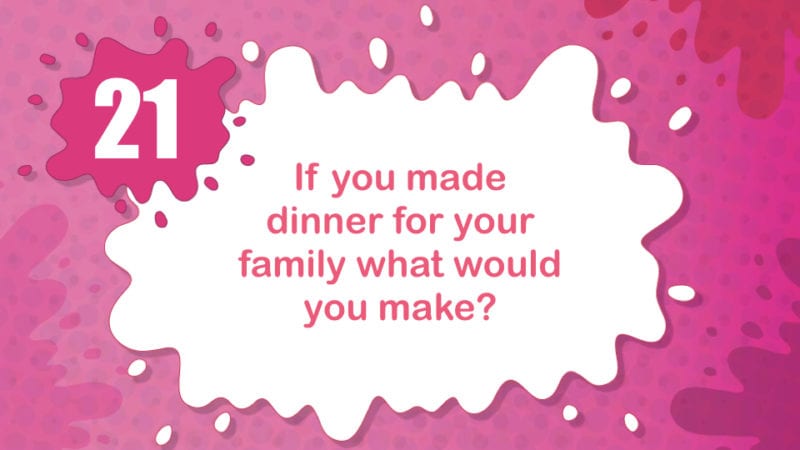
22. What is your favorite color? Name 3 things that are that color.
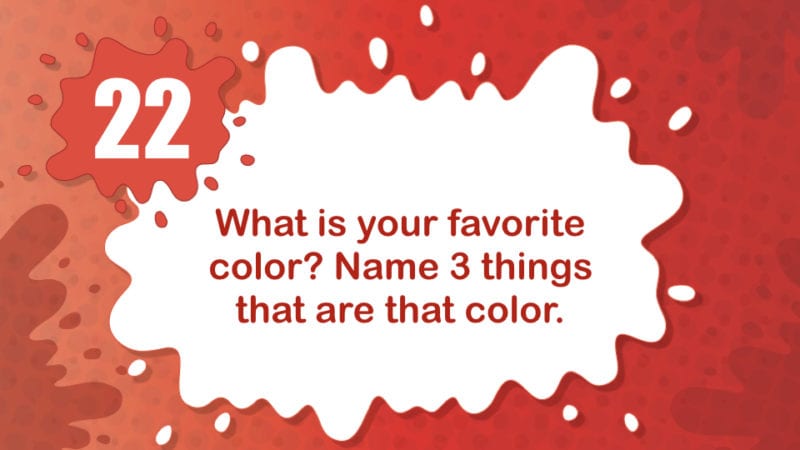
23. If you had 3 wishes, what would you wish for?
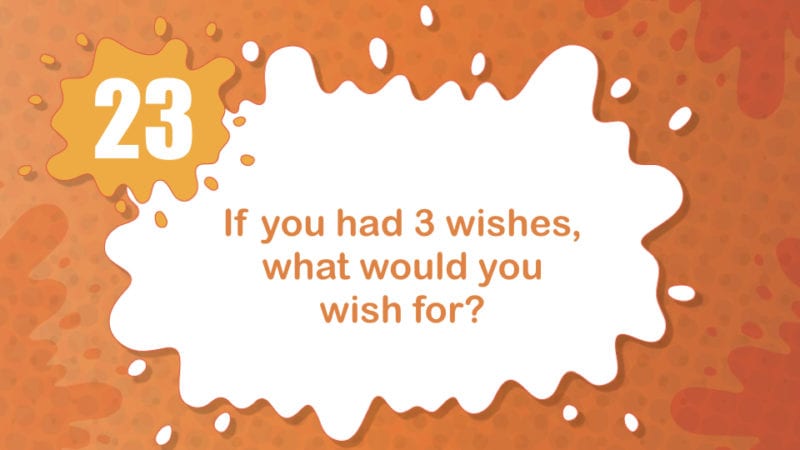
24. What makes you giggle?
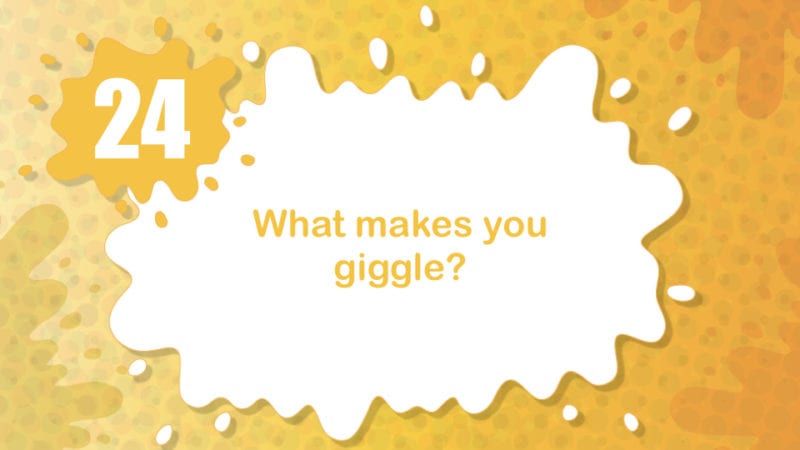
25. Tell me about your favorite book.
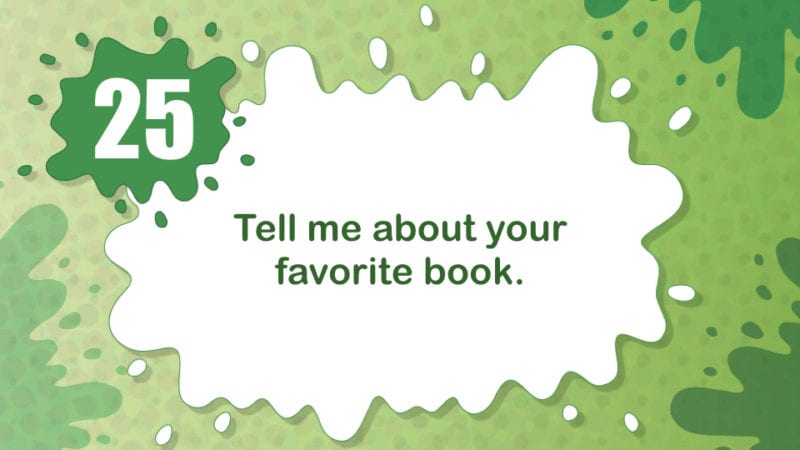
Get My Kindergarten Writing Prompts
Love these kindergarten writing prompts? Make sure to check out our kindergarten jokes to start the day !
You might also like.
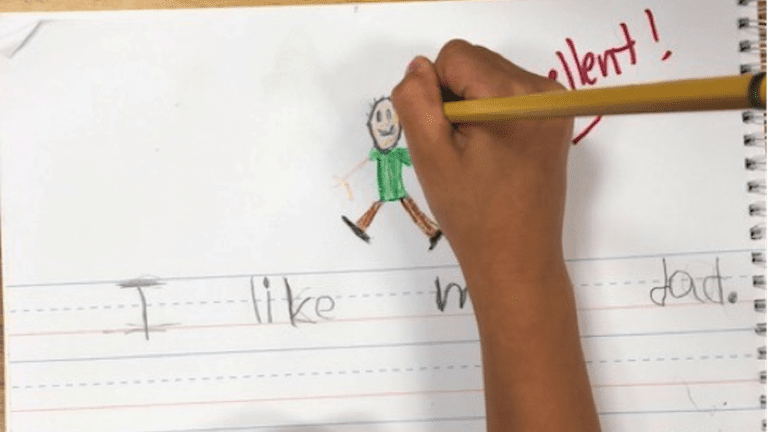
10 Tricks for Teaching Writing in Kindergarten
Lessons I've learned from years of teaching five year olds. Continue Reading
Copyright © 2023. All rights reserved. 5335 Gate Parkway, Jacksonville, FL 32256

How to Teach Narrative Writing
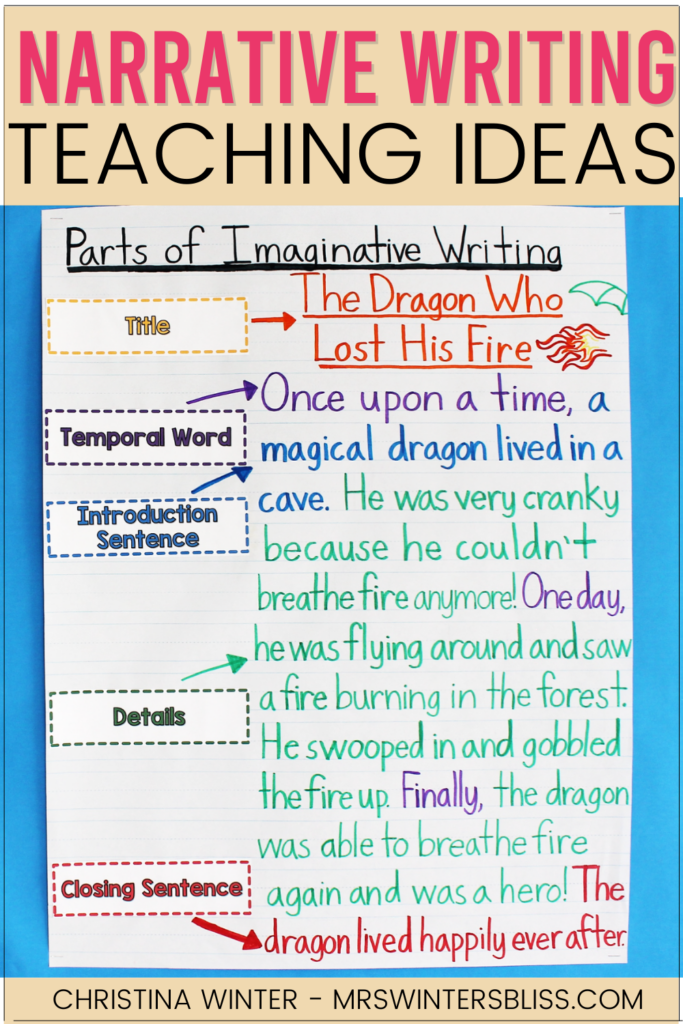
In this post, I share 5 tips for How to Teach Narrative Writing and provide details about the Narrative Writing Units I have created for Kindergarten, 1st and 2nd grade students. Be sure to download 3 FREE narrative writing graphic organizers !
As teachers we spend a tremendous amount of time teaching our students to write. And for good reason! The ability to clearly express one’s thoughts in writing is an essential academic and life-skill. Study after study has shown that students who are able to master writing skills early on struggle less in overall literacy and communication .
The Common Core writing domain focuses on three big types of writing: informative, opinion and narrative writing. Each genre serves a unique purpose and follows a specific structure which we must explicitly teach our students.
In earlier posts I shared tips and resources for teaching Informative Writing and Opinion Writing . Today I’m excited to move on to the final genre, Narrative Writing.
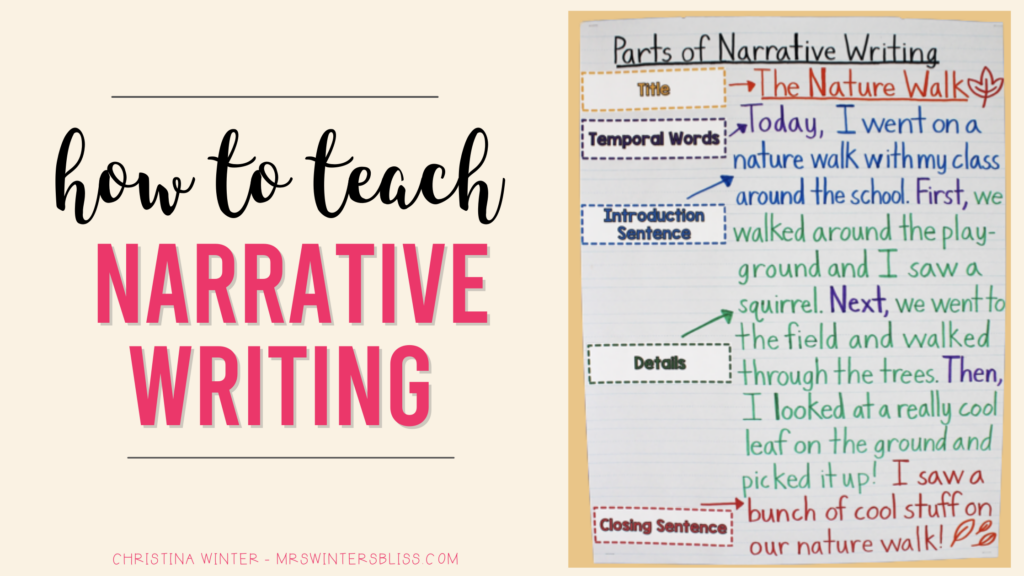
I love to teach narrative writing. Personal narratives are a great genre to start the year with because they allow you to get to know your students a little bit better. Most kids love to tell us stories about their lives, so writing personal narratives often comes naturally to them.
Imaginative narratives, on the other hand, allow students’ creativity to shine! Many students find it very motivating and engaging to be allowed to write the stories they create in their own mind.
Today I’m sharing 5 tips for teaching narrative writing, as well as details about my narrative writing resource. It is a writing unit that has everything you need to bring narrative writing into your kindergarten , first grade, or secon d grade literacy centers!
Tips for Teaching Narrative Writing
1. read narrative writing mentor texts .
Before you can ask your students to write in a genre that is new to them, you must first immerse them in it. So to begin your unit, you’ll want to share examples of narrative writing with your students. These mentor texts provide students with examples of excellent narrative writing.
As you read them aloud, highlight the way the author structures their writing. Identify the author’s purpose, the topic, the order of the events, and how the author felt. All of these things will help students better understand what type of writing we are asking them to do.
When you’re picking narrative mentor texts to share with your students there are a few things to consider . First, do you (the educator) think it is excellent? Second, is it easy for your students to understand? And finally, is it relevant to the type of writing you are teaching? If you answer “Yes!” to all three, then you’re good to go!
To help you out I’ve created a list of excellent mentor texts you can use when teaching narrative writing to kindergarten, first, or second grade students.
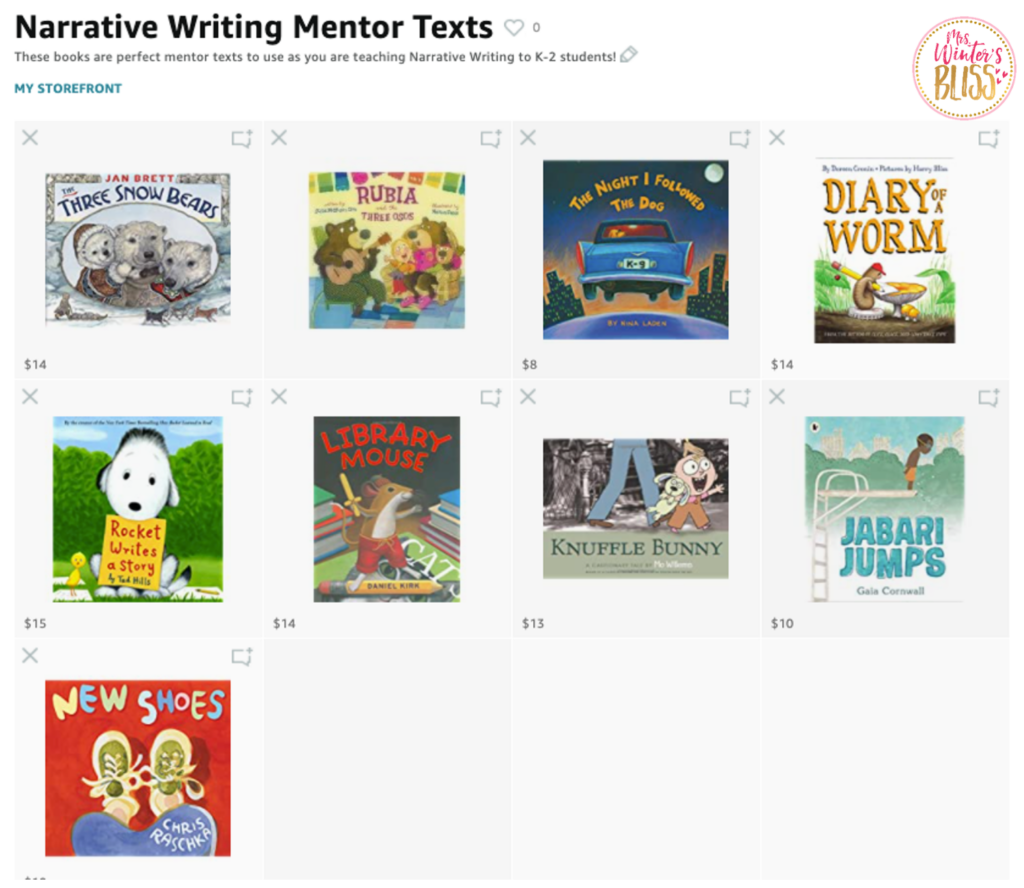
A List of Narrative Writing Mentor Texts:
- New Shoes – Chris Raschka
- Jabari Jumps – Gaia Cornwall
- Knuffle Bunny: A Cautionary Tale – Mo Willems
- Library Mouse – Daniel Kirk
- Rocket Writes a Story – Tad Hills
- Diary of a Worm – Doreen Cronin
- The Night I Followed My Dog – Nina Laden
- Rubia and the Three Osos – Susan Middleton Elya
- The Three Snow Bears – Jan Brett
I’ve saved all these titles on one board so you can easily take a closer look at these mentor texts. Click here to see this list on Amazon .
2. Model Your Own Narrative Writing
When modeling your own narrative writing I suggest you use an experience you’ve shared as a class. It could be as simple as a short nature walk outside the school building, a field trip you went on, or a class celebration you had. Show your students that narratives don’t have to be about big events. Small moments, like a walk outside, can be stretched out and turned into a great narrative writing piece!
Next, model how you plan your writing using a graphic organizer. Highlight how you have a topic, use temporal words to order your events, details and a closing sentence. Don’t be afraid to put the events out of order! Let the students catch the mistake and help you fix it!
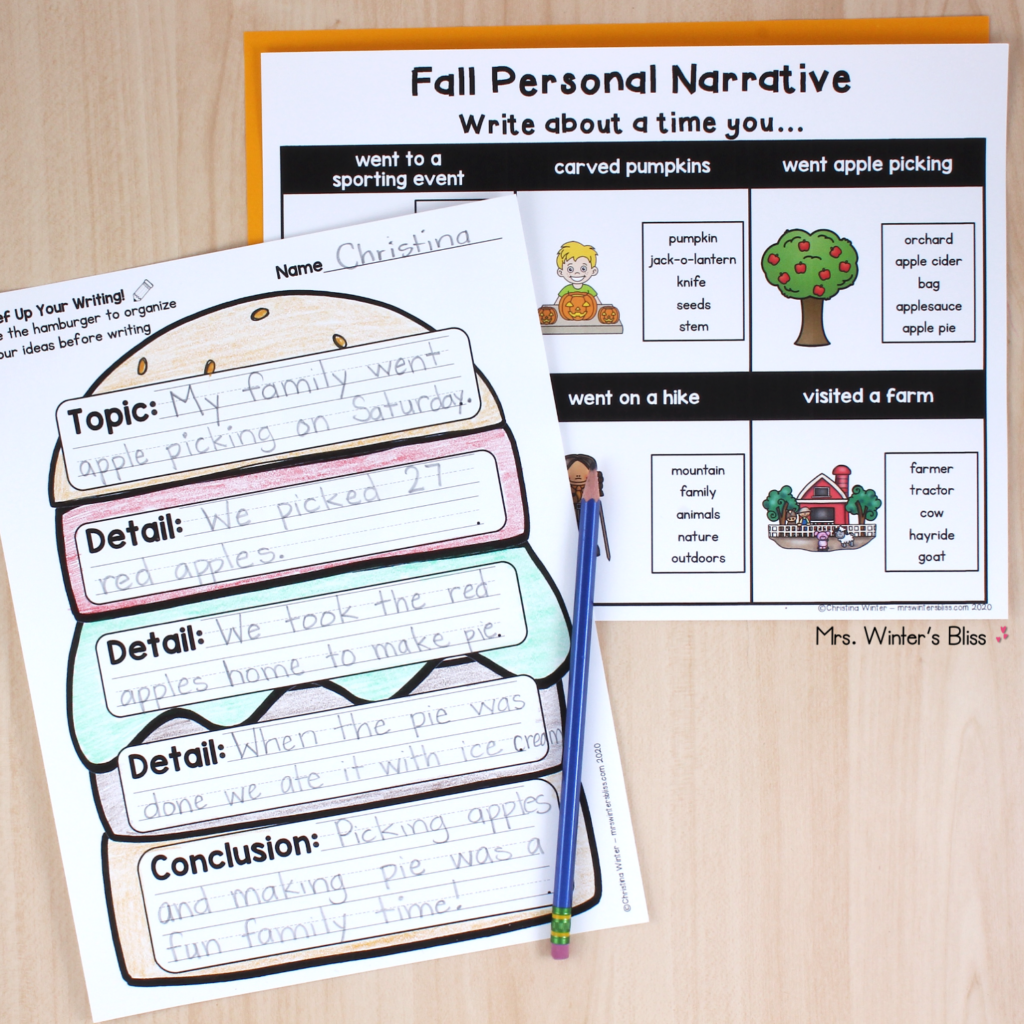
Model how you use the graphic organizer to guide you as you write out your full piece.
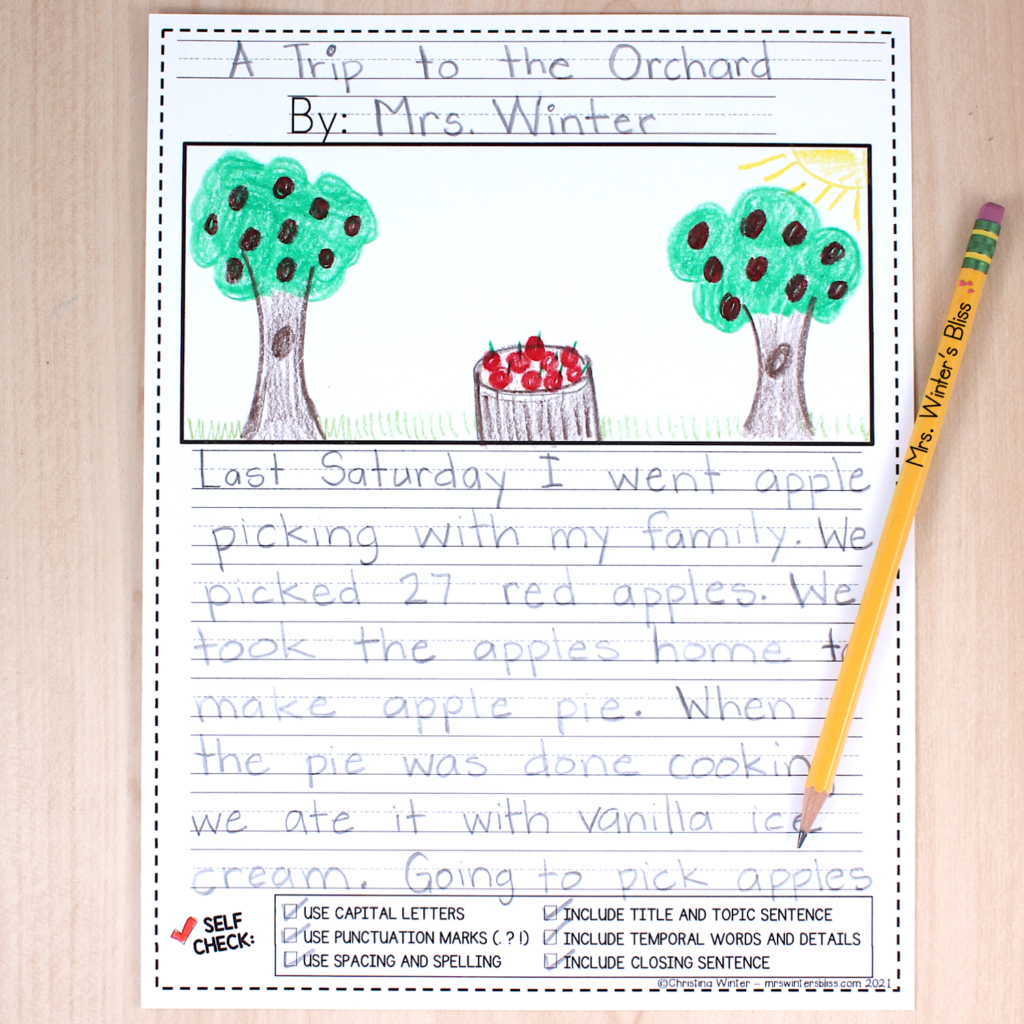
Finally, reread your work aloud to ensure it makes sense and that the events are in the correct order. Check for any silly mistakes and come up with a fitting title!
3. Use Anchor Charts
You want your students to know that when they write a narrative piece they are writing a story to entertain the reader. It can be a true, personal story from their life, or an imagined fictional one. Creating an anchor chart with this information helps to remind students their purpose for writing.
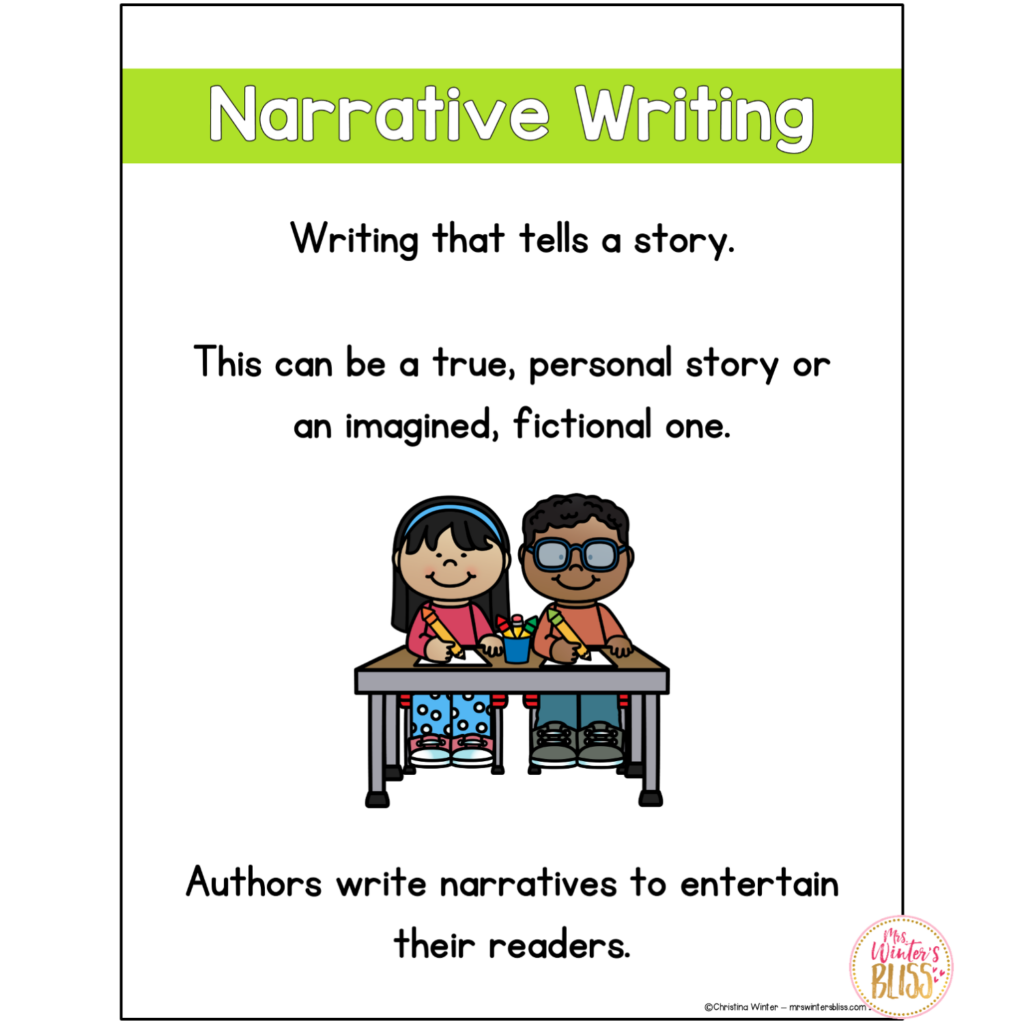
Create a second anchor chart that reviews temporal words. Words such as yesterday, today, first, next, or last describe time or order of events and help make a narrative story more clear for the reader.
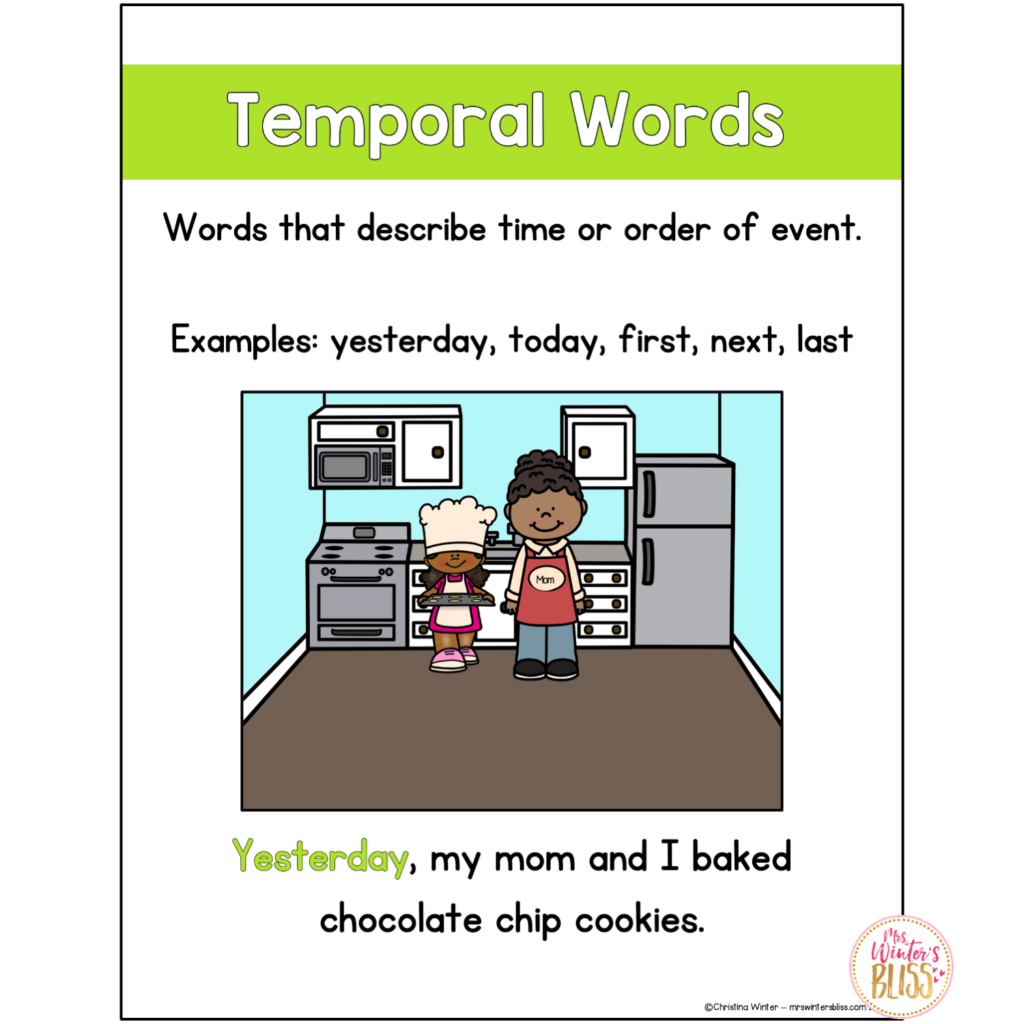
When writing fictional narratives, an anchor chart of fictional sentence starters can help students to get ideas for a story.

Finally, you’ll want to create an anchor chart using the writing you model. This will serve as another example of excellent narrative writing. As a class, add labels to identify the title, the topic, temporal words, details, and the closing sentence in your shared writing.
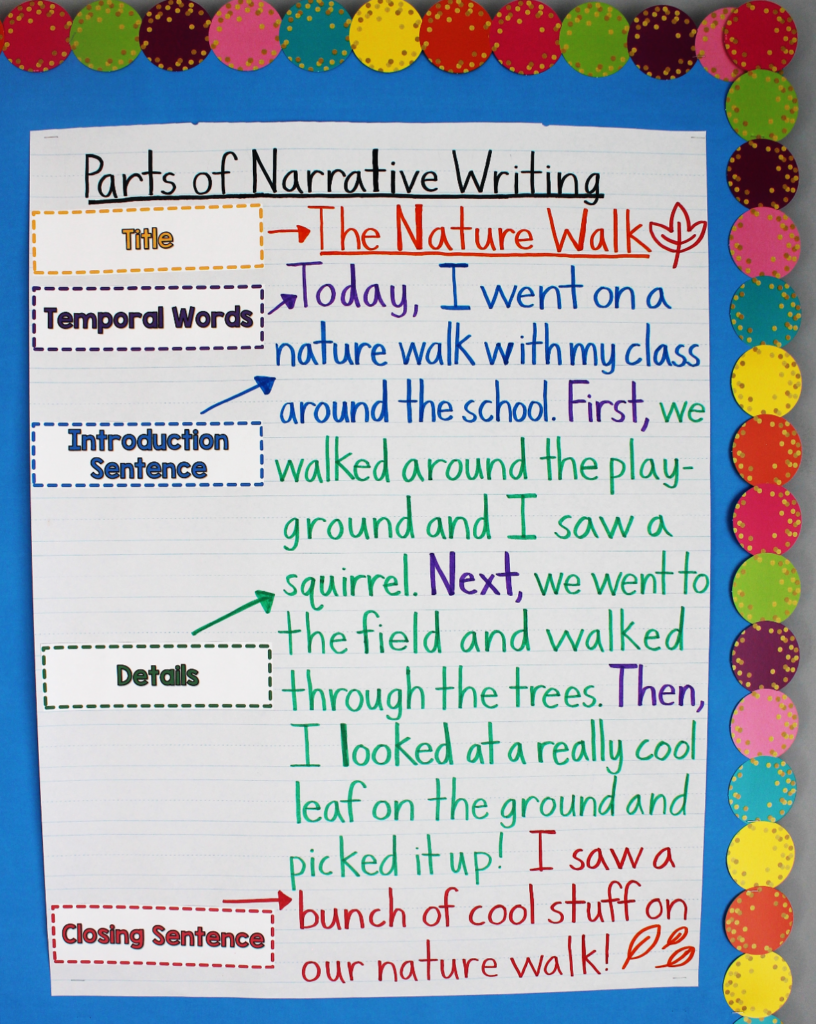
All of these anchor charts can be posted in your writing center. Encourage your students to refer back to them and use them as support as they write their own pieces.
4. Allow students to edit and share their writing
Provide a good writers checklist at your writing center. For narrative writing you’ll want the checklist to include items such, “Does my writing have a title?” “Is there a clear beginning, middle, and end?” “Did I use temporal words?” as well as reminders to check for spelling, capitalization, and punctuation errors.
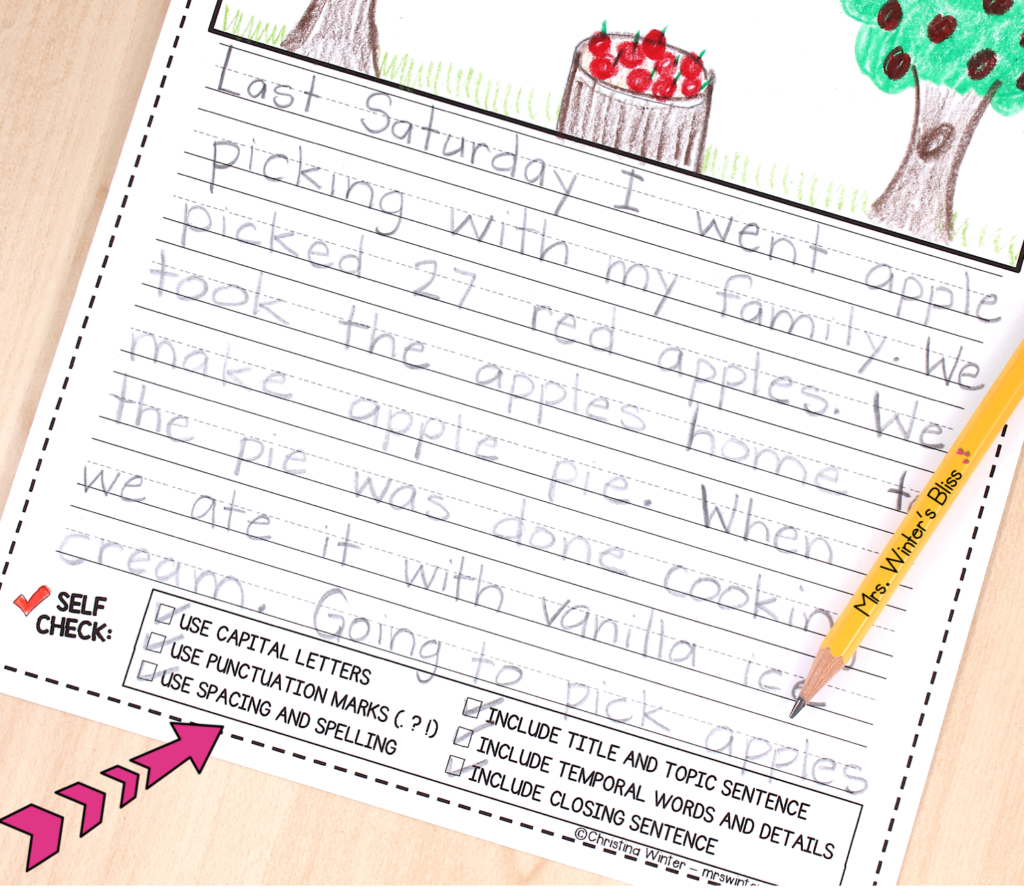
You can also create a rubric specific to the genre. Model how you use it to assess your own work and how it can be used to provide feedback to others.
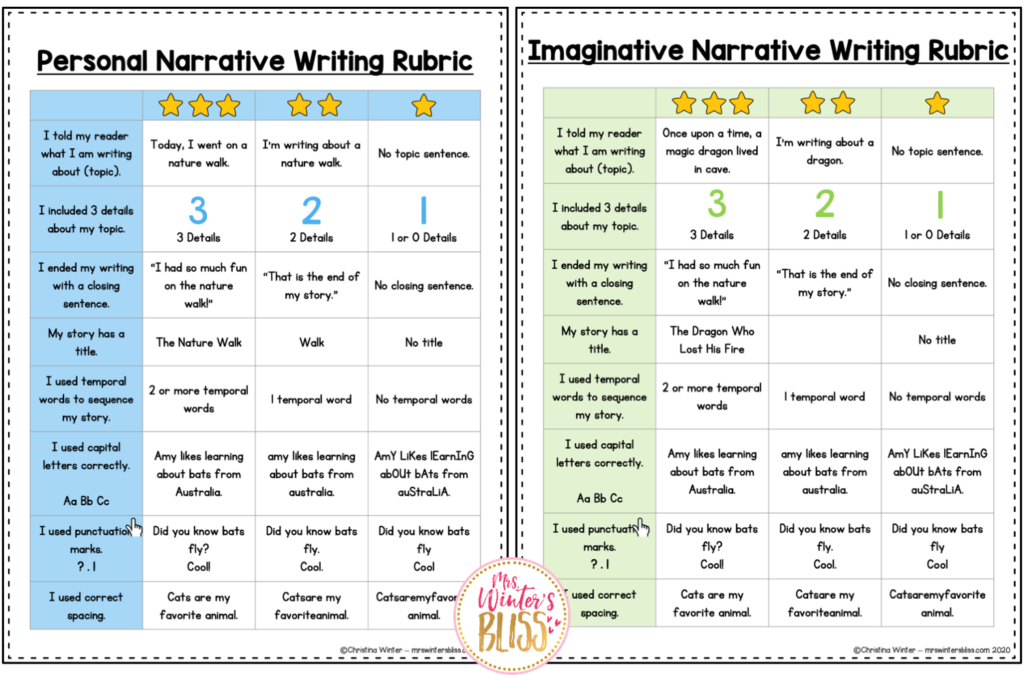
Give students the opportunity to share their writing with others! Pair students with partners and let them read their pieces to each other. Encourage them to provide feedback using the editing checklist and the rubric as a guide.
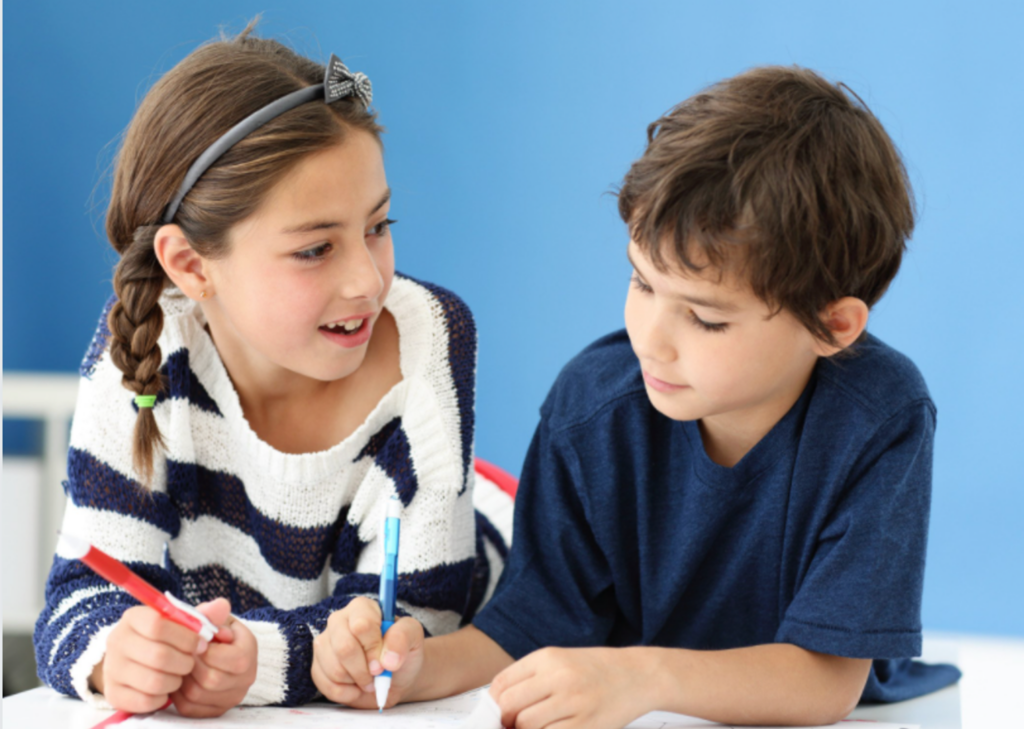
5. Provide Daily Opportunities for Students to Write
As with all things, writing takes PRACTICE! Students need dedicated instructional time to learn the skills and strategies necessary to become effective writers, as well as time to practice what they learn.
When you think about your daily instructional schedule, make sure you are giving your students ample opportunities to practice their narrative writing through whole group instruction, small groups, and/or through independent practice in writing centers.
Narrative Writing Units For Kindergarten, First, and Second Grade Students
Today I’m excited to share with you the details about my Kindergarten Narrative , 1st Grade Narrative , and my 2nd grade Narrative writing units! I love them because they have ALL the resources you need to give your students the practice needed to master narrative writing.
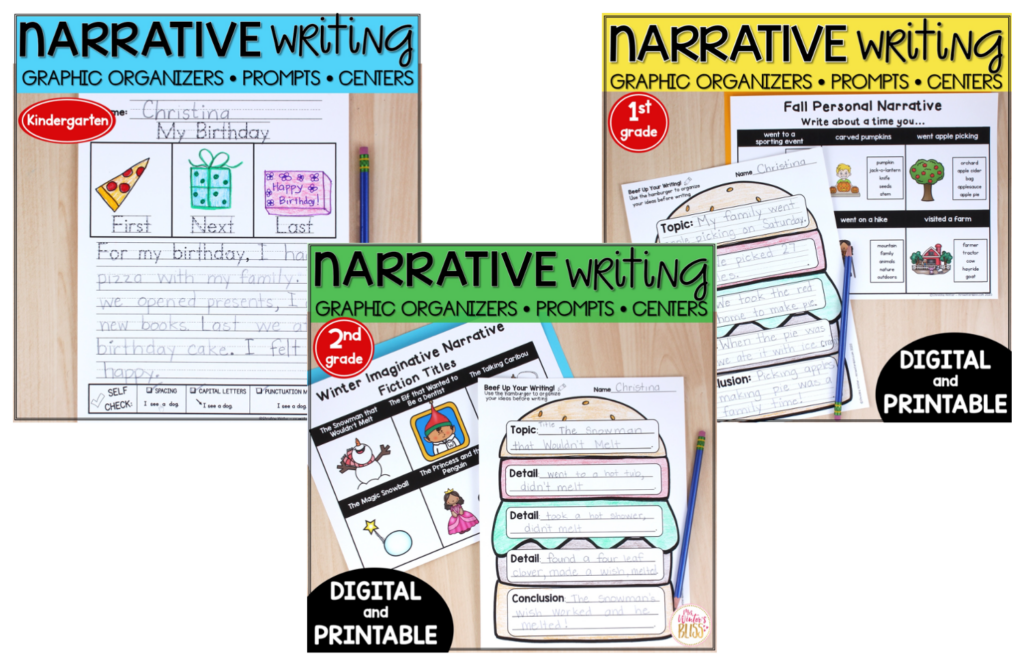
These narrative writing units were developed with standards-based research specific to each grade. You can use them within whole class or small group lessons, or as a literacy center activity where students can practice narrative writing independently!
Let’s take a closer look at each one….
Kindergarten Narrative Writing Unit
The kindergarten resource has everything you need to incorporate narrative writing into your literacy centers all year long!
To help your students better understand the genre you’ll get two mini-lessons , one on personal narratives and the other for imaginative narratives. I recommend focusing on personal narratives at the start of the year and moving onto imaginative narratives in the second semester.
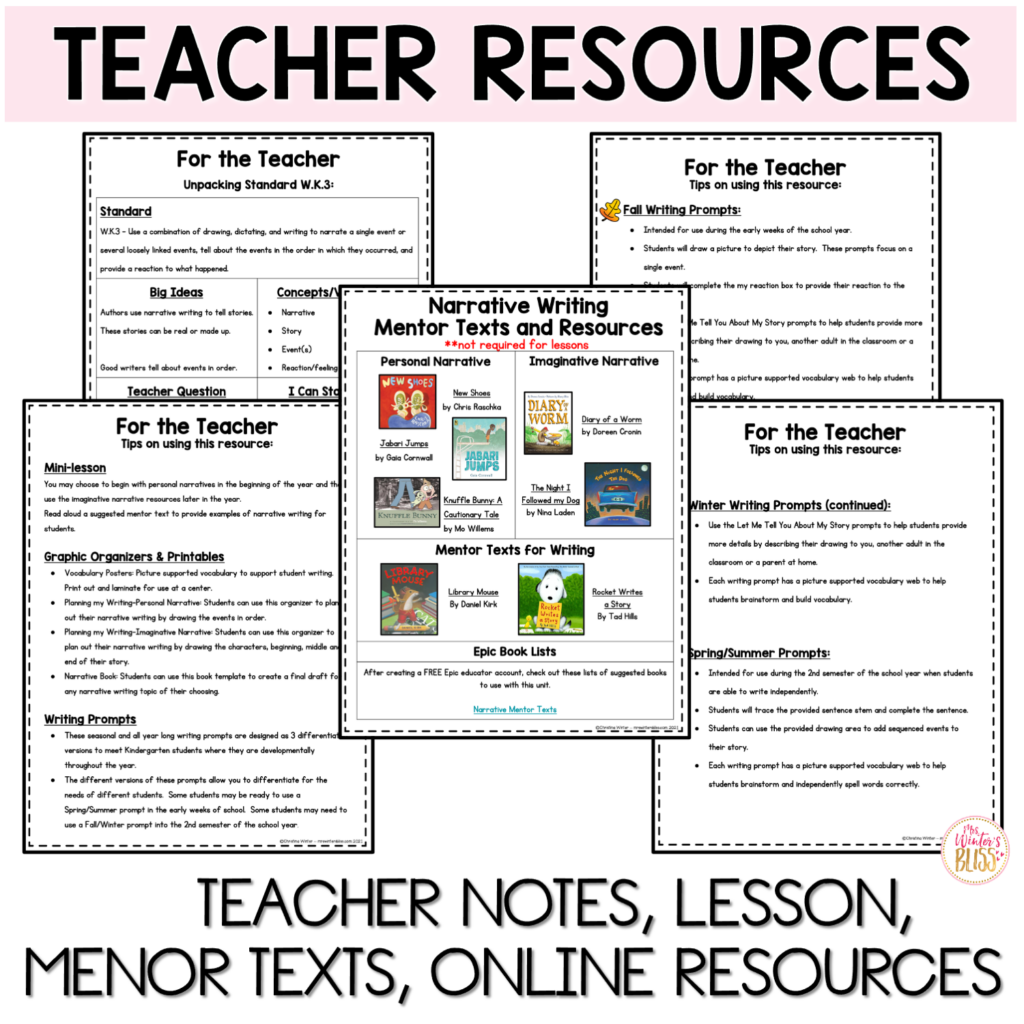
You’ll also get a list of suggested mentor texts and online resources, academic vocabulary posters, printable anchor charts, graphic organizers and differentiated writing prompts.
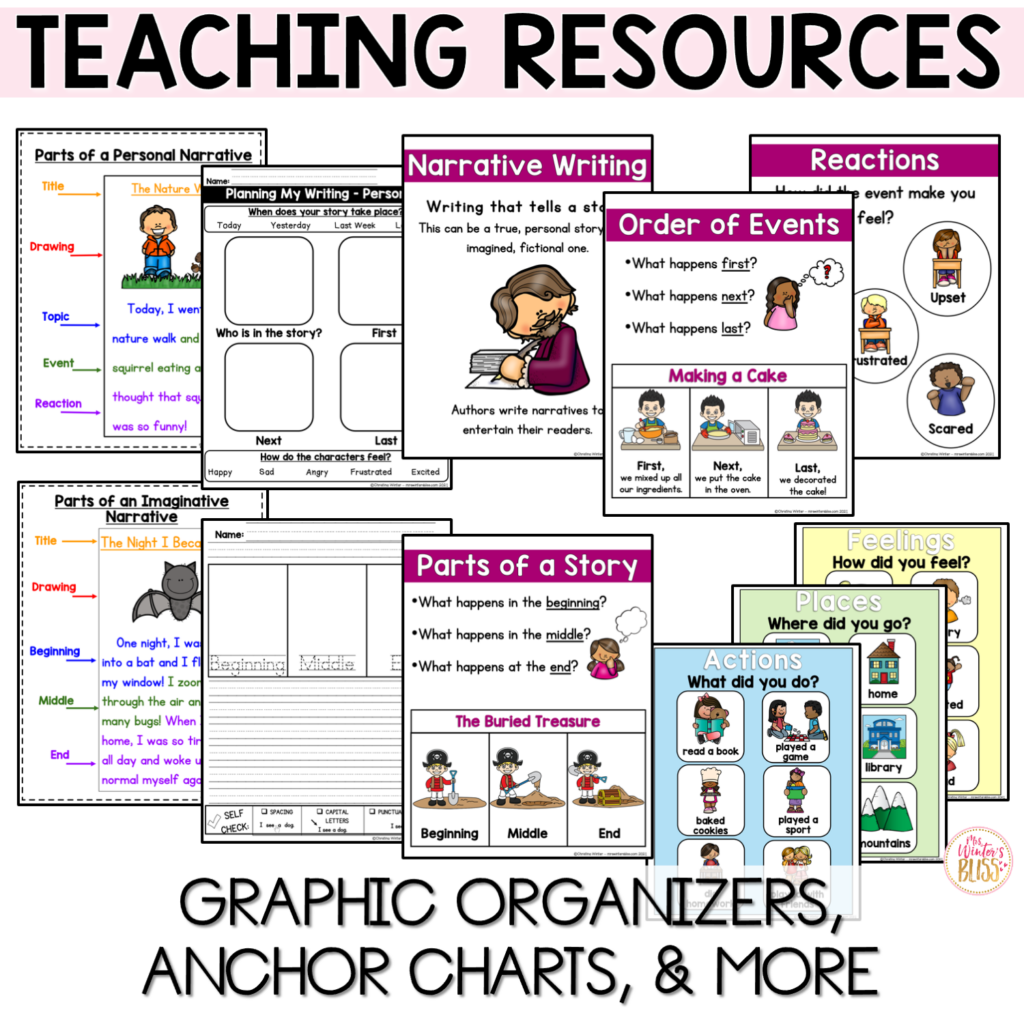
These seasonal and all-year-long writing prompts come in 3 differentiated versions to meet your Kindergarteners where they are developmentally throughout the year. Each writing prompt comes with a vocabulary word web to assist young writers in brainstorming ideas and spelling words while writing.
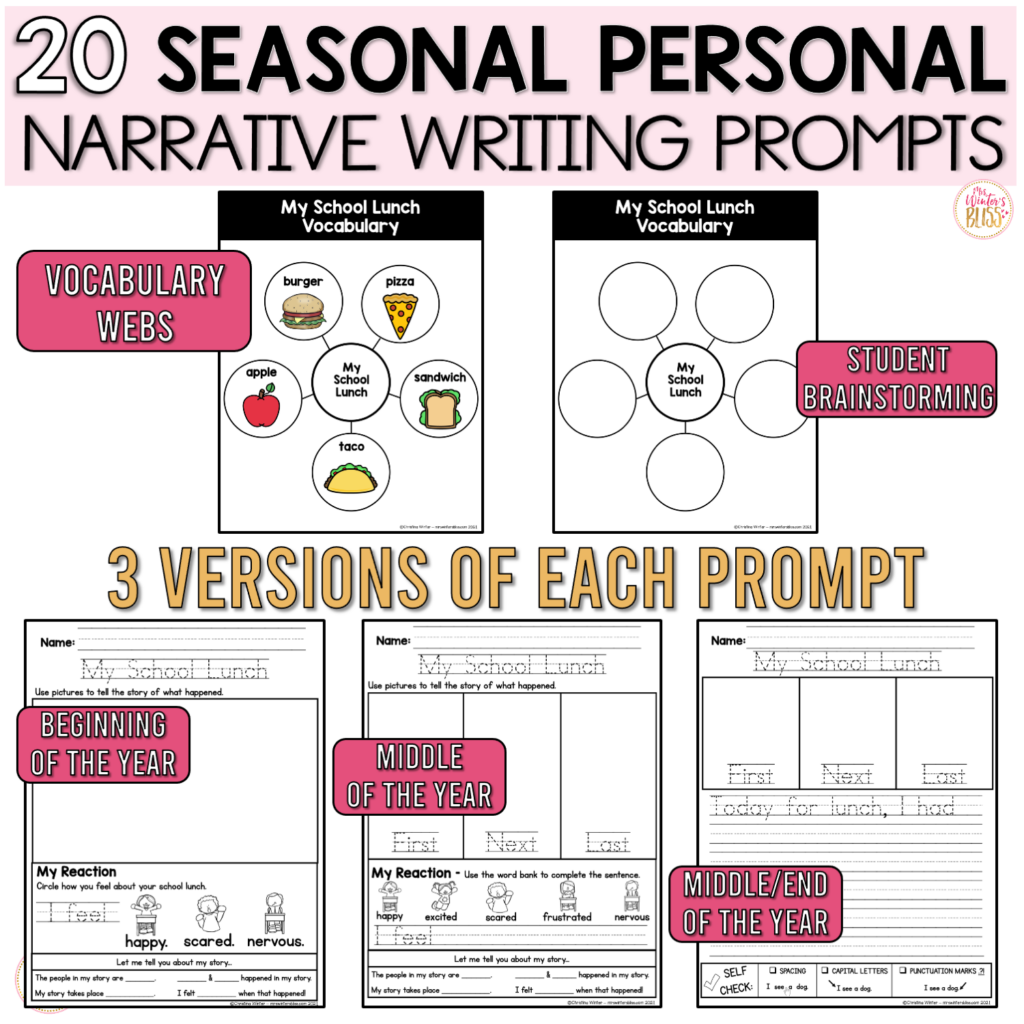
Finally, you’ll get a narrative writing editing checklist appropriate for the kindergarten level.
First Grade and Second Grade Narrative Writing Units
The first and second grade resources were designed with standards-based research specific to grade. You’ll get a personal narrative mini-lesson and imaginative narrative mini-lesson to use as a review of the genre. You’ll also get a list of suggested mentor texts and online resources, academic vocabulary posters, anchor charts, graphic organizers and seasonal writing prompts!
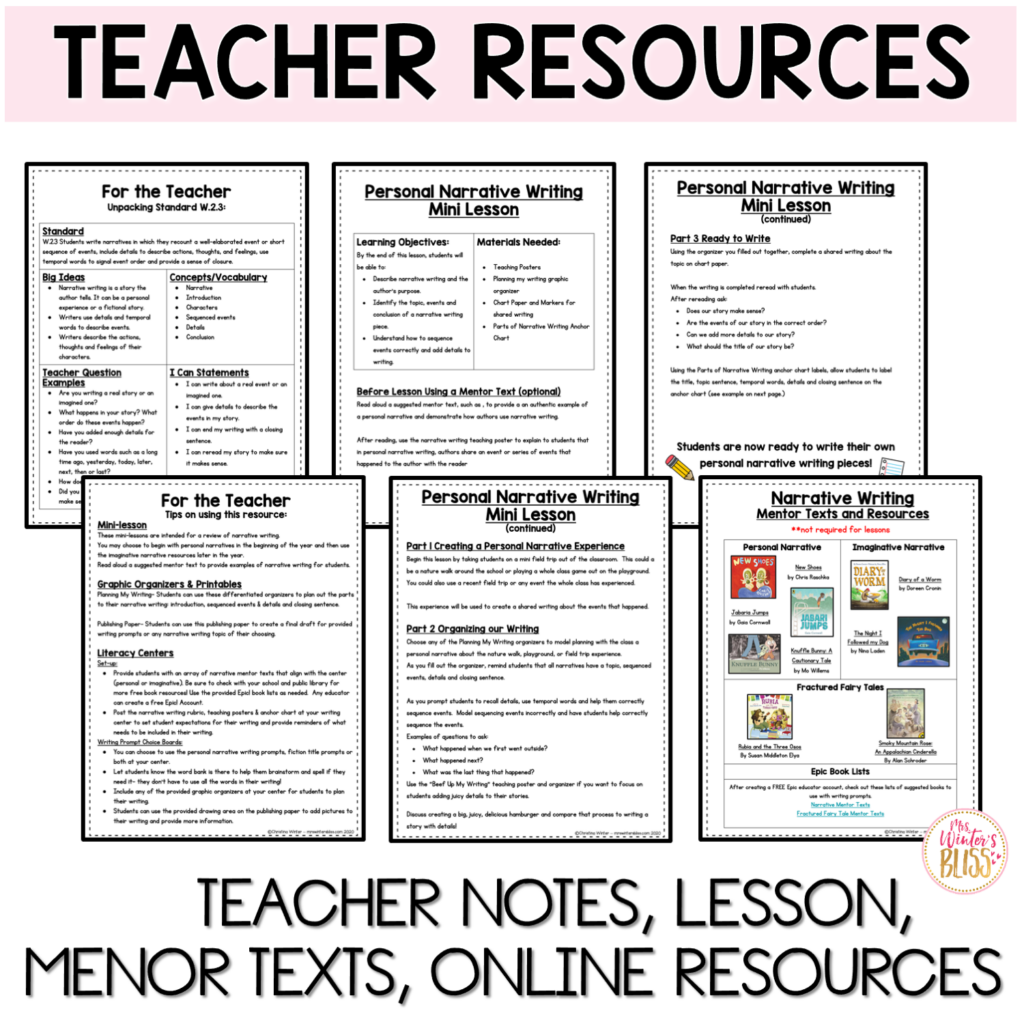
You won’t hear students say, “I don’t know what to write about!” when they are using this resource! The seasonal writing prompts include choice boards for personal narratives and imaginative narratives, as well as sentence starters and vocabulary banks to assist in brainstorming ideas and spelling words while writing.
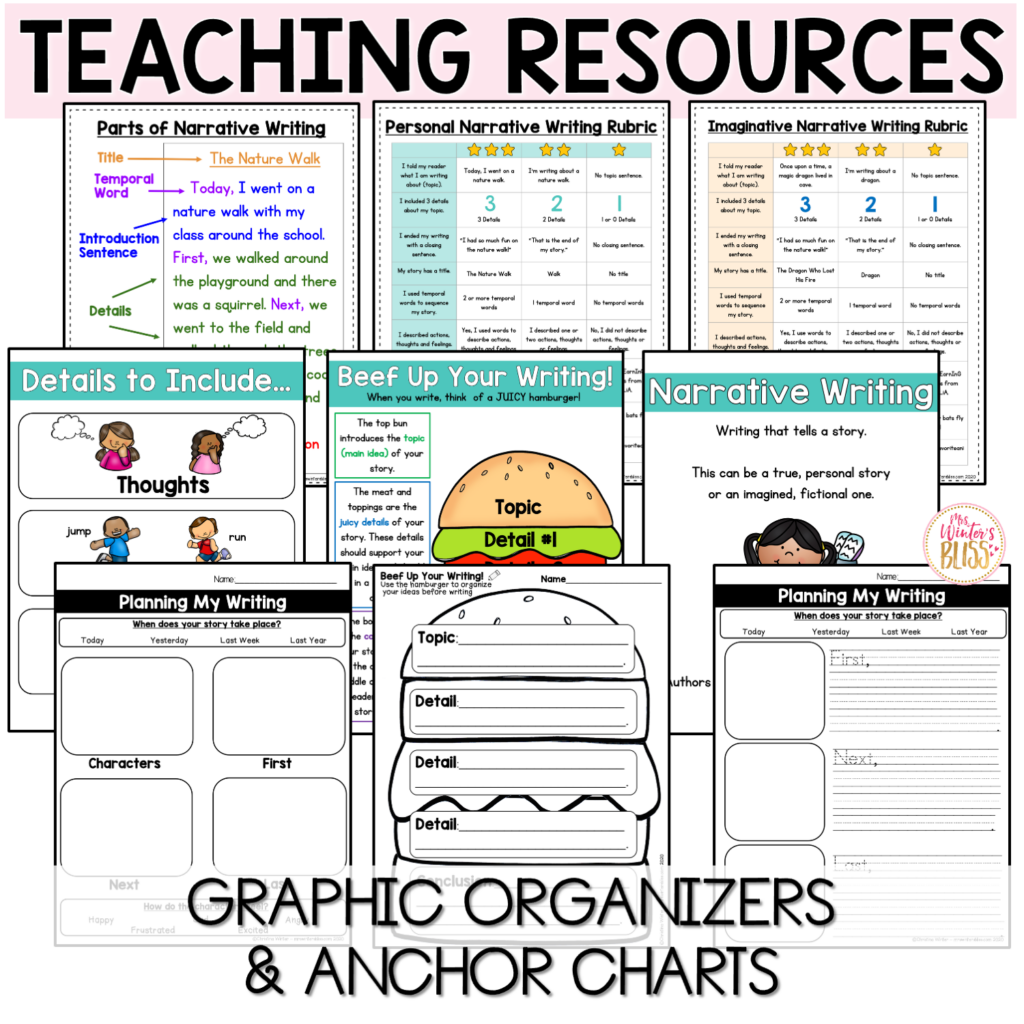
The personal narrative and imaginative narrative seasonal prompts are both PRINTABLE & DIGITAL. The digital version has been PRELOADED for you, with 1 click add them to your Google Drive or upload them to SeeSaw.
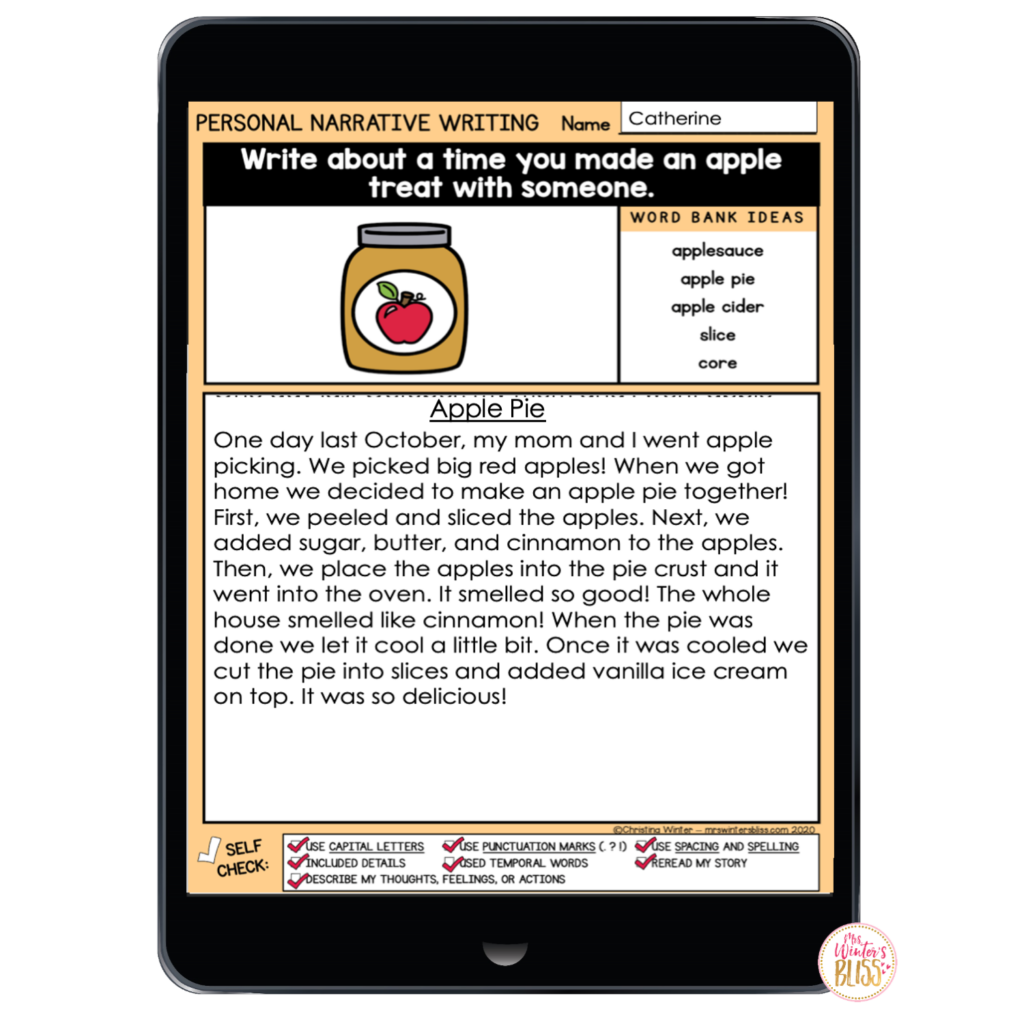
Finally, you’ll get self-editing checklists and rubrics for both personal and imaginative narrative writing. The rubric makes a great self-assessment tool and can be used as a guide for peer feedback.
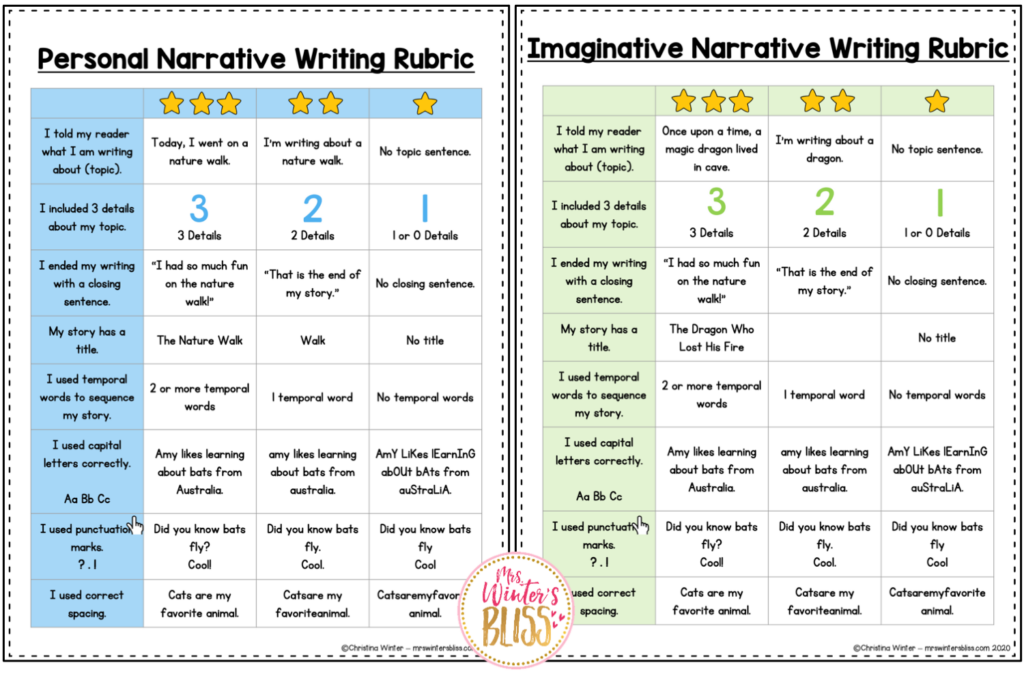
I love these resources because they can be used in so many different ways. They offer opportunities for students to practice both personal and imaginative narrative writing as a whole class, in small groups, as a literacy center activity, for homework, or as a meaningful activity for when they have a substitute teacher!
FREE Narrative Writing Graphic Organizers
Are you ready to begin teaching Narrative Writing in your classroom? To help get you started, I am happy to offer you 3 FREE narrative writing graphic organizers! You can download them here.
Writing is an essential skill that benefits students well beyond the walls of our classrooms. As teachers, we work hard to plan engaging activities that we hope will build our students’ confidence and help them to develop a lifelong love of writing.
I hope the information and resources I’ve shared on narrative, opinion and informative writing will help to bring stronger instruction and more meaningful writing practice to your kindergarten, first and second grade classrooms!
-shop this post-
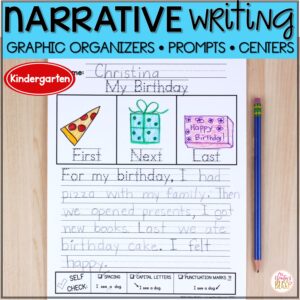
– PIN for LATER –
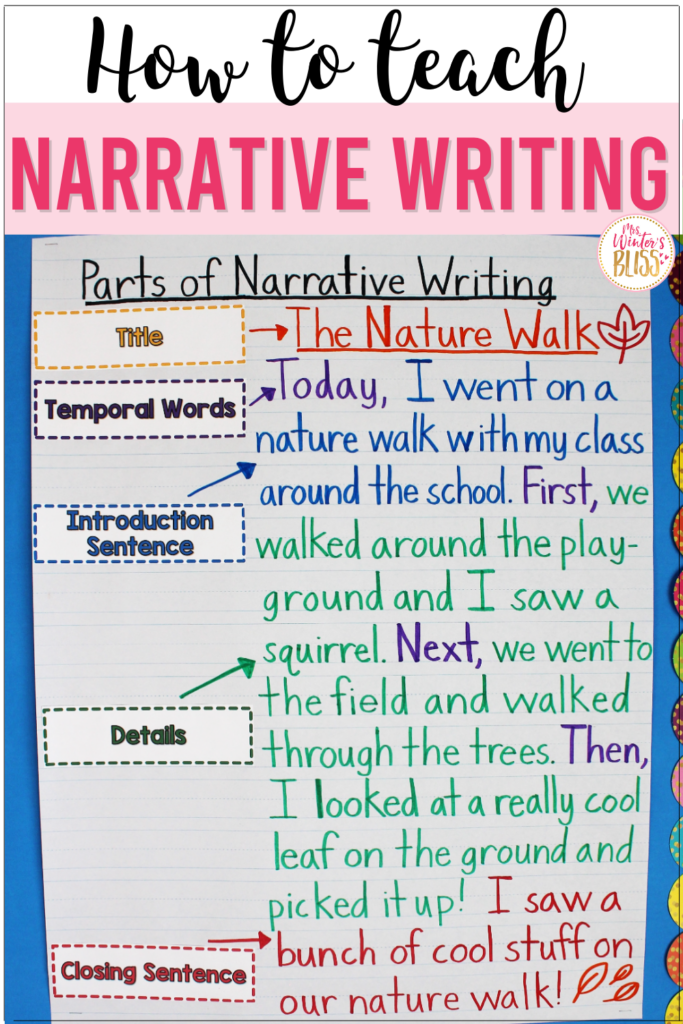
FIND WHAT YOU NEED
Teaching resources.

BLISS IN YOUR INBOX
COPYRIGHT © 2024 · TERMS AND CONDITIONS

IMAGES
VIDEO
COMMENTS
Step 3. Write a First Draft. Once my students have labeled their pictures, I model how to write a first draft. I model looking at my picture and label and them using it to write a sentence. When we read narrative writing and create our anchor chart, we talk about using transition words like first, next, and last.
Kindergarten Writing Curriculum Scope: There are a total of 7 units included in this comprehensive writing curriculum: Unit 1: Personal Narrative: Sharing My Story. Unit 2: Non-Realistic Fiction: Using our Imagination. Unit 3: Writing to Teach and Inform: How-to-Books. Unit 4: Poetry: Exploring Poetry. Unit 5: Realistic-Fiction: Writing ...
Planning a writing unit of work can be quite overwhelming, particularly as a beginning teacher. I'm here to help you create engaging, effective lesson plans and narrative writing units for your young writers. These tips will be most appropriate for Kindergarten students or Grade 1/2 students, but could also be adapted for older children too! I'll also share a range of quality mentor texts and ...
First Grade Goals and Awards FREEBIE. I Can Statements, First GradeMichalaNovember 10, 2018goals, awards, first grade, I can statements. [email protected]. Hours. PRIMARY WRITING - UNIT 3 I am so excited to teach this narrative writing unit! This writing curriculum is geared for kindergarten, first grade and can even be used in ...
KinderWriting is based upon nine units: Writing With Pictures, Writing With Sentences, Writing With Stories, Writing With Narrative, Writing With Opinion, Writing With Direction, Writing With Persuasion, Writing With Imagination, and Writing With Information. Each unit is broken down to 20 lessons. The units cover 20 days of academic instruction.
1. Tell about your favorite stuffy. 2. Make a list of 3 things you like and 3 things you don’t like. 3. What is your favorite thing to do on a rainy day? 4. I’m really good at …. 5.
Tips for Teaching Narrative Writing. 1. Read Narrative Writing Mentor Texts. Before you can ask your students to write in a genre that is new to them, you must first immerse them in it. So to begin your unit, you’ll want to share examples of narrative writing with your students.
Download this FREE resource, "Narrative Writing Lessons for K-2," and get 10 writing lessons for each grade level - Kindergarten, first grade, and second grade. This freebie is packed with lesson plans, graphic organizers, posters, and independent writing activities!
This child has not completely developed a concept of word, words needing to be separated in the sentence (‘raining outside’ is combined). The teacher could provide short lines for the separation of words or the student could underline each word as she sounds it out and writes it. This child may be ready to add more sentences to her writing.
Looking at Writing. Looking at Writing: Kindergarten. Kindergarteners are often enthusiastic writers and they will weave writing activities into their play. Provide budding writers with experiences that give them something to write about. Invented spelling is normal at this age, as children are translating the sounds of spoken words into writing.